 Of the coast of Helsinki, on the island of Kuivasaari (“Dry Island”), the Kuivasaari Coastal Artillery Fortress stands. Until not to long ago, Kuivasaari was a working coastal artillery fortress guarding the approaches to the capital city of Finland but the guns have now been removed from active service and the fortress is no longer permanently occupied. It is is still used by Finland’s Defence Forces however, and is therefore closed to general use. Charter cruises to the island are however run by several companies.
Of the coast of Helsinki, on the island of Kuivasaari (“Dry Island”), the Kuivasaari Coastal Artillery Fortress stands. Until not to long ago, Kuivasaari was a working coastal artillery fortress guarding the approaches to the capital city of Finland but the guns have now been removed from active service and the fortress is no longer permanently occupied. It is is still used by Finland’s Defence Forces however, and is therefore closed to general use. Charter cruises to the island are however run by several companies.
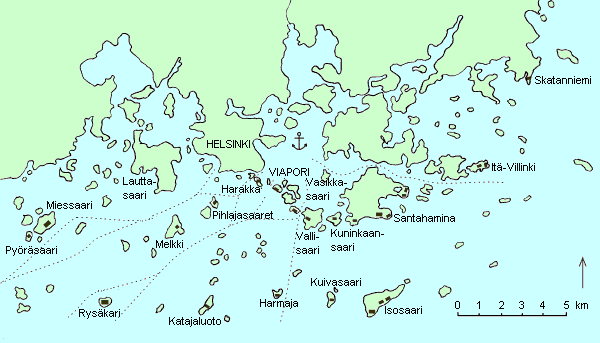
The Coastal Artillery Fortresses guarding Helsinki at the time of independance
Besides being a former coastal artillery fortress, Kuvasaari Coastal Artillery Fortress is also now a museum housing a refurbished and restored 12-inch (305mm) double Obukhov gun turret as well as Finland’s only remaining 10-inch Durlacher-cannon – (which is now “back home”, as Kuivasaari’s original weaponry when established by the Tsarist Russian military was 4 x 254mm / 10 inch 45 caliber Durlacher guns) as well as a significant collection of other old historic coastal artillery guns used in the past in Finland’s coastal artillery defences.
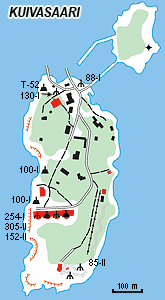
Map of Kuivasaari
The old Obukhov twin 12 inch gun had been allowed to stand inactive but in place for almost 20 years until the end of 1989 when the then Commander of Finland’s Suomenlinna Coastal Regiment proposed the restoration of the old Kuivasaari guns. A management and technology team was established under the Guild’s leadership and immediately started both the collection of funds and the promotion of the restoration project in 1990. In the summer of 1991 restoration work began, which included the restoration of both the elderly guns and refurbishment of the surrounding casemate and structures.The rehabilitation work was carried out by Finland’s Suomenlinna Coastal Artillery Guild and its active “gunners”.
The museum was completed and after countless hours of voluntary work, a 12-inch cannon fired a so-called water shot at the end of 1992. The test firing was as expected, successful and so the Kuivasaari Coastal Artillery Fortress fired shots on 6 December 1992 in honor of Finland’s 75th anniversary of independence. On the 6th of December 1997 the guns of Kuivasaari “talked” once again in honor of Finland’s 80th anniversary of independence and again, on 6th December, 2002, shots were again fired to celebrate the 85th anniversary of Finland’s Independence. So-called “Water shots” fire a polystyrene tube injected with 500kg of water. In this way the gun functions entirely normally while shooting but without the security difficulties inherent in firing a live round.
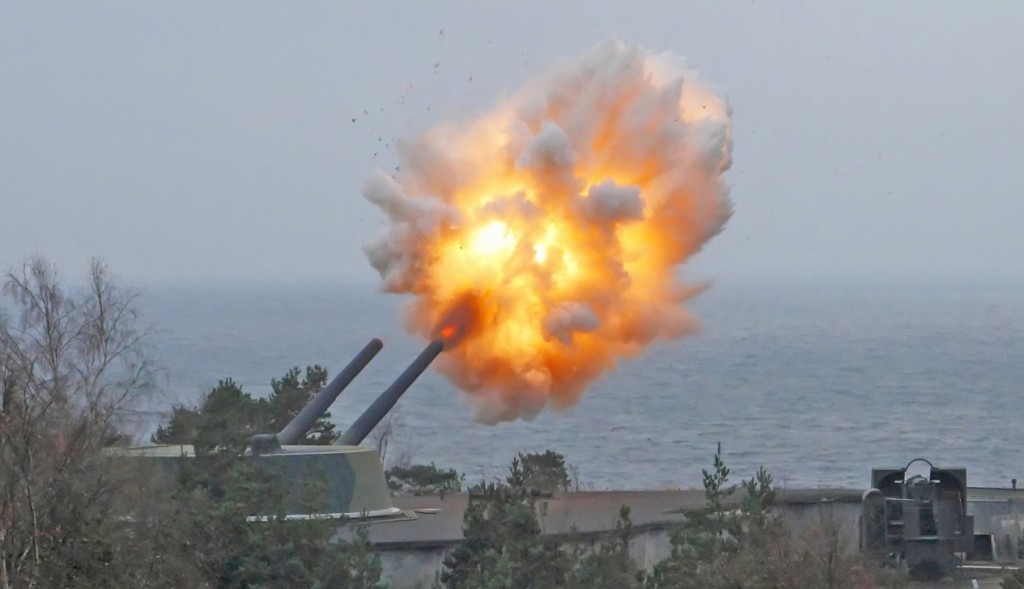
The Kuivasaari 305mm (12″) gun firing, 4 December 2012
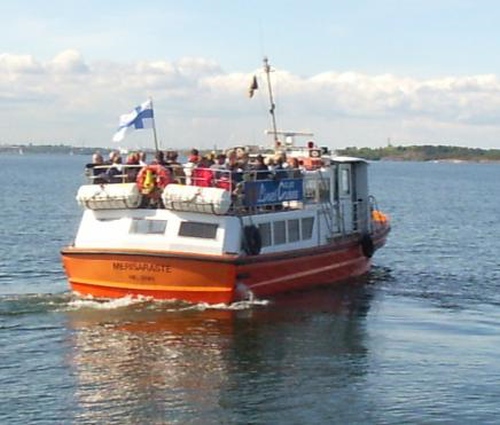
In Summer 2015, IHA Lines in association with the Coastal Artillery Guild ran a small number of Guided Tours to Kuivasaari
Visiting Kuivasaari Coastal Artillery Fortress is possible but permission is required and opportunities are rare as the island continues to be a military zone. In the summer of 2015, IHA Lines Oy Helsinki Cruises did run a number of authorized excursions to Kuivasaari (see this link for details). Note that the website is in Finnish but google translate seems to do the job adequately. In 2015, trips were run on 3 weekends. Finns intending to visit need photo identification (driver’s license for example) while foreigners will need a Passport. The total duration of the trip was given as three and a half hours, of which about two and a half hours is spent on the island. Finnish citizens may also arrange private group visits at a separately agreed time. Visits are organized by IHA Lines Oy in conjunction with the Suomenlinna Coastal Artillery Guild Association. Booking in advance is definitely recommended. If you’re looking to find out if further excursions are going to be available, I’d suggest emailing IHA Lines Oy and asking. The Coastal Artillery Guild might also be worth asking.
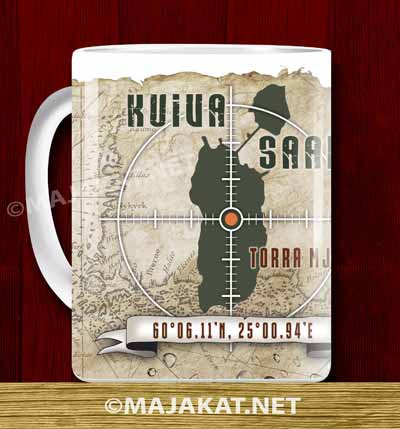
And such are the popularity of these coastal artillery fortresses than you can even buy a souvenir mug… http://www.majakat.net/sotilassaari-mukit/tuotteet/vallisaari-muki13
For the Summer 2015 trips, the cost was €30 for adults and €10 for children 5-16 years. You will need your ID to board, as well as wearing clothes suitable to the location and weather (Kuivasaari is an outer island on the sea approaches to Helsinki and good windproof clothing is recommended) as well as shoes suitable for outdoor activity. Photography is permitted – it’s definitely recommended that you bring a camera. Please note that prams / strollers for young children are NOT recommended. Some of the terrain on the island is unsuitable and space on the boat is somewhat limited. Proceeds from the excursions are used in full for the maintenance and development of the Kuivasaari coastal artillery fortress museum. The trip is guided, and you’ll have the opportunity to see a unique part of Finland’s military history, including a guided tour of the interior of the massive 12-inch dual-gun turret and communal areas, as well as other museum guns.
Another Helsinki sightseeing Line that runs trips to Kuivasaari is the Royal Line, although these are Charter Trips only, where you need to hire the entire boat. Royal Lines has three boats that operate to Kuivasaari – the m/s Princess (suitable for 10-20 persons), the m/s Katarina (suitable for 20-50 persons) and the m/s RoyalCat (suitable for 30-65 persons). The boat ride from the Helsinki Market Square to Kuivasaari takes approximately 1-1.5 hours one way.The total duration of the excursion is 5 hours (3 hours for the boat ride both ways and 2 hours for a guided walking tour of the Kuivasaari Coastal Artillery Fortress). Only private chartered cruises are available. There are no regular departures. The minimum number of passengers is 10 persons.

Royal Line Helsinki
However, as IHA Lines operate only a very limited number of trips during the summer, Royal Lines could well be your best option if, as a group of 10 or more, you are interested in visiting the Kuivasaari Coastal Artillery Fortress and Museum. The Royal Line (http://www.royalline.fi/articles/290/) has been in the sightseeing business around Helsinki for 70 years and may be worth contacting if you’re interested in visiting Kuivasaari. (http://www.royalline.fi/gallery/91/) as a group. When I contacted Royal Lines for information for this article they were extremely helpful and fast to respond, so if you have a group of a suitable size and are interested in a special trip to Kuivasaari Coastal Artillery Fortress, I’d recommend emailing them and making enquiries. For information and reservations call (Finland) 0207 118 333 or email royal.line@royalline.fi. Royal Line also run more general seaborne sightseeing trips around Helsinki as well as lunch and dinner cruises around Helsinki and elsewhere. They have a ticket office in Market Square during the summer months.
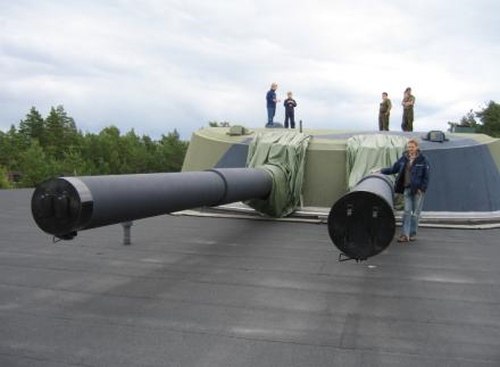
The main attraction of course is the restored 12 inch gun turret
In addition, visitors to Kuivasaari can see the genuine natural plants and wildlife of the archipelago. As with many other islands used by the military, Kuivasaari island is well-preserved. Around Helsinki, for example, nuokkukohokki grows only on the army Islands: Kuivasaari and the adjacent Isosaari. In addition to abundant birds, Kuivasaari has, for example, as many as 400 kinds of butterflies. Kuivasaari also has historical Tsarist buildings, as well as some old plantings. The island also has a Coastal Soldiers’ Association military canteen, that now provides the opportunity to look back at military service time and offer to the wife and children that famous coffee and donuts. The island also sells literature and publications related to the coastal artillery. Purchases are by cash only.
If you want to visit another Finnish Coastal Artillery Fortress (that’s rather more easy to visit), please take a look at Örö – an island coastal artillery fortress in the archipelago that offers up some unique scenery and wildlife as well as the interesting military and cultural history. Örö is still a military area and as such is closed to individual visitors, but in summer it’s possible to visit Örö through organized and guided excursions by boat or on a traditional archipelago sailing ship. Four different companies run trips to Örö and in 2013 the number of days on which visits to the island are permitted to visit has been increased from fifteen to twenty. It’s a bit more accessible than Kuivasaari and in any case, well worth a visit on its own merits.
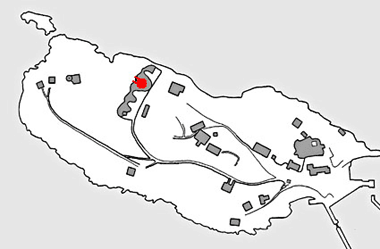
Another map of Kuivasaari showing all fortifications and buildings. The 12″ gun turret is marked in red,
Incidentally, there are several military islands on the Finnish south coast, which until recently have been off-limits to civilians, but have now been made available for civilians to visit them. The Island of Örö (a bit south of Hanko/Hango Peninsula) opened to the public just last year and has one of the remaining three remaining Finnish artillery installations with 305-mm guns – the third place being Isosaari Island outside Helsinki (and right next to Kuivasaari), but Isosaari is still a restricted military area. Other islands recently made available to the public are Kuninkaansaari and Vallisaari Islands next to Suomenlinna (in Helsinki) – they have Russian-built “battery-front”-type coastal artillery batteries which are basically unmodified since 1917 with the oldest artillery battery (Alexander’s Artillery Battery) originating from the time of the Crimean War, although the guns have been removed from all of them.
The rest of this article will look at the history of the Kuivasaari Coastal Artillery Fortress and its guns, before ending with a lengthy collection of photographs illustrating the guns of Kuivasaari. Which you can see for yourself if you’re lucky enough to get there.
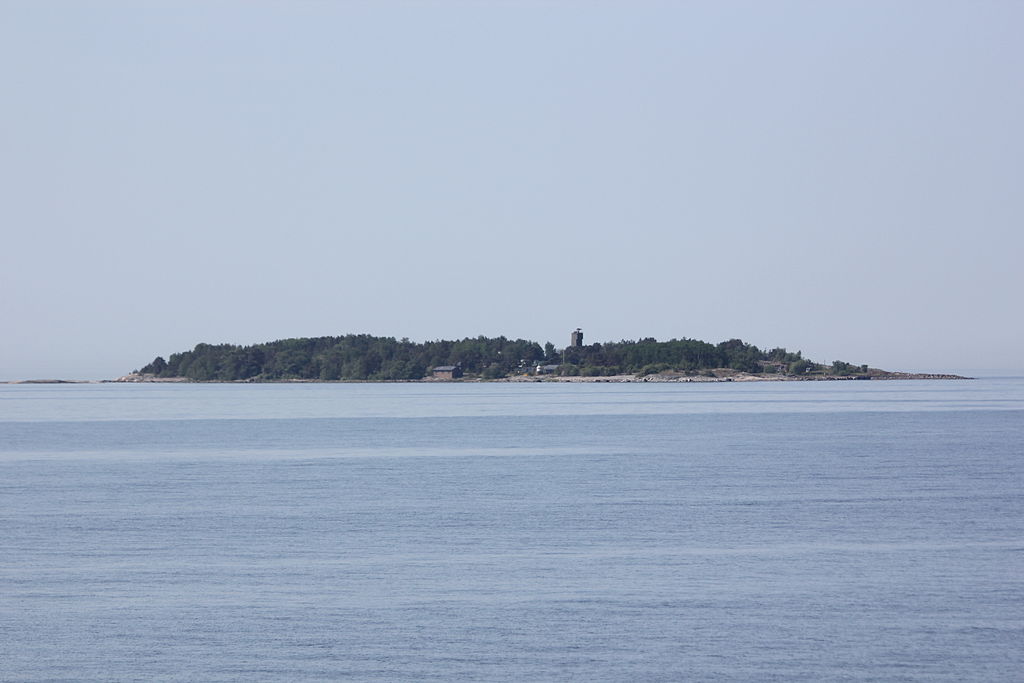
Kuivasaari island of Helsinki / Helsingin Kuivasaari
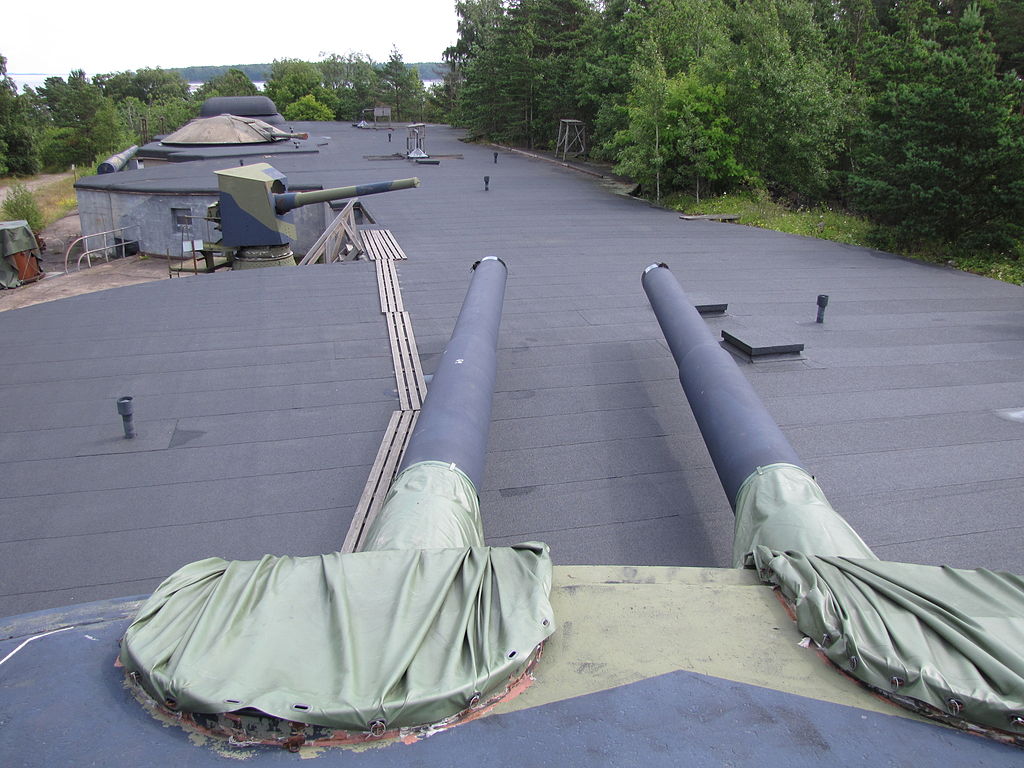
Coastal artillery exhibition in Kuivasaari island. Photo taken from the roof of a 305 mm double turret, 152 mm Canet gun in original condition next, rebarreled Canet with 152 mm Tampella barrel under cupola, command point last. The position is originally built for 254 mm Durlacher guns in single mountings; one such gun is in the fourth position behind the photographer.
Kuivasaari and the construction of the Fortress of Krepost Sveaborg
The Fortress of Krepost Sveaborg
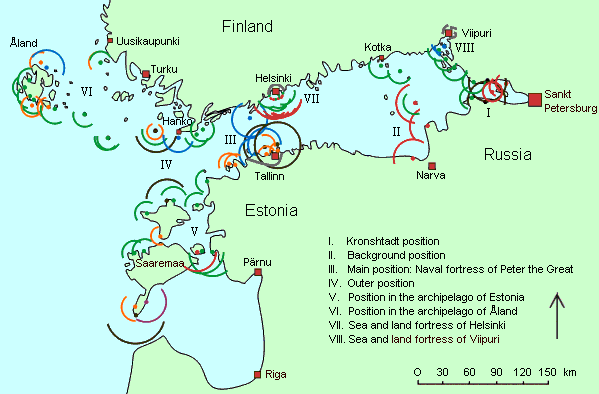
Coastal batteries and firing sectors in the northern Baltic and Gulf of Finland at the end of the war 1918
Kuivasaari was originally one of the defensive positions that made up the Fortress of Krepost Sveaborg. Krepost Sveaborg as an Imperial Russian system of land and coastal fortifications constructed around Helsinki during the First World War. The purpose of the fortress was to provide a secure naval base for the Russian Baltic fleet and to protect Helsinki and block routes to Saint Petersburg from a possible German invasion. Krepost Sveaborg was part of Peter the Great’s Naval Fortress, a coastal fortification system protecting access to Saint Petersburg, one of the most important cities of Tsarist Russia, by sea. The original fortress of Sveaborg, present day Suomenlinna, was constructed by the Swedes when Finland was a part of Sweden (prior to the Finnish War of 1808-1809. the outcome of which had been that Sweden ceded Finland to the Russian Empire).
After the end of the Napoleonic Wars many new buildings were built to improve the living conditions on the fortress, but the fortifications themselves were neglected. After the start of the Crimean War in 1853 construction of new fortifications began on other nearby islands and on the southern shore of Helsinki peninsula. In 1854 an Anglo-French naval fleet entered the Baltic Sea, hastening the work. These fortifications protected the flanks of the fortress and provided depth to the defence, but the problem of obsolescent artillery was not solved. Thus when the Anglo-Fench fleet attacked the fortress on the 6th of August 1855 they were able to bombard the fortress for two days from a distance of 4–5 km (2.5–3.1 mi) while the best Russian guns had a maximum range of only 2,500 m (8,200 ft).
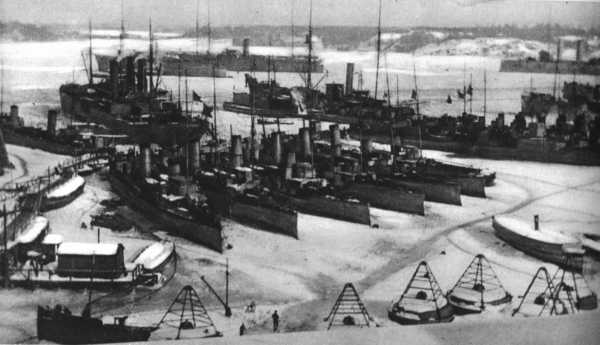
Russian warships overwinter in Helsinki during the first world war
After the Crimean War fortifications of Sveaborg were improved by building artillery casemates and new bomb-proof buildings. Vallisaari just east of Suomenlinna was the site of the first new construction works. The harsh suppression of the Polish January Uprising of 1863 and the resulting criticism soured the relationships between Russia and the major powers of western Europe and hastened the construction of the fortification works. Between 1863 and 1864 redoubtswere built on Vallisaari, Kuninkaansaari and Santahamina islands. In the 1860s and 1870s Russia purchased and then built under license new Prussian Krupp rifled breech loading guns which were also placed in Sveaborg. A total of 32 new bomb-proof stone powder cellars were built by the beginning of the 1870s, further improving the defences.
The Russo-Turkish War of 1877–1878 was the next crisis that threatened the peace between Russia and Britain, resulting in new batteries being built on Kuninkaansaari and older ones improved or rebuilt. New technology in the form of telegraph, railway lines and searchlights began to be used. Improvements in artillery and ammunition forced improvements to the gun positions by covering the old walls and fortifications with a thick earthen walls. With high-explosive shells appearing at the end of the 19th century, earth and stone were no longer sufficient protection and the first concrete fortifications with steel doors were built in Sveaborg.
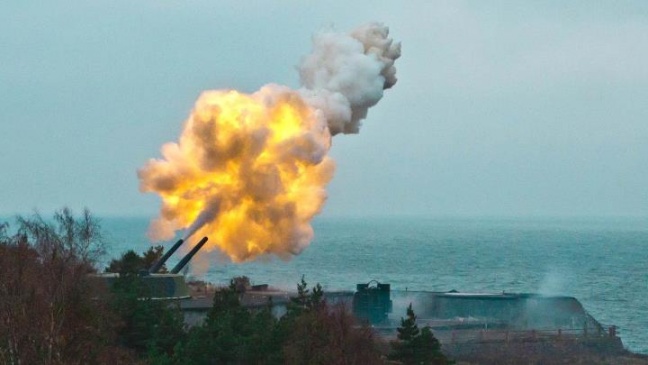
Kuivasaari 305/52 Obukhov gun firing
Continually improving guns resulted in increased range, necessitating rangefinders, while heavier guns and ammunition required improving piers, roads, cranes and ammunition carts to transport the guns or move ammunition from magazines to guns. Despite the improvements the funds and resources allocated to the fortress were not sufficient to keep pace with the rapid evolution of military technology. While parts of the fortress or were improved and new weapons or equipment were received, the overall condition of the fortress became ever more obsolescent, and the vulnerability of the flanks and rear were a lasting problem. By the end of 1880s and early 1890s Viapori could no longer be considered a proper fortress but only a coastal position, capable of defending only against an enemy attacking directly from the sea.
In the 1890s the priority for the construction of fortification works in the Baltic Sea had been the protection of the ice-free port of Liepāja (German, Libau, in present-day Latvia), and the Kronstadt naval fortress protecting Saint Petersburg, relegating Sveaborg to a secondary status. Two factors changed this. The losses the Russian Navy had suffered during the Russo-Japanese War and the rising might of the Imperial German Navy. In the Russo-Japanese War of 1904-1905, the Russian Far East Fleet had been destroyed almost totally in the seige of Port Arthur. The Russian Baltic Fleet was sent to the Far East to regain Russia’s lost naval supremacy, but the fleet was almost completely destroyed in naval battle of Tsushima year 1905. Only some vessels were saved. This was an unmitigated disaster for the Russian Navy, which had lost the majority of it’s major warships, leaving the Baltic almost unprotected. New battleships would take years to build.
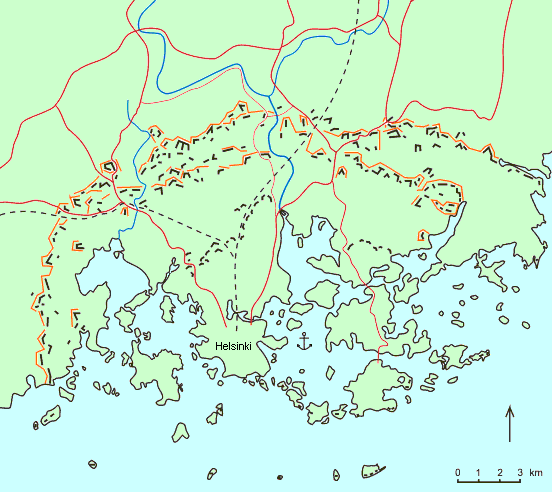
Krepost Sveaborg or the sea and land fortress of Helsinki during the first world war. Main roads and railroads are also marked. The naval port is marked by an anchor.
The threat of from the Imperial German Navy also now meant that Liepāja was considered too vulnerable to remain a main fleet base, and the decision to build the Peter the Great Naval Fortress was made. Thus began work on what was possibly the world’s largest-scale coastal fortifications. In the new plans the main line of defence against the enemy was to be the Porkkala-Tallinn line, with Tallinn being the new main base for the Russian Baltic Fleet. Helsinki was to be a base for torpedo boat flotillas. The construction of the Tallinn naval base was delayed however, and with the new ships being constructed to replace the losses suffered against Japan the Russian Navy was forced to rely more on Helsinki despite the obsolete armament and inadequate fortifications at Sveaborg. As the threat of war in Europe grew, it became essential to expand the fortress to provide a necessary protection for the naval base. The fortification work on Krepost Sveaborg started finally in earnest in the year 1912 after much planning and deliberation. Meanwhile both the German and Swedish naval forces in the Baltic were being strengthened.
By the end of the first year of war, the Gulf of Finland was so strongly fortified and mined that it was improbable that Germans could land anywhere near Saint Petersburg. It was supposed that if German forces did attack, they would land from the Gulf of Bothnia on the west coast of Finland. As a result, fortifications were built at the main traffic junctions of southern Finland facing towards the coast. The idea was that the defending Russian army could withdraw into south-east Finland and fight a delaying action while awaiting help from Russia. In this kind of situation it would be very important to keep Helsinki in the defenders possession.
On gaining independence, Finland inherited these fortifications and the guns that went with them, including a number of the 12 inch (305/54 O2) guns, two of which were to eventually end up at Kuivasaari. As a result of taking over these Tsarist Russian fortifications and guns, Finland ended up with powerful coastal artillery guns that would not otherwise have been within the financial capabilities of the new state’s limited defense budget.
The construction of the Fortress of Krepost Sveaborg
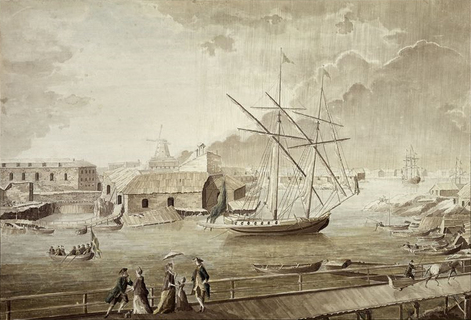
A pojama flying the blue naval ensign of the Swedish archipelago fleet in Artilleriviken (Tykistölahti); painting by Adolf Geete, 1760.
The central part of Krepost Sveaborg was the old fortress of Suomenlinna where the fortress headquarters were located. Suomenlinna in it’s current form had been begun in 1747, when, following wars with Russia in the first half of the 1700’s, the Swedish parliament made a decision to build a central fortress including a naval base in Helsinki and a border fortress in Degerby, off Loviisa. In 1750, the fortress was named Sveaborg, rendered phonetically to Viapori in Finnish. The ambitious fortification plans had to be scaled down a few years after construction began, with the active phase of the Viapori fortification work ended just over 40 years after it began.
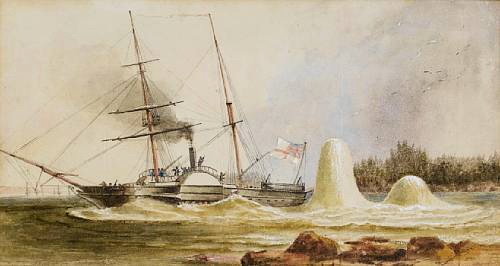
The survey vessel H.M.S. Merlin narrowly escaping destruction by two Russian mines off Sveaborg early in August 1855 by John Wilson Carmichael (the Crimean War)
The fortress was actually never quite completed as planned, even though the original aim was to complete the construction in only four years. In 1808, Viapori was besieged by the Russian forces in the Russo-Swedish war. After only minor skirmishes, Commandant C.O. Cronstedt decided to surrender. The reason for surrender remains an unsolved mystery. The surrendered sea fortress was taken over by the Russians, and a new era began for Viapori. Finland was ceded by Sweden to Russia and became an autonomous Grand Duchy of Russia, but Viapori remained a military base under Russian administration. The Russians valued the Viapori fortress and made big plans for it. The fortress perimeter was expanded to Santahamina, Kuningassaari and Vallisaari. Barracks to house soldiers were built in the fortress, and an Orthodox garrison church designed by Konstantin Ton was completed.
The military importance of the fortress declined over the course of the 1800s. The maintenance and renovation of the fortifications were neglected due to a lack of funds, and Viapori fell into decay. It was not until the run-up to the Crimean War (1853–1856) that the condition of the fortress began to raise concerns. War broke out between Russia and Turkey, but England and France soon joined forces with the Turks. A combined Anglo-French fleet bombarded Viapori for two days in August 1855, and Viapori sustained heavy damage in the bombardment.
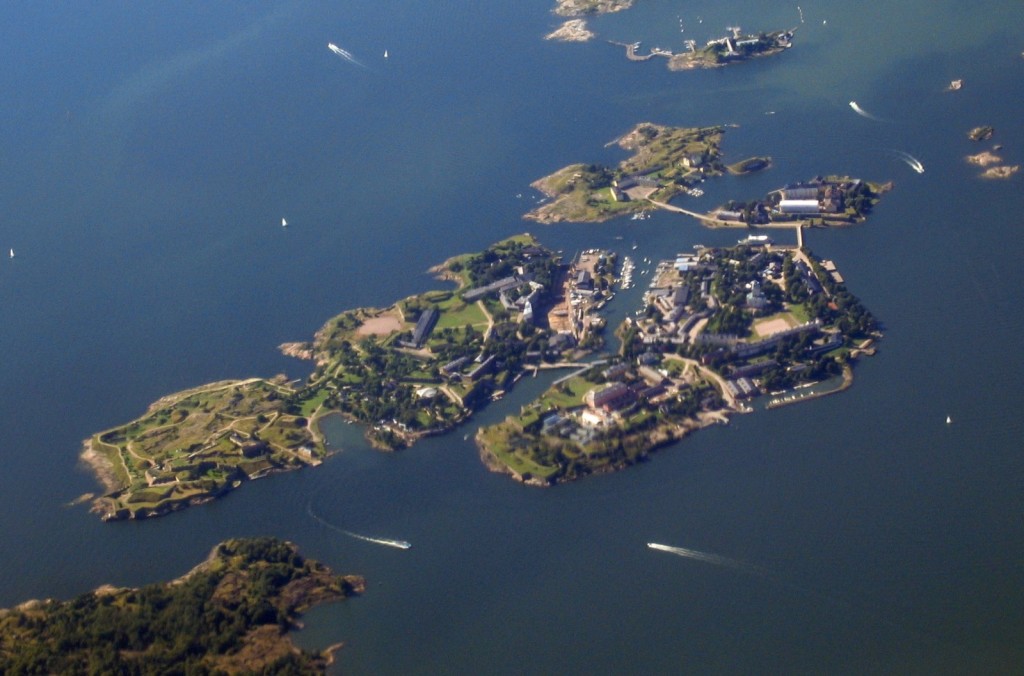
An aerial view of Sveaborg / Suomenlinna
Due to technological advances in artillery the old fortress was no longer capable of providing sufficient protection, and a new main defensive line was built well beyond the old fortress boundaries. Until 1910, when the first 152 mm Canet guns arrived, the only modern weapons at Viapori were 57 mm quick fire guns with the rest of the artillery designs dating from the Russo-Turkish War. When the First World War broke out in August 1914, most of the sea front batteries dated from the end of the 19th century. The sea front started from the island of Melkki and continued through old Sveaborg (Viapori) to Santahamina. Batteries were constructed using stones, bricks, soil and sand. The first concrete batteries were constructed at the beginning of the 20th century. the guns were old, from the the 1870’s. There were less than dozen modern 152 mm (6″) Canet cannon and 57 mm (6 pounder) rapid fire cannon in all. The building of new batteries started a couple of weeks before the war broke out. New batteries were located on the outer sea front on islands of Pyöräsaari, Miessaari, Rysäkari, Katajaluoto, Harmaja, Kuivasaari, Isosaari, Itä-Villinki and on the cape of Skatanniemi. The first new 254 mm guns arrived in 1913, but it was not until early 1914 that construction of the first new batteries began on Melkki and Isosaari.
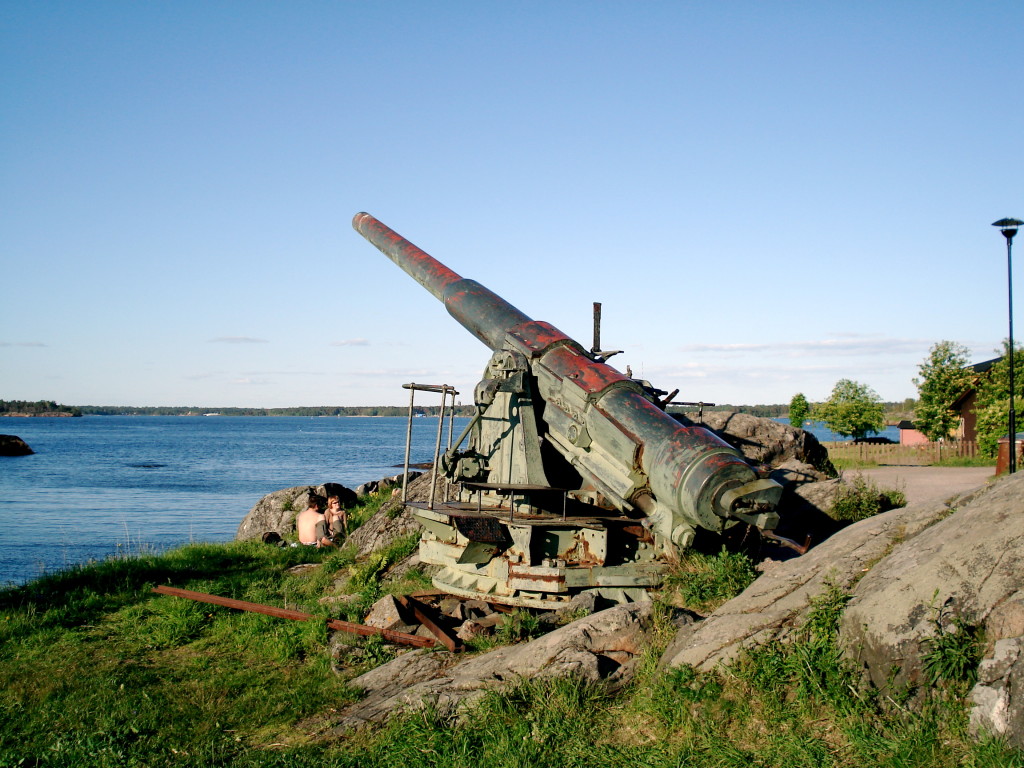
New coastal artillery guns were installed…
New coastal artillery guns were installed on the outlying islands protected Krepost Sveaborg from the sea (of which Kuivasaari was one), while fortified lines were constructed around the landward side of Helsinki and intended to stop any attacks from inland. The primary coastal guns were 10 in (254 mm) model 1891 guns and 6 in (152 mm) model 1892 Canet guns. Older 11 in (279 mm) model 1877 guns were also used. In the summer of 1917 the fortress had two hundred coastal or anti-landing guns, of which 24 were 10-inch guns in six batteries, 16 were 6-inch Canet guns in four batteries and twelve were 11-inch guns in three batteries. The artillery used in the land fortifications included older coastal guns, old fixed carriage guns and newer light field guns.
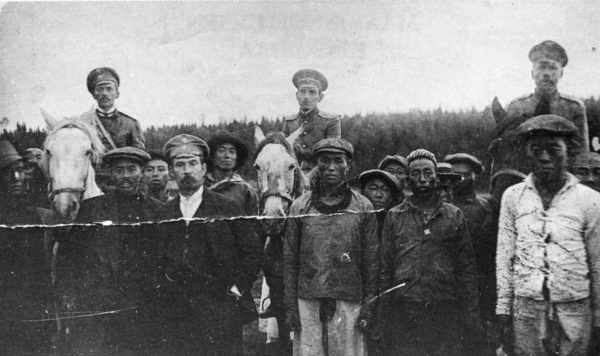
Asian workers in the Fortress Area. There are some pictures in the archives of Chinese prisoners but very few of the 100,000 Finnish fortification workers. (Photo: Espoo City Museum)
It is impossible to give the exact number of fortification workers in the Helsinki area, but one calculation is 15,000 workers. During the first world war there were in all 100,000 men involved in the fortification work in Finland. Finns were exempt from conscription, and thus there was available manpower for fortification works. The payment for fortification works was slightly above average for manual labour, and made it an attractive option particularly for many rural workers. After the building of the fortifications ended in year 1917 there was a large scale unemployment. This caused dissatisfaction and scarcity, which partly influenced the breaking out of the civil war in Finland. The building site of the fortress was one of the biggest construction sites ever in Finland. Building of fortifications was supervised by Russian engineering officers, but most of the workers were Finnish employees who got paid for working. Complicated bureaucracy delayed the construction works, and the supervision of the works was also poor, leading to a widespread graft.
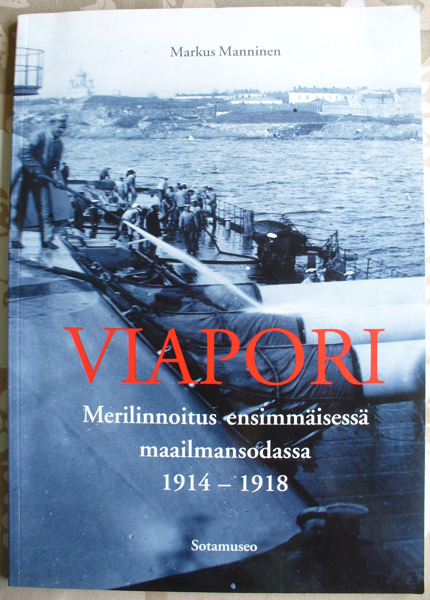
Markus Manninen’s “Viapori, Merilinnoitus ensimmäisessä maailmansodassa” (“Viapori, Naval Fortress in 1st World War”) is a great source of information on Helsinki as a Russian Naval Base in WW1.
There were not enough local workers, after the war started, more employees were conscripted from the countryside of Finland. Besides that over 3000 prisoners from the Far East (for example from China) were brought to Finland. Prisoners had very poor equipment for the weather conditions in Finland and soon most of them were sent away. Despite that these odd strangers left a number of stories in Finland. Nowadays many people think that the Chinese built every fortification in Helsinki.
In March 1917, Krepost Sveaborg had a total of 463 guns, although many of them were obsolescent. Krepost Sveaborg was still partly incomplete in 1917 when the February Revolution halted most of the construction work. Some further construction work was carried out during the remaining year, but all work halted after the October Revolution of 1917, when the Bolsheviks seized power in Russia. Most of the Russian troops left the islands year 1918. Following the Finnish Declaration of Independence, parts of the land fortifications were used in the Finnish Civil War. The coastal fortifications were later taken over by Finland to protect Helsinki, while the land fortifications were mostly abandoned and disarmed.
The takeover of the fortifications by a newly independent Finland caused some legal disputes. When the Russians took the islands over for military use, they become not the property of the Russian government but of the Russian Royal Family. When state of Finland took them over in 1918 the islands were legally treated as war trophies and this resulted in numerous legal battles with their earlier Finnish owners, many of whom did not accept the compensation that the Finnish government paid them circa 1919 – 1920.
The fortified islands surrounding Helsinki have kept their strategic importance almost to the present. Most of the islands are still military areas. However, a few batteries are in areas accessible to the public. The maritime fortress of Suomenlinna was chosen as a World Heritage Site in 1991 as a monument of exceptional military architecture, is freely accessible and is definitely also worth a visit. For more on this, see my article on the Fortress of Krepost Sveaborg (I’ll add the link in when it’s completed).
The Kuivasaari Coastal Artillery Fortress
Initial construction of the Kuivasaari Coastal Artillery Fortress
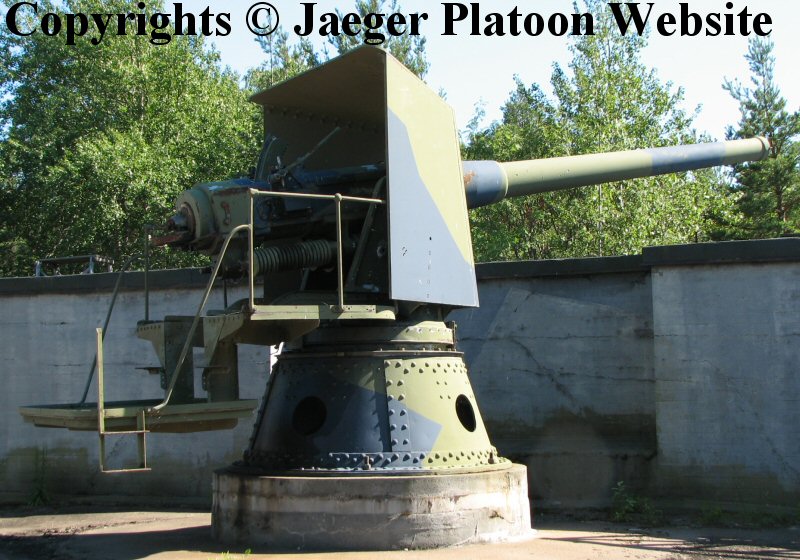
Canet 152/44 C coastal gun on CR gun mount. In a rather unusual manner this gun has not been inverted, since the recoil mechanism is still under the gun. However still the gun has a Finnish-redesigned gun bridge to facilitate faster and simpler loading process. Photo taken on Kuivasaari Island and courtesy of www.jaegerplatoon.net
Kuivasaari island is located west of Isosaari. Construction of a 6 inch Canet battery was planned in spring 1914, but these guns were placed on Isosaari instead.
As a side note, in 1918 the Finnish military took into its possession about 100 of these Canet guns, which made the 6 inch 152/45 C obviously the most common heavy coastal gun in Finnish use. Due to relatively low gun mounts and the spring recuperator under the gun, the maximum elevation was relatively small, which limited the maximum range of the gun. The Finnish solution first implemented with the 152/45 C and then used in numerous other coastal guns was to invert the gun on its gun mount in such manner that after the modification the spring recuperator was on top of the gun. A Canet 152/44 C (photo right) can be found on Kuivasaari.
After World War One began, construction of a 10 inch battery began on the western shore of the island. The guns (four 254mm / 10 inch 45 calibre Durlacher guns with a range of 20kms and capable of firing one shell every two minutes) transported from Vladivostok, were placed on their foundations in February 1915 and the battery was finished early in the winter of 1915. Artillery Battery 44 was assigned to Kuivasaari Island. The main fire control station of the fortress with a 6 m (20 ft) rangefinder was located in Kuivasaari. The island also had a 150 cm searchlight. The Kuivasaari telephone exchange was also the central gunnery telephone exchange. Roads, ammunition cellars and barracks were also constructed. A four-gun 75 mm anti-aircraft battery on wooden platforms was located on the northern part of the island.
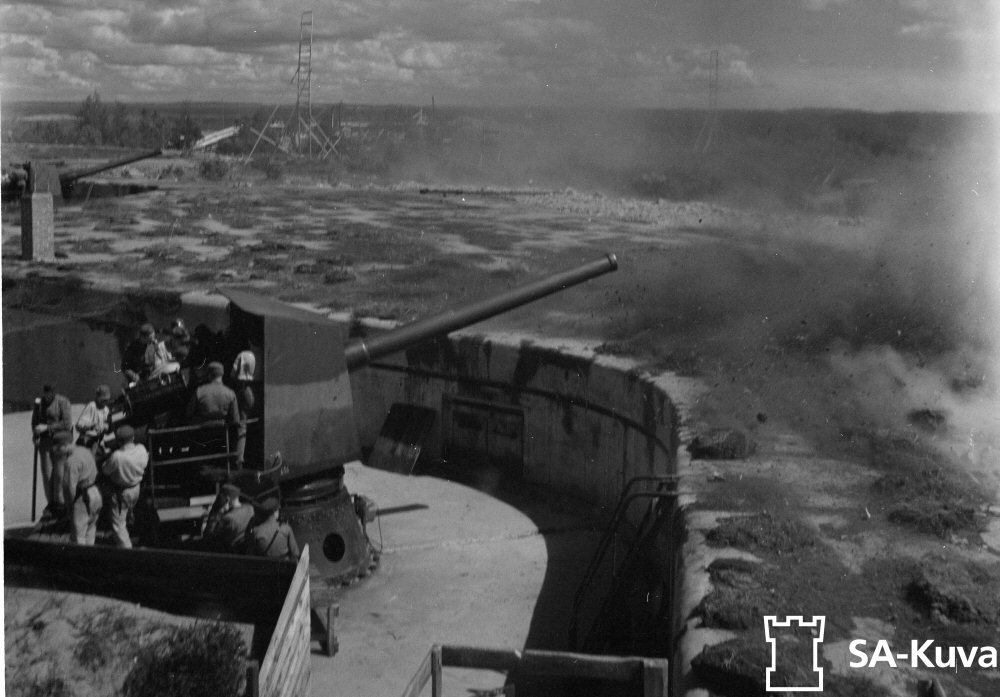
Canet 120/45 C coastal artillery battery on Isosaari Island outside Helsinki is shooting. This photograph gives an idea what the Russian battery front type coastal artillery batteries looked like. Photo taken in July of 1942. (SA-kuva photo archive, photo number 29302). Photo courtesy of Jaeger Platoon Website (www.jaegerplatoon.net) and SA-Kuva.
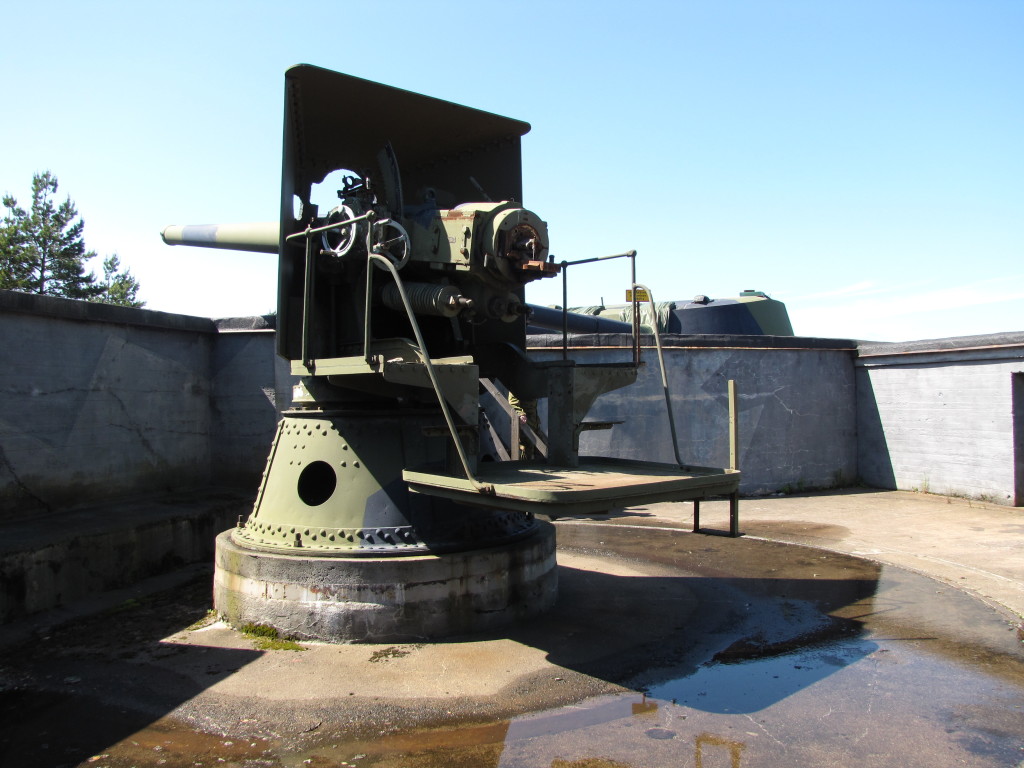
152 mm 45 calibre Canet model 1892 coastal gun on Kuivasaari island. This gun has been restored to original condition, though the fortified position was originally intended for a 254mm (10inch) Durlacher gun. Manufactured by Obukhov state plant in 1896, serial number 30.
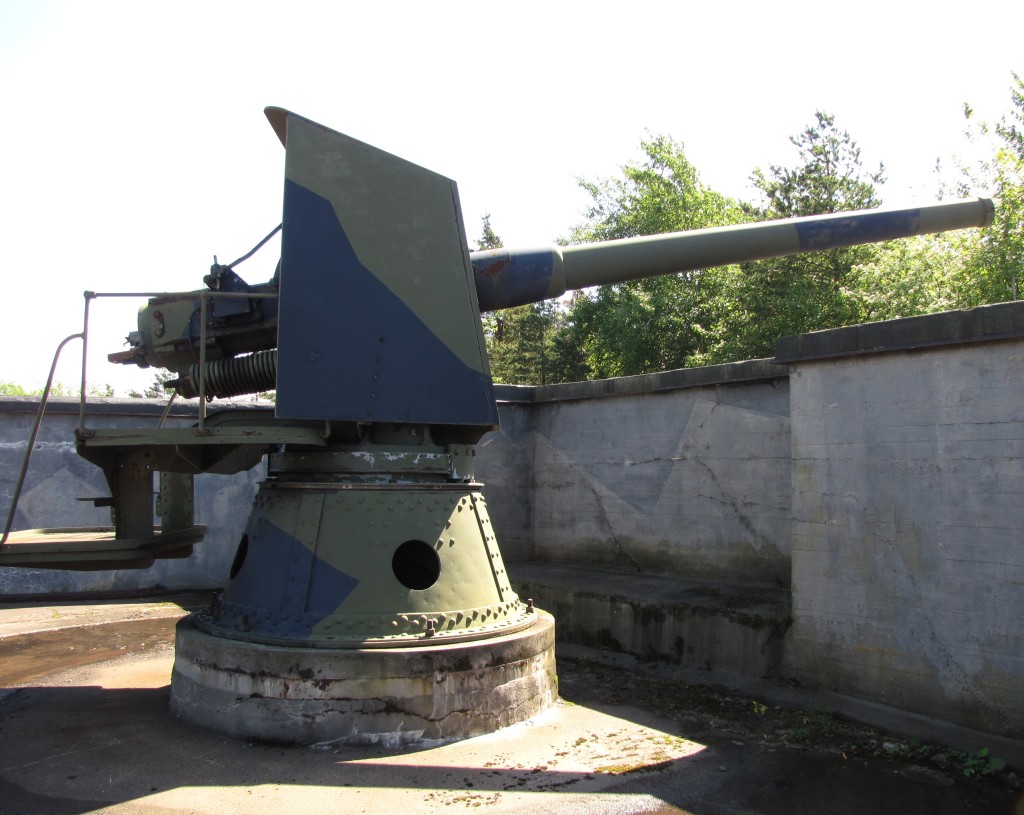
152 mm 45 calibre Canet model 1892 coastal gun on Kuivasaari island. This gun has been restored to original condition, though the fortified position was originally intended for a 254mm (10inch) Durlacher gun. Manufactured by Obukhov state plant in 1896, serial number 30.
The Kuivasaari Coastal Artillery Fortress 254/45 D Guns (245 mm / 10 inch coastal gun with 45 caliber barrel, model Durlacher)
The naval version of this gun was officially approved for Russian Navy use in the year 1892 with the first order placed with the Obukhov Steel Works in the same year. The old Imperial Russian Navy used the naval version as the main guns on its pre-dreadnought battleships, the Peresvet, Osljabja and Pobeda (completed in 1901 – 1902) and the pre-dreadnought battleship Rostslav (completed 1900). The naval version was structurally a lighter design, with issues with weak gun barrels and poor ballistics.
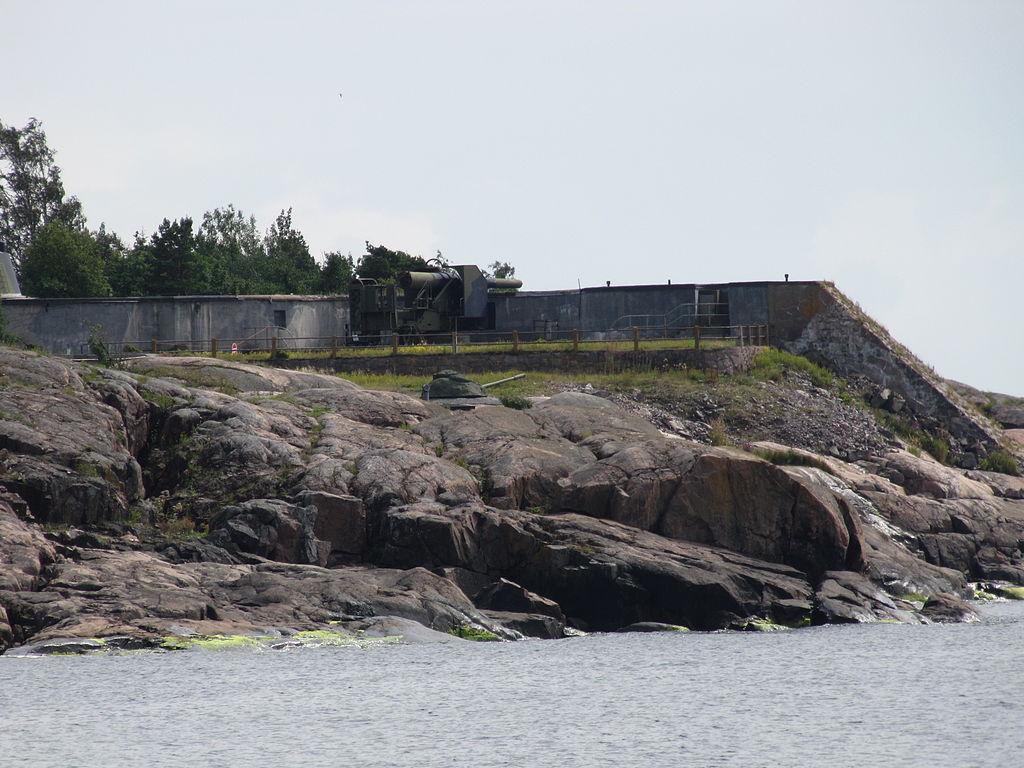
254mm (10inch) 45 calibre coastal gun in Kuivasaari. In Finnish service they were known as Durlacher guns after the gun mounting designer. 100 56 TK in foreground. / 254/45 D eli 254 mm 45 kaliiperimitan Durlacher-rannikkotykki Kuivasaaress. Tykki on Obuhovin valmistama, mutta tunnettiin Suomessa jalustan suunnittelijan mukaan Durlacher-tykkeinä. 100 56 TK etualalla.
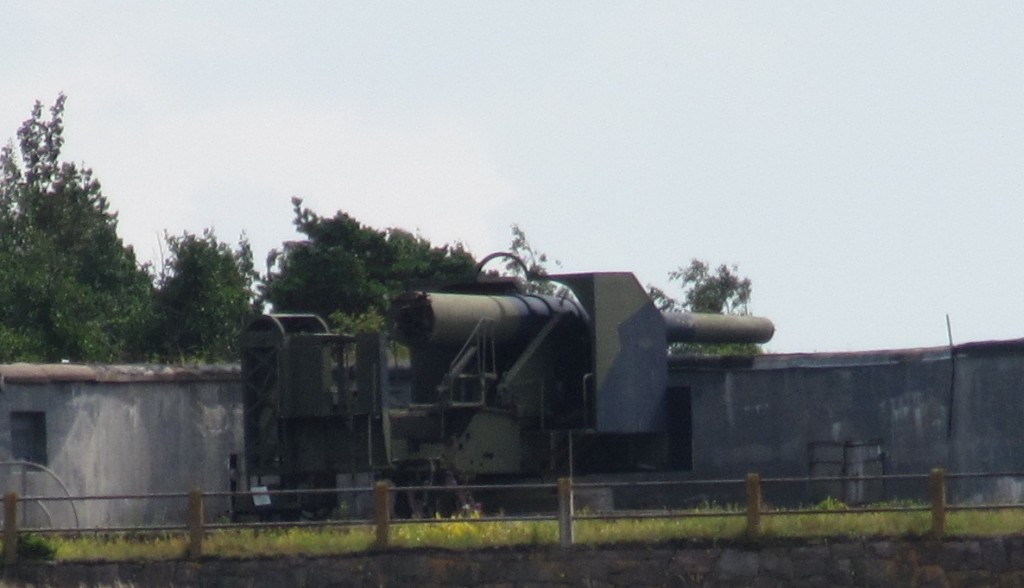
254 mm 45 caliber model 1891 coastal gun on Durlacher mount in Kuivasaari. Manufactured by Obukhov in 1906, serial number 114. / 10 tuuman (254 mm) Durlacher tykki ja 100 mm tornikanuuna.
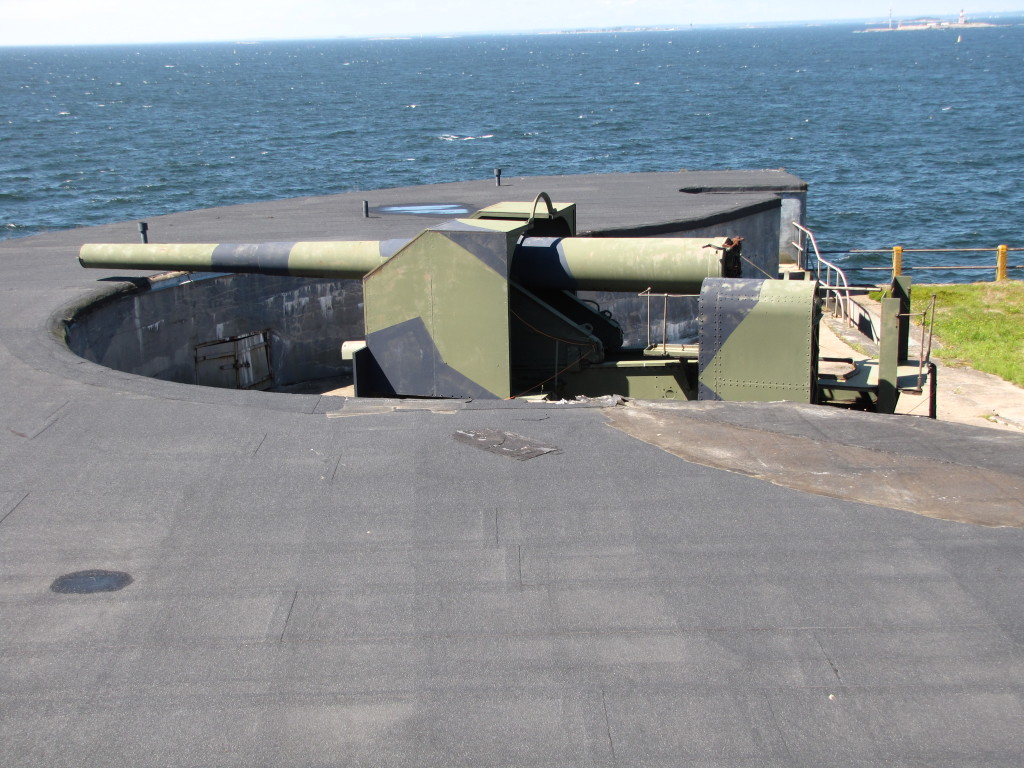
254 mm 45 caliber model 1891 coastal gun on Durlacher mount in Kuivasaari. Manufactured by Obukhov in 1906, serial number 114.
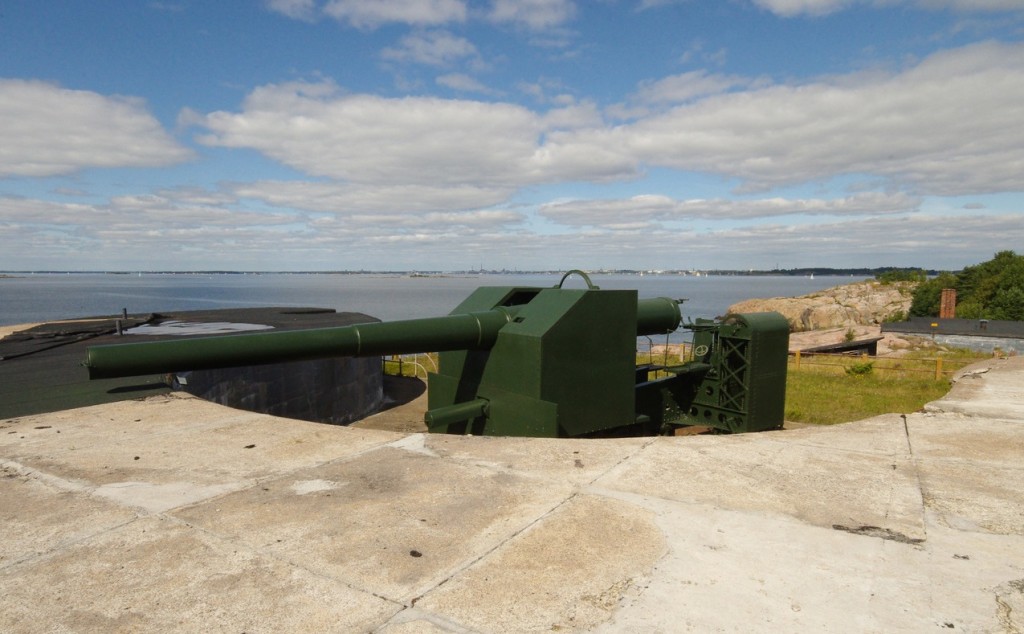
254 mm 45 caliber model 1891 coastal gun on Durlacher mount in Kuivasaari. Manufactured by Obukhov in 1906, serial number 114.
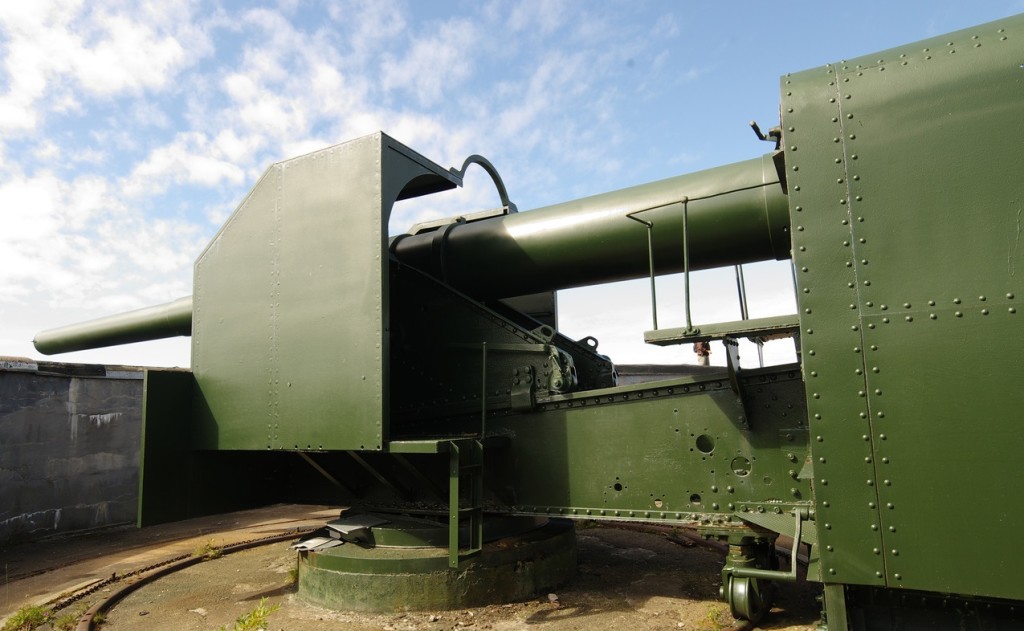
Another photo of the Durlacher gun on Kuivasaari
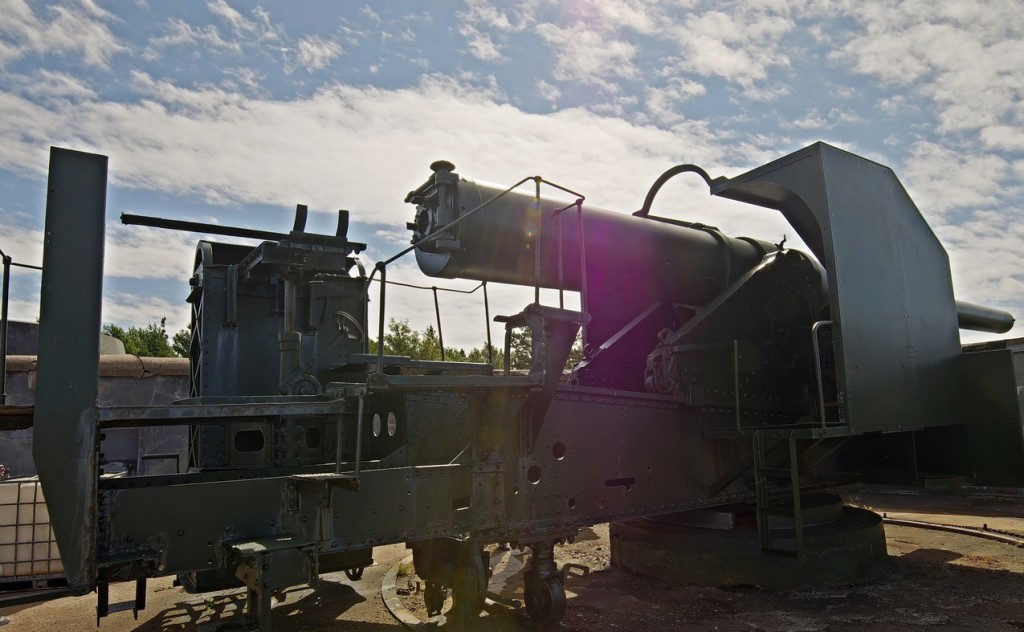
And another photo of the Durlacher gun in the Kuivasaari Coastal Artillery Fortress today
Russian coastal artillery found the gun suitable for its purposes – one reason to prefer it was that this gun was considered to be just barely light enough for the gun to be laid by hand. The coastal-gun version equipped with the Durlacher gun mount was officially approved in 1895. The decision approving the gun for military use was the subject of criticism almost from the start due to the old-fashioned structural design. The gun was expected to have only a short lifespan before becoming obsolete. Two major existing factors made it obsolete – the gun mount and the gun laying method. The ascending gun mount used for this gun belonged to those developed by General Robert Augustovits Durlacher (later: Durljahov) and was already old-fashioned when introduced. The decision to favor a gun design intended to be laid by hand was also questionable considering that by that time many countries had already introduced coastal guns with electrical gun laying systems. Obukhov Steel Works was the sole manufacturer of these guns. The first coastal guns were ordered in 1896, but an accident in test-shooting of the naval-version resulted in changes being introduced, resulting in the first delivery of these coastal guns being delayed to 1899.
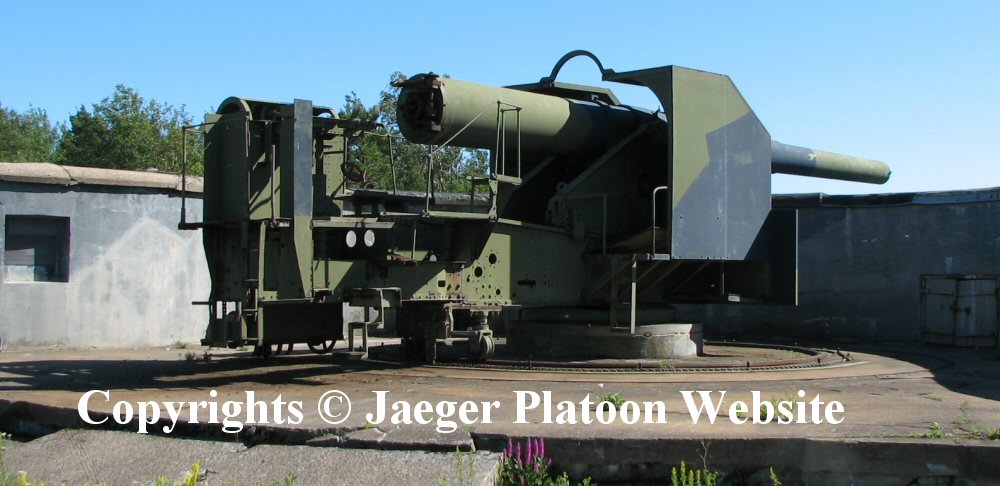
254/45 D coastal gun on Kuivasaaari Island. Photo used courtesy of Jaeger Platoon Website (www.jaegerplatoon.net). There are no other such guns preserved anywhere in the world. This one was pieced together from various parts recovered from the batteries of Katajluoto and Rusakari.
The gun on its own had pretty good ballistics, but the design of the gun mount substantially limited its maximum elevation and therefore limited the gun’s maximum range. While the Obuhov Steel Works was the only manufacturer for the gun, the Durlacher ascending gun mount used with it had two manufacturers – Putilov and Bryarsk. Obuhov started manufacturing the gun mounts in 1899, while Bryarsk started its manufacturing in 1904. Early Putilov-manufactured gun mounts had a maximum elevation of only +15 degrees (allowing a maximum range of only 10.7 km), while later gun mounts came with a maximum elevation of +20 degrees.
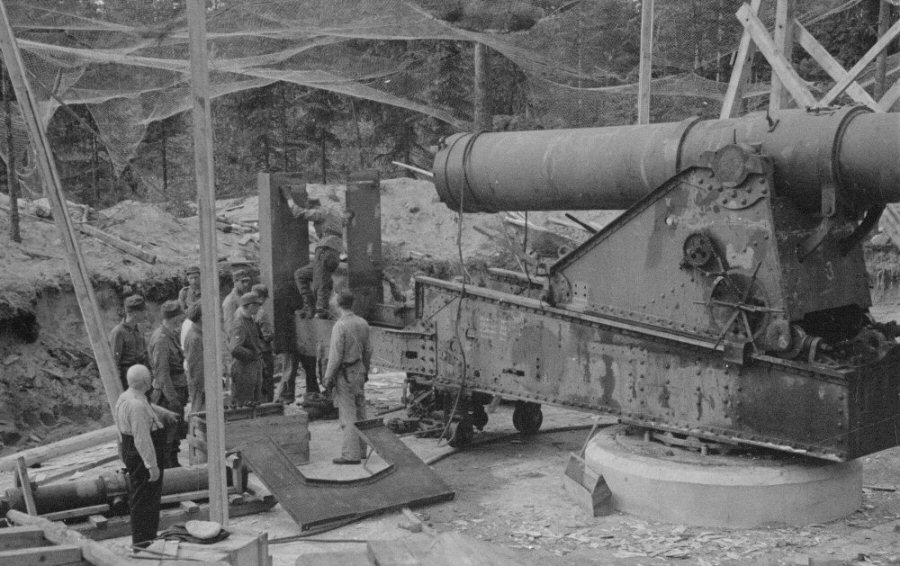
This photo of a partially assembled 254/45 D gun taken in 1942 illustrates well the structure of the gun mount. (SA-kuva photo archive, photo number 103965). Photo courtesy of Jaeger Platoon website (www.jaegerplatoon.net) and SA-kuva
In 1905 Durlacher planned a modification for the existing gun mounts which when implemented allowed them to reach maximum elevation of +30 degrees resulting in a maximum range of 18.1 km. This modification was apparently implemented to all existing gun mounts and also resulted orders for new gun mounts for which modification had already been made, even if this again caused some debate. Just as with smaller ascending gun mounts, this gun mount had upper and lower parts on top of each other, with small rollers in between and used recoil dampening based on gravity and friction. During recoil the gun worked against its own weight because when moving backwards the upper part of gun carriage was forced to climb upwards on the lower part against its own weight with the climb being at angle of five degrees. Once the climb had reached its high point, the gun returned back into its original position due to its own weight.
Most super-heavy coastal guns have a main pivot under the middle of the gun mount, but in this case the main pivot was in front of the gun mount and the gun was laterally turned around it with a set of wheels rotating on a rail under the rear section of the gun mount. Hence horizontal gun laying of this gun by hand was hard physical labour – requiring a team of four men, who due to exhaustion had to be replaced with another team every 30 minutes. This gun laying method also proved so slow, that in reality the guns were not able to follow moving targets (ships) and had to be aimed to shoot at a point towards which the enemy ship was heading, waiting until it came into the line of fire. During World War One there were plans for replacing this old gun laying method with an electrical gun laying system, but apparently they were not implemented. The last but not least major problem with these guns was the primer system, which often got stuck, considerably reducing reliability.
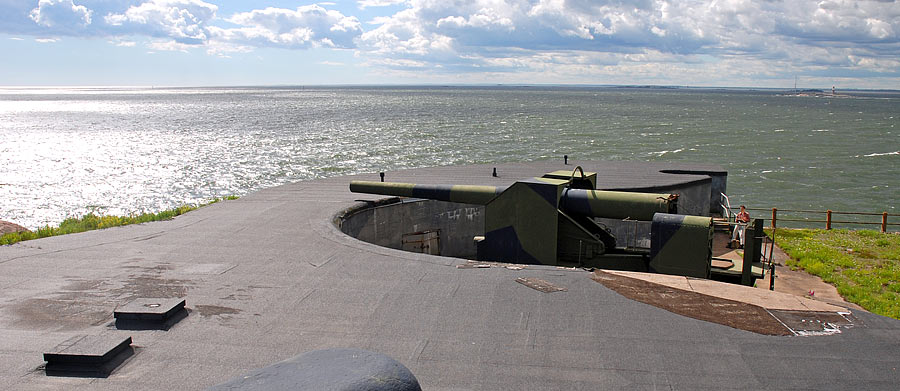
A 6″ Canet gun battery was initially planned, but the plans changed. A 10″ (254 45 D) gun buttery was finished in autumn 1915. The road, ammunition cellars and barracks were also built. Thanks to the Finnish Defence Forces and government, these historically important fortifications are well preserved. Photo courtesy of Northern Fortress website (www.nortfort.ru).
The Russian military first used both naval- and coastal-gun versions in combat during the Russian – Japanese War (1904 – 1905), with one coastal artillery battery equipped with these guns being used in the defence of Port Arthur. While Russian coastal artillery acquired additional 254-mm coastal guns during that war, it was already becoming quite clear that the gun had already lost its edge against modern battleships. During World War One the Russian military used 254/45 D guns both as super-heavy coastal artillery and as long-range artillery. Two guns captured in 1916 also saw use in Bulgaria. The Red Army got rid of most 254-mm coastal artillery batteries remaining in Russian territory in the 1920’s, but some apparently remained in service to see action during World War Two.
This gun, which the Finnish military named 254/45 D, was to become the most common super-heavy coastal gun in use by the Finnish military during World War Two, even if was also the most outdated super-heavy coastal gun in Finnish use. In 1918 Finnish Army took over numerous coastal artillery batteries equipped with 254/45 D coastal guns left behind by the Russians, but not all of these were in operational condition. A large majority of the 254/45 D coastal artillery batteries built during Russian era were around Helsinki. These coastal artillery batteries around Helsinki had been built as part of Krepost Sveaborg (Sveaborg Fortress) over 1913 – 1917 and were located on five islands reaching from southwest to southeast side of the city. They contained six coastal artillery batteries of four 254/45 D guns each – a total of 24 guns. The first of these coastal artillery batteries was on Isosaari Island, for which four guns arrived from Kronstadt already in December of 1913. Later in September of 1914 an additional 12 guns arrived from Vladivostok. The last 8 guns arrived in 1915.
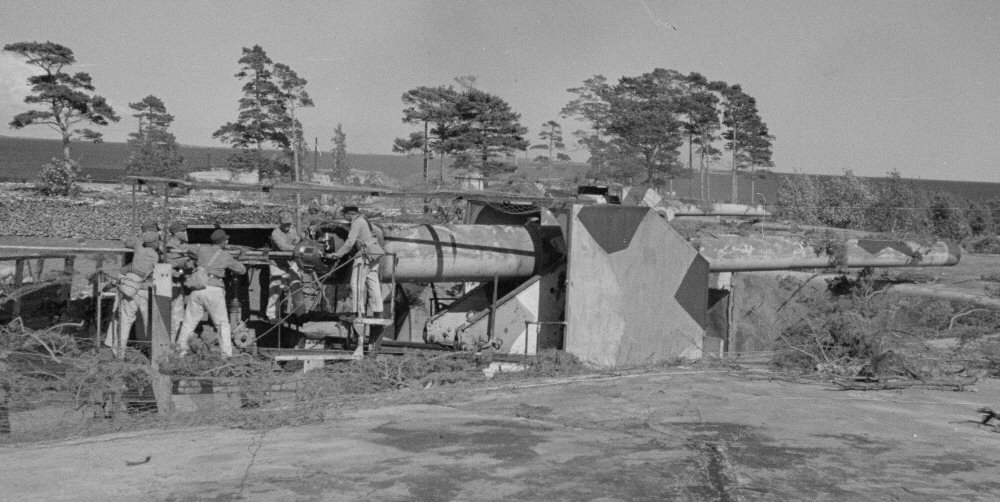
254/45 D coastal gun being loaded. Photo taken on one of the islands outside Helsinki during the Continuation War (SA-kuva photo archive, photo number 96329). Photo courtesy of Jaeger Platoon Website (www.jaegerplatoon.net) and SA-kuva
Two Artillery Batteries were located on Isosaari Island (Artillery Battery 45 in the autumn of 1915, Artillery Battery 46 in May 1916). One Battery (Artillery Battery 41) was located on Rysäkari Island with the guns installed in the spring of 1916. Artillery Battery 42 was located on Katajaluoto Island, with the guns installed over the autumn of 1915. Artillery Battery 44 was located on Kuivasaari Island, with the guns installed over the autumn and winter of 1915. The last battery around Helsinki with these guns was Artillery Battery 49 on Itä-Villinki Island, with the guns installed in 1916. Two further batteries of 254/45 D guns were located at Fort Ino and on Lavansaari Island.
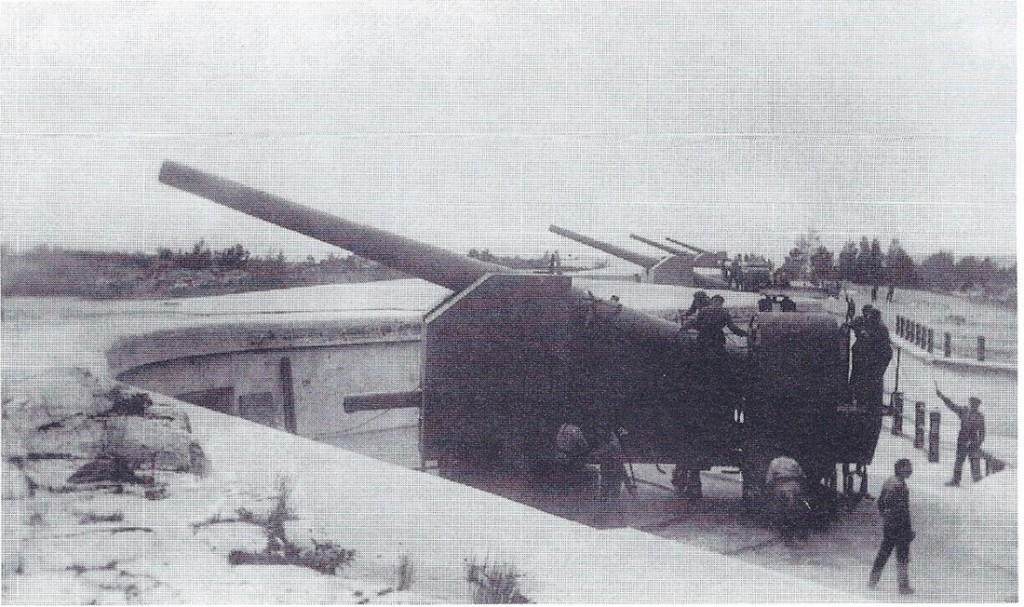
Durlacher Guns, Viapori (Helsinki), 1914-1918
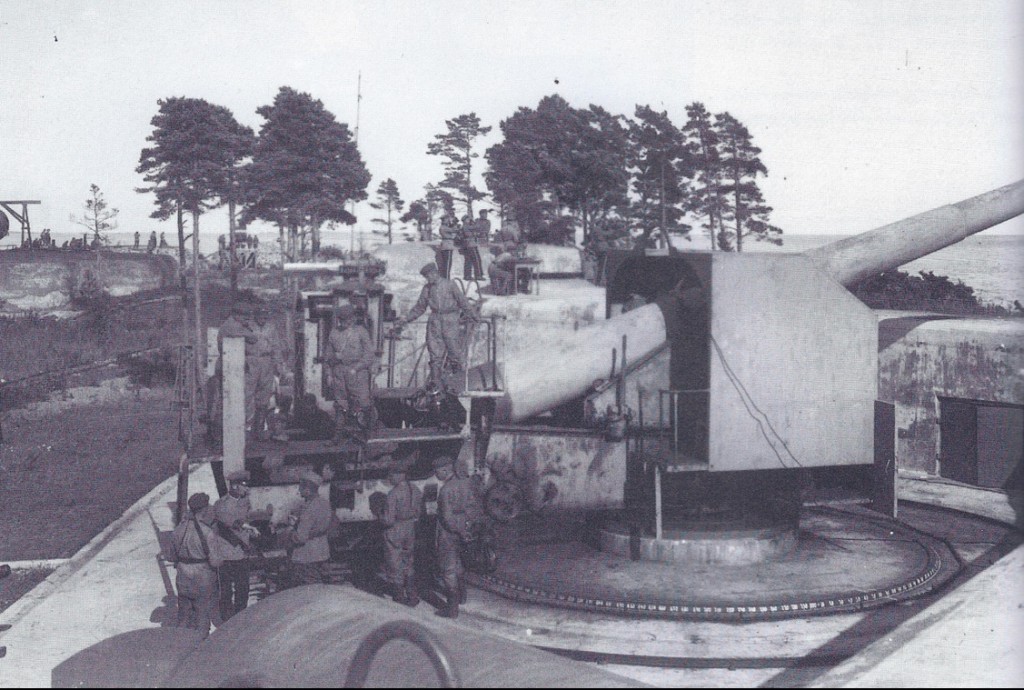
Durlacher Guns, Viapori (Helsinki), 1914-1918
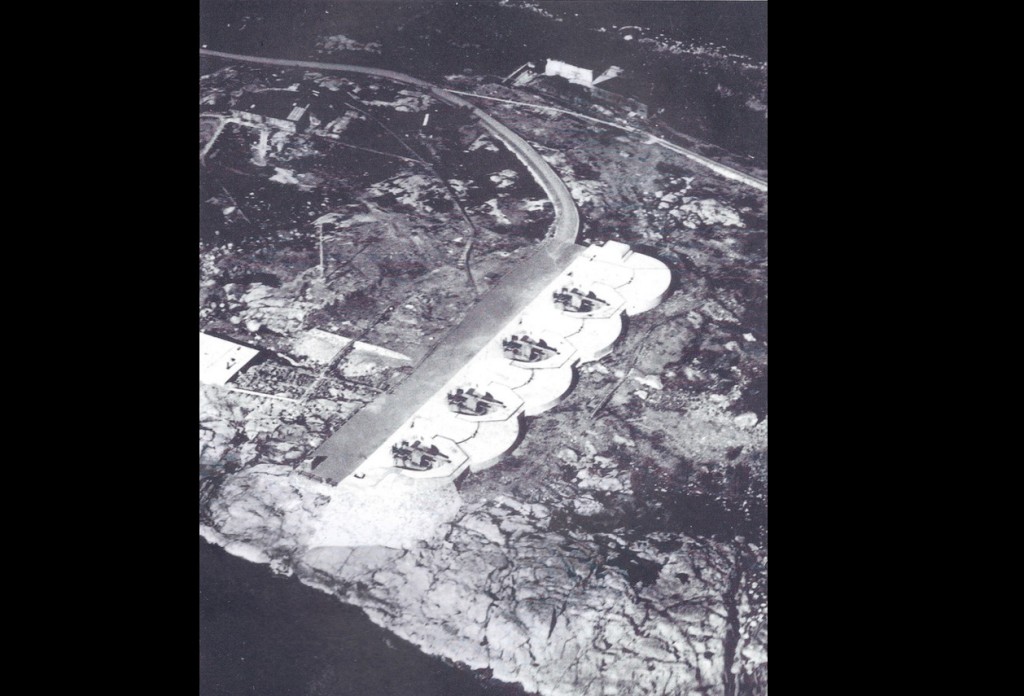
Durlacher 254/45 D coastal gun battery, Kuivasaari? Tsarist times 1914-1917.
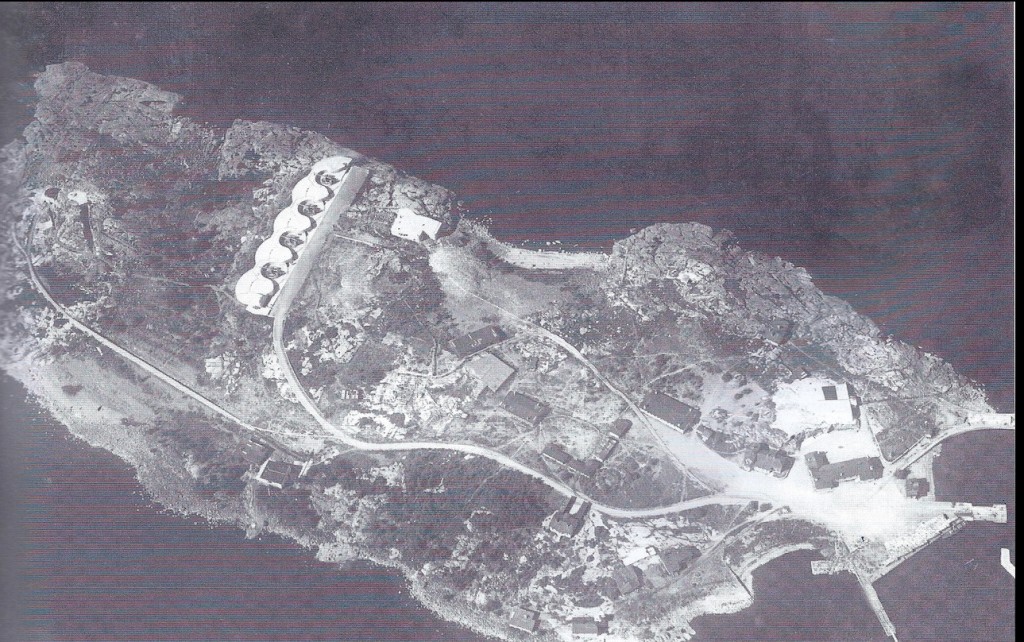
The Kuivasaari Coastal Artillery Fortress during the Tsarist period of WW1 (1914-1917)
For more information on these guns, please see that fount of all information in English on Finnish Weapons, Jarkko’s Jaeger Platoon website (and thanks again Jarkko for letting me reuse the information from your website. REALLY appreciated).
The Kuivasaari Coastal Artillery Fortress under the Finnish Military
Under the terms of the Russian-German treaty that was signed during the Finnish Civil War, coastal guns around Helsinki had been disabled temporarily to make sure that the Finnish Red Guards would not be able to use them. This work was done by removing certain key components of the breech block from each gun, so once the Civil War had ended (with the White victory), the coastal guns around Helsinki could easily be returned back into service.
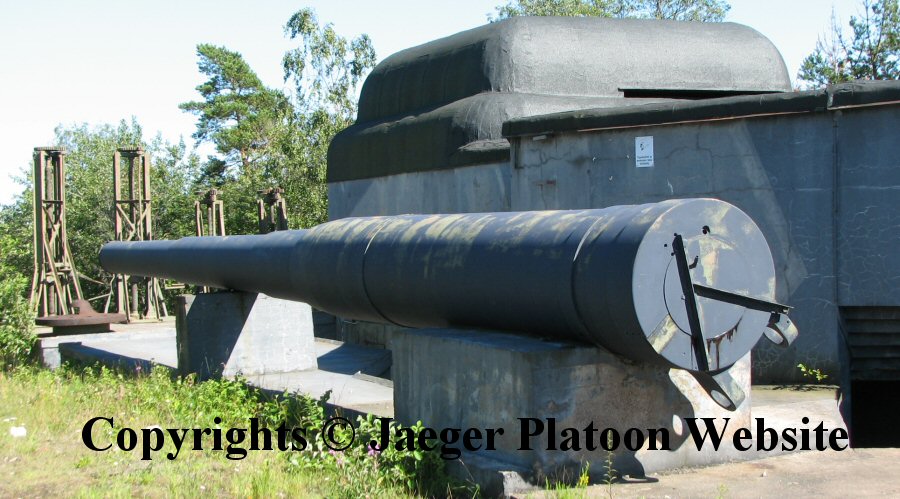
Spare gun barrel for 305/52 coastal gun. These gun barrels are 15.85 meters long and weight about 50 (metric) tons. Photo taken on Kuivasaari Island. A number of these gun barrels fell into Finnish hands on independence. Photo courtesy of Jaeger Platoon Website (www.jaegerplatoon.net)
With the 254/45 D guns being the de facto standard issue super-heavy coastal gun for Finnish coastal artillery, it took until the late 1920’s before Finnish coastal artillery understood the need for more powerful guns. Perhaps the most important cause of this change of opinion was the realisation that 12 inches was the smallest artillery caliber which could be expected to be effective against the battleships the Soviet Navy possessed.
In 1927 a proposal was made to re-locate four 12 inch guns which had fallen into Finnish hands with independence for the defence of Helsinki (there were no 12 inch guns in the batteries around Helsinki in the First World War. Four batteries on the land front were planned to be supplied with these guns but the Bolshevik Revolution interrupted the construction work in 1917.). Two of these guns were moved to to Isosaari Island, one gun was moved to Kuivasaari Island and one gun was moved to the Santahamina military base. While this plan was not implemented, later both Isosaari and Kuivasaari would receive coastal artillery batteries equipped with these guns.
Of the four 254/45 D guns on Kuivasaari, two of these were presumably added to the 73rd Artillery Battery which was equipped with 254/45 D guns artillery on Saarenpää coastal artillery fort in the south-east tip of Koivisto Island (Bolšoi Berezovyi Island). Saarenpää was completely rebuilt in the 1930’s. Totally new artillery positions had been built for it a bit deeper in the island and the number of guns increased to six guns.
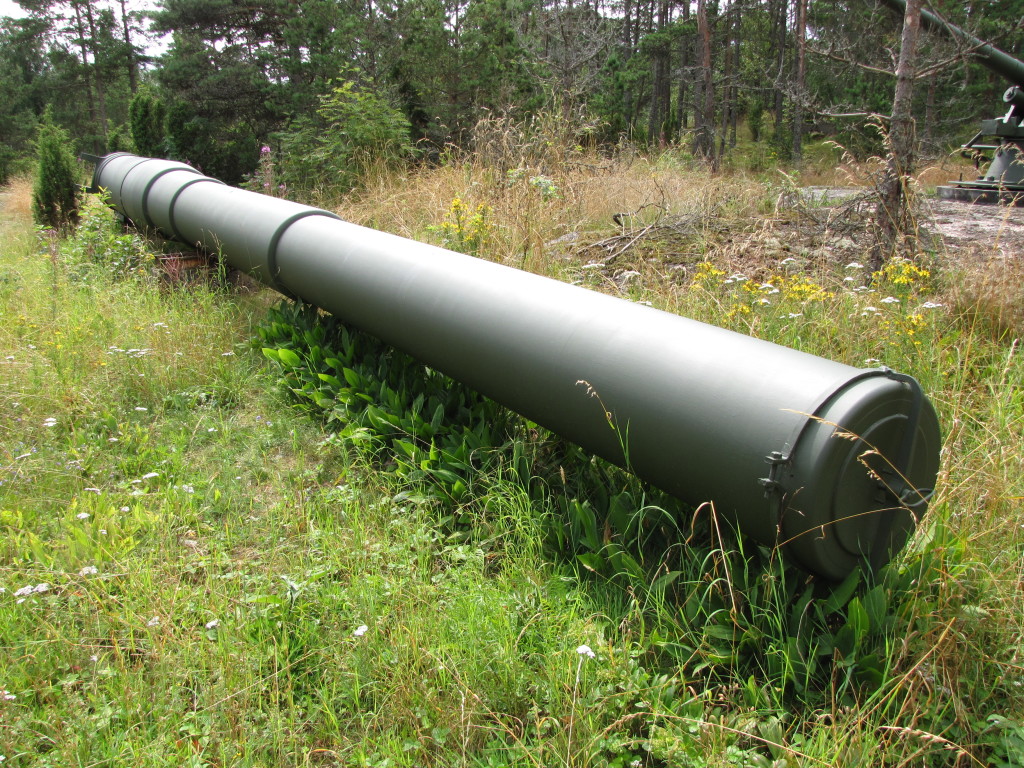
A second spare 305mm barrel on Kuivasaari Island. Toinen 305mm varaputki.
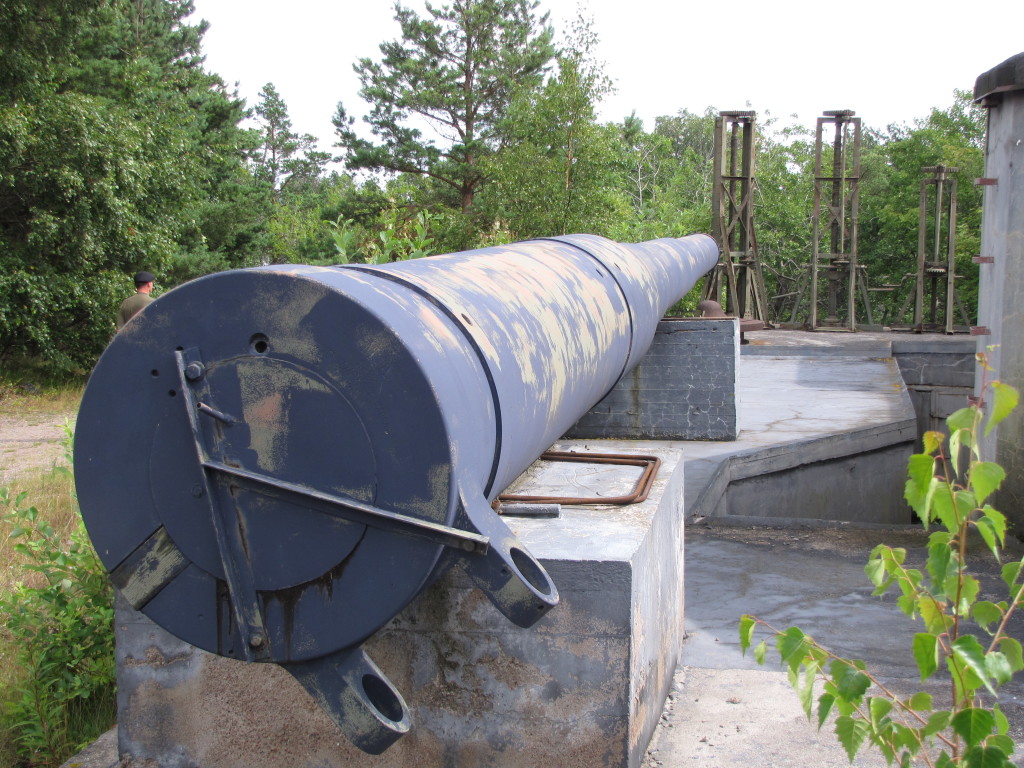
305mm varaputki / 305mm spare barrel – one of these two spare barrels is from the old Tsarist battleship Imperator Aleksander III that finished its life in the French port of Bizerte in Tunisia.
In the spring of 1931 the Ministry of Defence granted funds for the construction of two double-barreled turret positions “305/52 O2” (Obukhov), one on Mäkiluoto and one on Kuivasaari. The financing needed for the building of the gun turrets onto Mäkiluoto and the Kuivasaari Coastal Artillery Fortress was directly linked to secret Finnish – Estonian military co-operation, which if needed (if either country was attacked by the Soviet Union) was intended to block access by the Soviet Baltic Sea Fleet Navy from Kronstadt into the Baltic Sea. At least in theory the Finnish 305-mm dual gun turret on Mäkiluoto Island and the two Estonian 305-mm dual gun turrets on Aegna Island were intended, with the help of other coastal artillery, minefields, coastal defence ships and submarines, to close the Gulf of Finland on the Tallinn – Porkkala peninsula line. While the Mäkiluoto gun turret had this sort of international strategic importance, the Kuivasaari gun turret was intended mainly for boosting the coastal defences of the Finnish capital – Helsinki, which until then had been defended by coastal artillery batteries equipped with 254/45 D guns.
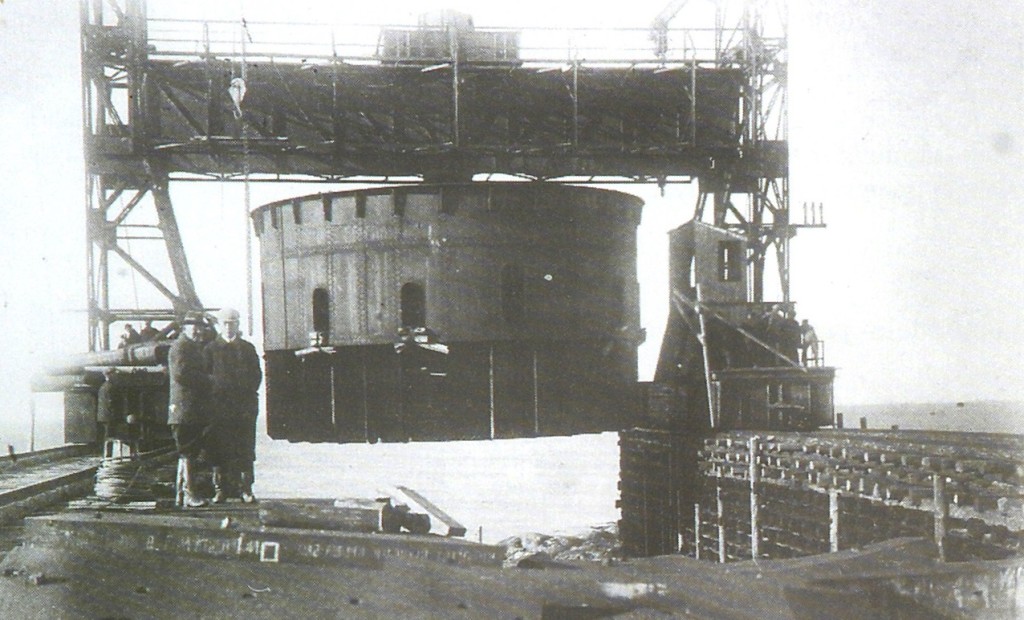
The hard work of moving a 100-ton cylindrical part of the gun turret for the Kuivasaari Coastal Artillery Fortress
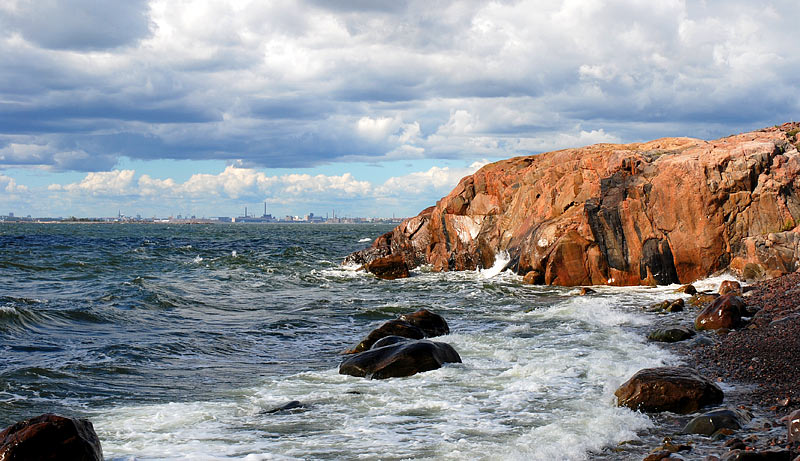
Heksinki as seen from Kuivasaari. Kuivasaari translates as “Dry Island” – I’ve seen two stories about the name. One, that it’s called Dry Island as a joke because for most of the year it rains there. The other that it’s because there’s no fresh water there. Kuivasaari was chosen as a battery site because it covers one of the sea approaches to Helsinki. (Photo courtesy of Northern Fortress website – www.nortfort.ru)
Work first began on Mäkiluoto (an island in the Gulf of Finland, south of Porkkala peninsula). Both fortresses were to get a modern dual gun steel turret. During the First World War the Russian military had been building a 356-mm coastal artillery battery on Mäkiluoto Island, and while the guns never arrived on the island, two incomplete dual gun steel turrets intended for the purpose had been brought there and were now put to good use. The turret that was closest to completion was used on Mäkiluoto and modified for two 305-mm coastal guns. The resulting Mäkiluoto gun turret was test-fired in 1933, but according some sources building it was not totally completed until 1935.
The building of the second dual gun turret onto Kuivasaari Island took considerably more work. Due to only one crane being available, work on Kuivasaari Island was not started until heavy work that required lifting of heavy materials had been finished on Mäkiluoto. The turret foundation was quarried into the bedrock in one of the gun pits of the earlier Russian built battery fronts constructed of massive concrete massive for the 254/45 D coastal guns. Once construction work for the turret foundation was completed, the turret ring weighing about 100 (metric) tons was transported from Mäkiluoto to Kuivasaari on a coal barge in December of 1931. Once the turret ring had been safely transported to Kuivasaari Island and installed on the turret foundations, transport of the other heavy parts could be started.
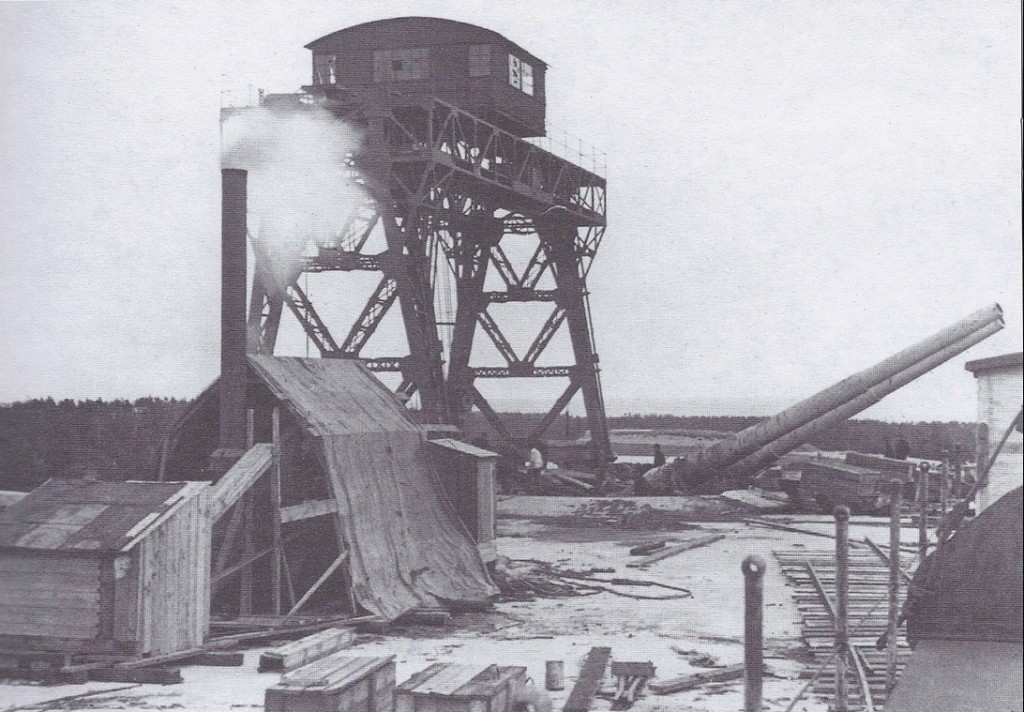
The dismantling of the 12″ Guns at Ino post-WW1. One of the strongest forts of Kronstadt – “Eno” – was also in the territory of an independent Finland. In April 1918, the German expeditionary force landed in Koivisto (Primorsk) and blockaded the fort from the land. After several unsuccessful attempts to resolve the situation through diplomatic channels, the garrison left the fort “Ino”, blowing up its basic structure. Despite the fact that concrete batteries were destroyed by the explosion, the Finns got the 12 inch Obukhov guns, cupola, electrics and pneumatic equipment It was conserved and put in storage.
The battery was fitted out with equipment and devices from many sources – Finland itself, Estonia, Tzarist Russia and even from the Soviet Union. Some equipment Finland had to manufacture on its own: the ammunition lift and winches were built by Strömberg Oy Karhula Oy, Helsinki while the Finnish company Kone ja Silta Oy manufactured the armor elements. For the sake of reducing costs of the project made some trade-offs were made: the maximum angle of elevation of the guns was reduced, shells and charges were supplied to the elevator on the carts. The total cost estimate was 3.5 million markka. Under the gun turret there is a 19 meter deep shaft with 5 decks that was excavated out of the rock. Nowadays, and after restoration, all metal surfaces are painted thoroughly and covered with oil to prevent corrosion.
At the same time the tower with the fire control system and an optical rangefinder was built. The Kuivasaari Coastal Artillery Fortress Turret was inaugurated 5th December 1934 and was in shape for shooting in 1935. Both of these turrets represented the kind of firepower that prevented the Soviet Navy from approaching Helsinki during both the Winter War and the Continuation War. Kuivasaari’s war-time combat was limited to firing one harassment target shoot in 1941, when a Soviet evacuation transport ship was glimpse
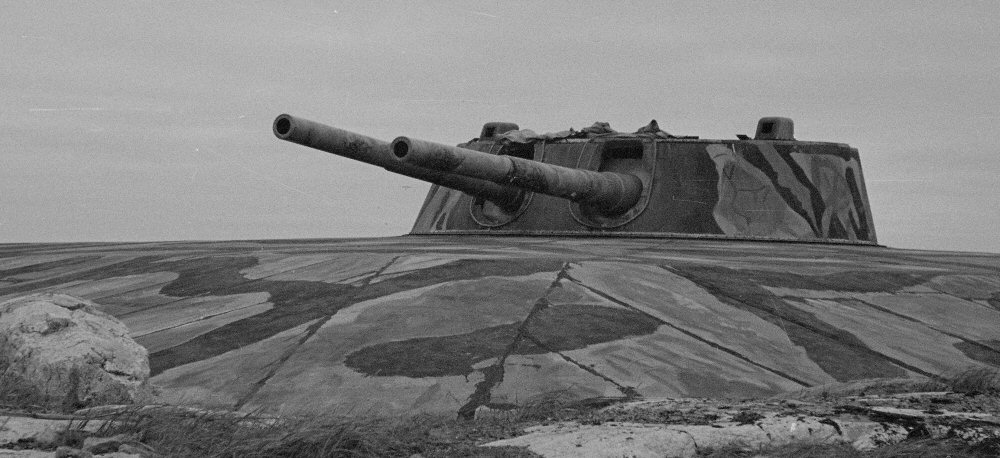
Mäkiluoto dual gun turret with its two 305/52 O guns. Photo taken in September of 1941. (SA-kuva photo archive, photo number 51927). Photo courtesy of Jaeger Platoon Website (www.jaegerplatoon.net) and SA-Kuva
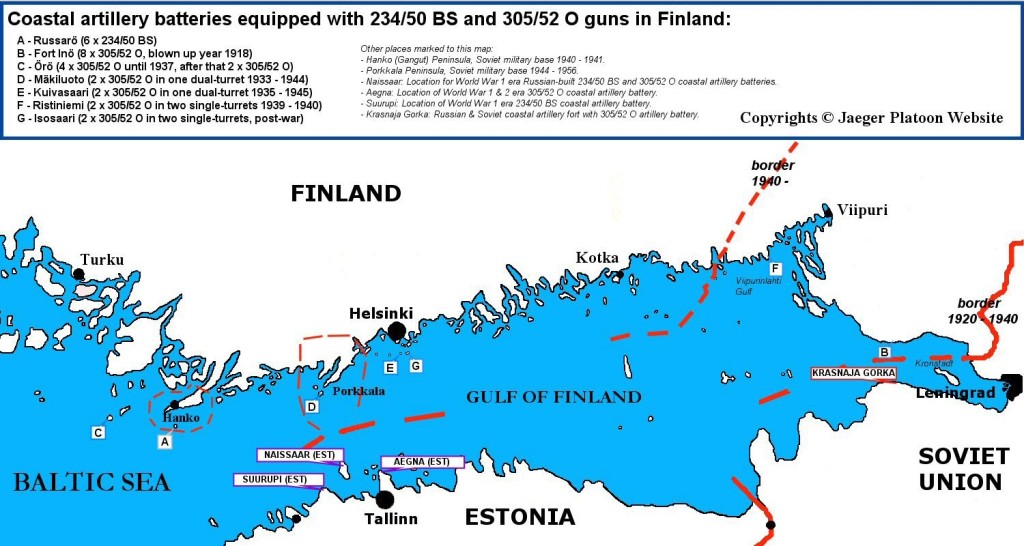
Map showing historical locations of 234-mm and 305-mm coastal artillery batteries in Finland (Map courtesy of Jaeger Platoon website – www.jaegerplatoon.net)
As of December 1939, Örö Island was equipped with 2 x single 305/52 O guns, Mäkiluoto Island was equipped with one dual 305/52 O turret, Kuivasaari Coastal Artillery Fortress was equipped with one dual 305/52 O turret and Ristiniemi Cape was equipped with 2 x 305/52 O guns in single gun turrets. The 305-mm coastal artillery batteries on Örö, Mäkiluoto and Kuivasaari did not see any real combat use during the Winter War. The guns of Ristiniemi coastal fort on the western shore of Viipurinlahti Gulf were lost, with their remains found as they had been left when the Finnish Army recaptured the area at the beginning of the Continuation War in the summer of 1941. Örö, Mäkiluoto and Kuivasaari remained in Finnish hands and saw active use against the Russians in the Continuation War (1941 – 1944).
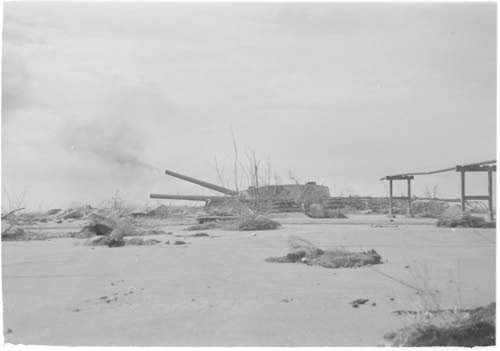
Kuivasaari turret firing / Kuivasaaren torni ampuu – 28 June 1942
After the signing of the 19 September 1944 Moscow Armistice Agreement and the arrival of the Allied Control Commission, the gun was transferred inland to Parola Armor Depot on the basis of requirements of the armistice agreement and Soviet demands made through the Allied Control Commission at the end of 1944. The gun position was demolished over February-March, 1945. However, the Paris Peace Treaty in 1947 freed Finland from the authority of the Allied Control Commission.
In 1949 it was reported that the heavy coastal artillery guns should now again be transported into place and the bastions rehabilitated. Even with the change in the political situation, it took until 1959 to make the political decision to return the super-heavy coastal guns back to the coastal fortresses.The Defence Council made a decision in principle on 10 September 1959, concerning the return of heavy coastal artillery to Isosaari and Kuivasaari. In July 1960 the gun components were transferred to Kuivasaari. The turret renovation work began on 27 July 1960 with the dual turret again operational from June 1961. The first successful firing was carried out in December 1961.
The Kuivasaari gun turret was used for more than ten years, remaining in use until its electrical systems deteriorated to an unacceptable level in the early 1970’s. This was largely due to lack of repair and as money was short a firing prohibition was ordered. The parliamentary defense committee said in a report of 26 June 1971 that “…defensive missiles eliminated the need for large coastal artillery guns.” For the Coastal Artillery districts, this meant that the need for large guns was over as missiles were seen as replacing these. Finally, the Kuivasaari Coastal Artillery Fortress guns were decommissioned in the 1970’s along with other heavy-duty gun batteries. With the withdrawal of these guns from active service, an era ended.
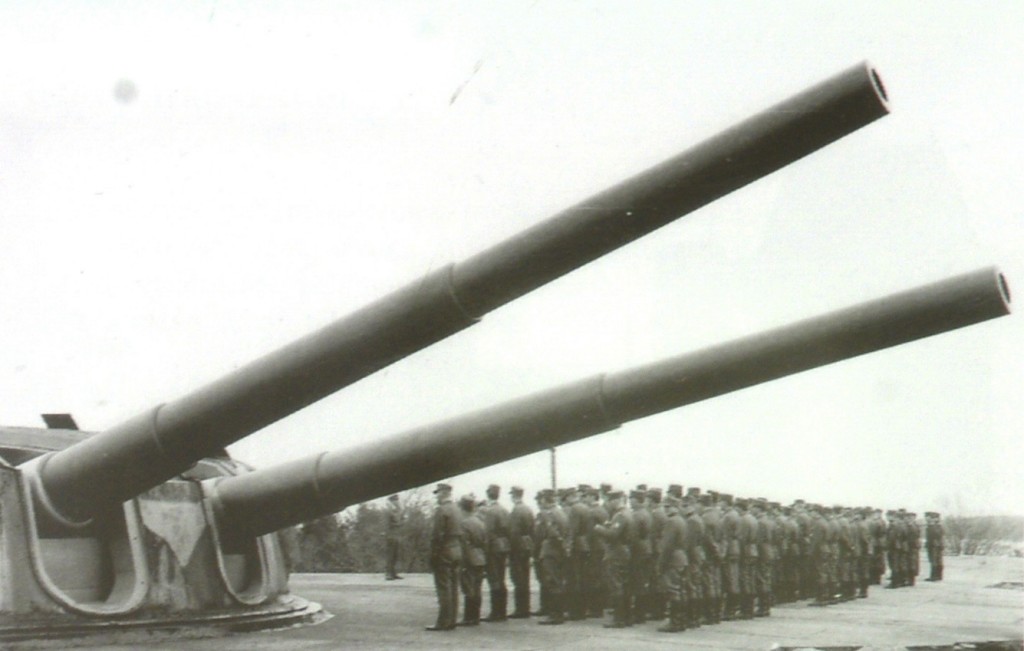
Kuivasaari gun turret with men on parade – 1967
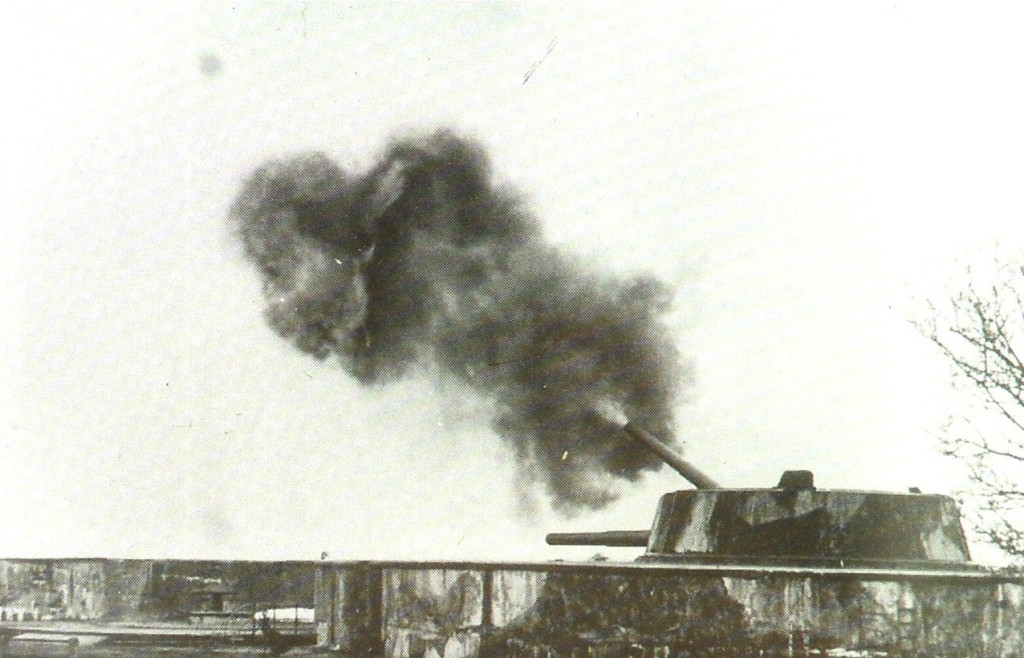
Kuivasaari turret firing / Kuivasaaren torni ampuu – 1967
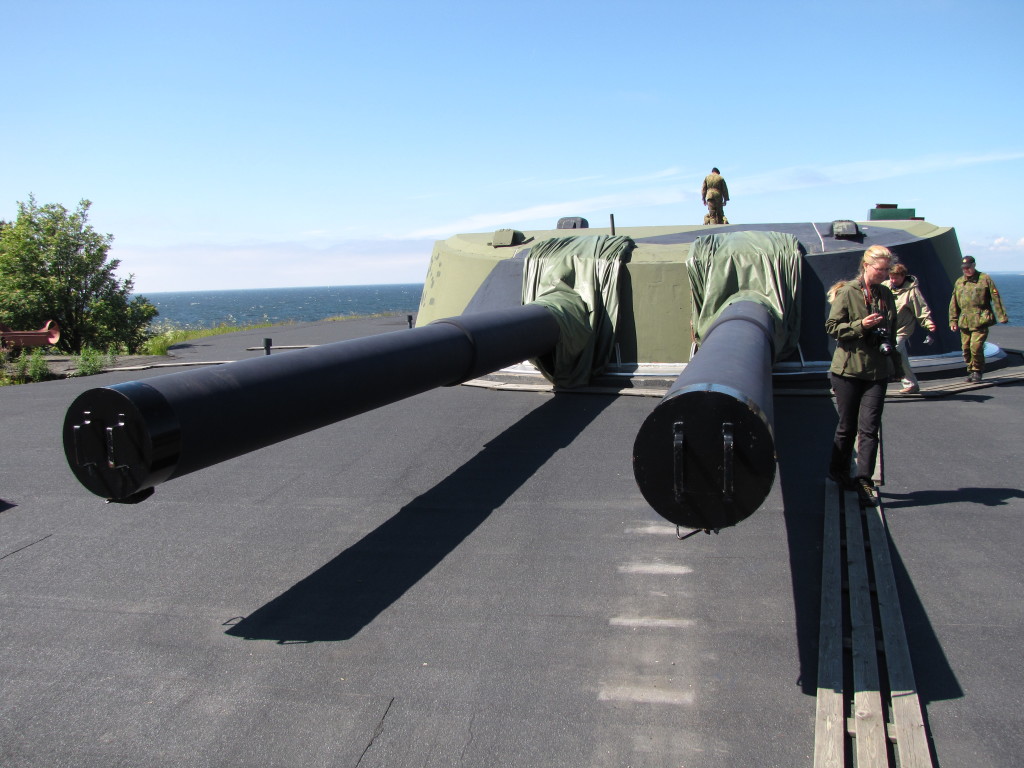
305 mm 52 caliber twin coastal artillery turret in Kuivasaari. This turret was constructed by Finns between 1931 and 1934 by using 305 mm (12 inch) guns from Ino and an unfinished 356 mm (14 inch) twin turret barbette from Makiuloto Island. Construction was finished in 1934.
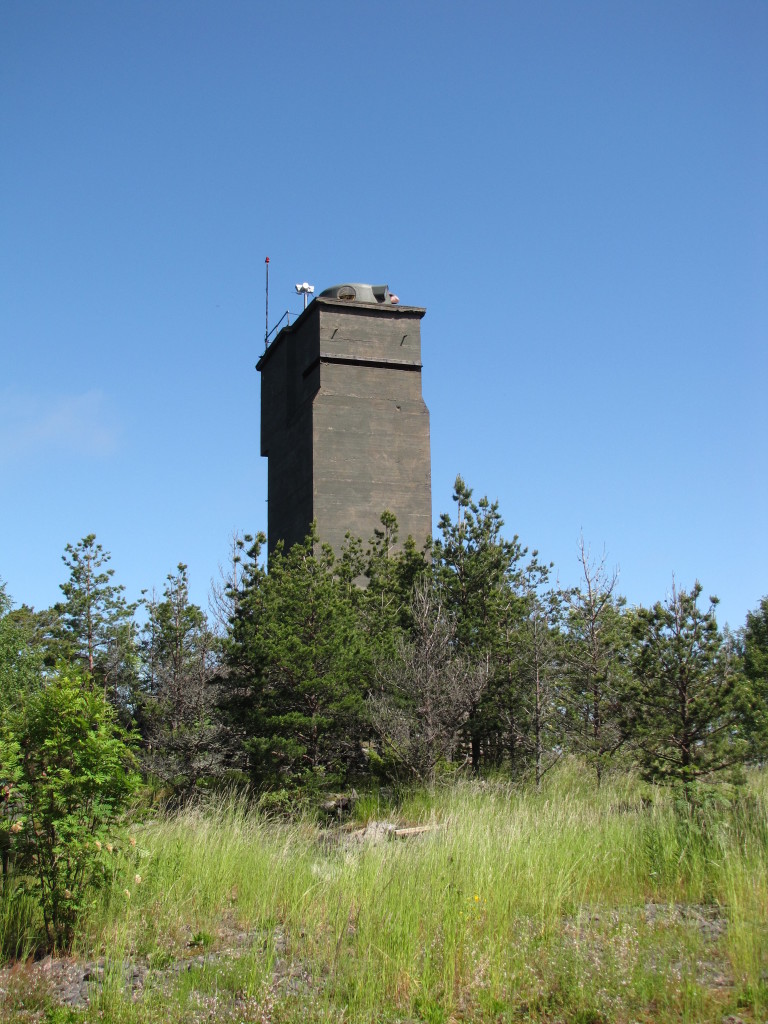
The Kuivasaari Coastal Artillery Fortress fire control tower, the so-called “Rikama’s boot” nicknamed after lieutenant colonel Johan Rikama, is a standard Finnish coastal artillery fire control tower type from 1930s. The green round shape on the top is plastic covering for the RADAL radar system (Rannikotykiston Digitaalinen Ammunnan Laskin – Digital Control of Coastal Artillery) – introduced 1970’s
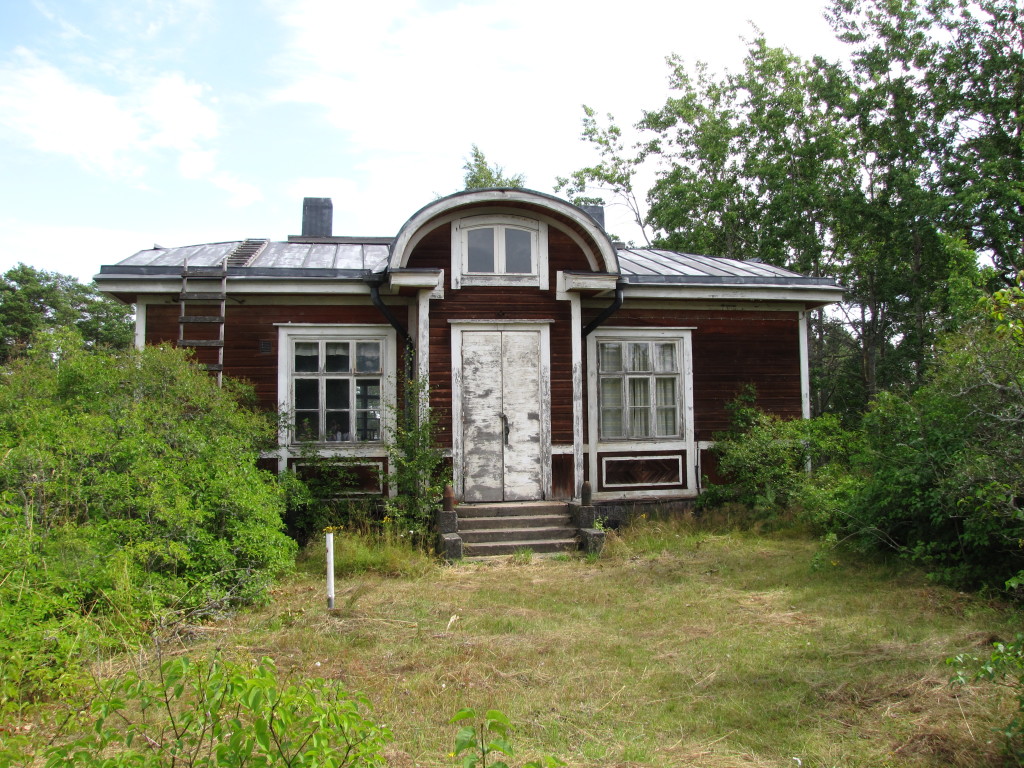
Kuivasaari coastal artillery fortress – the old commander’s house dating from 1910. / Kuivasaaren vanha komentajan asunto vuoden 1910 tienoilta.
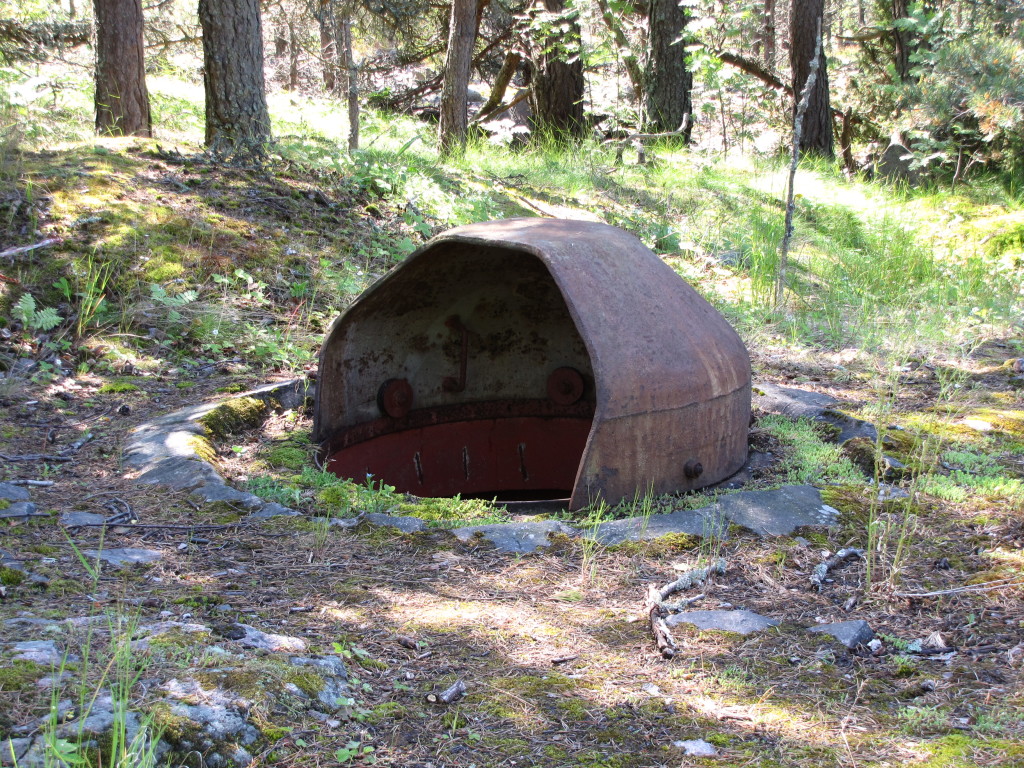
Rifle pit with rotating armour shield on Kuivasaari island. Kivääripesäke.
There are numerous elements of anti landing defence on the island. The rifle-pit with armour shield is in the picture. The shield can be rotate. The armored shield was actually known officially as a “pyörivä konekiväärikilpi” (“rotating machinegun-shield”). It was developed in 1942 – 1943 and introduced into production in 1944. Some 140 were issued by the end of the Continuation War. It was designed primarily for Maxim-machineguns, but could be used also with light machineguns. It was only intended to provide protection against small arms fire and shrapnel. A rifle-man can escape in an emergency through an underground tunnel…the passage connects the rifle-pit with an underground shelter at 6m depth. The long gallery below leads to the 12″ gun battery also.
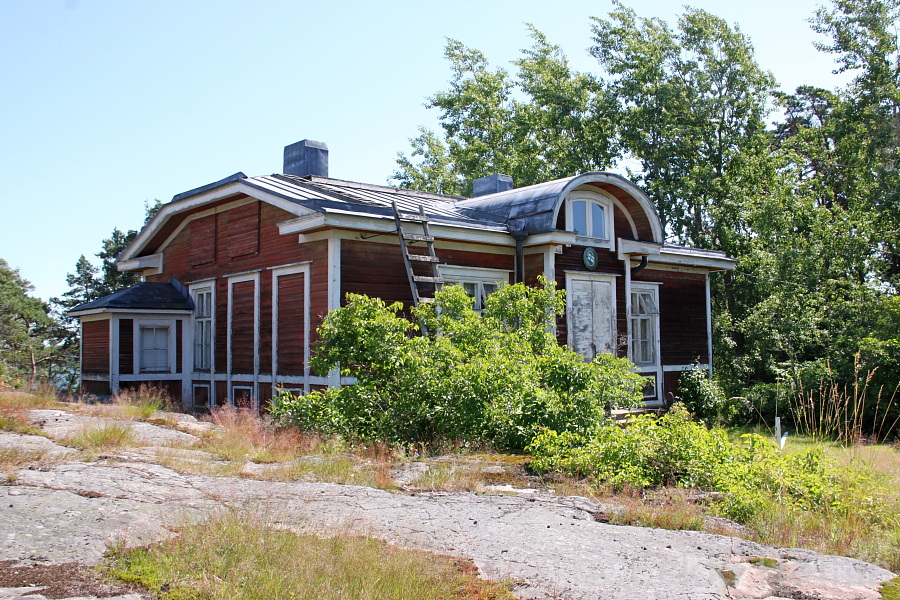
Kuivasaari coastal artillery fortress – another view pf the old commander’s house dating from 1910. / Kuivasaaren vanha komentajan asunto vuoden 1910 tienoilta.
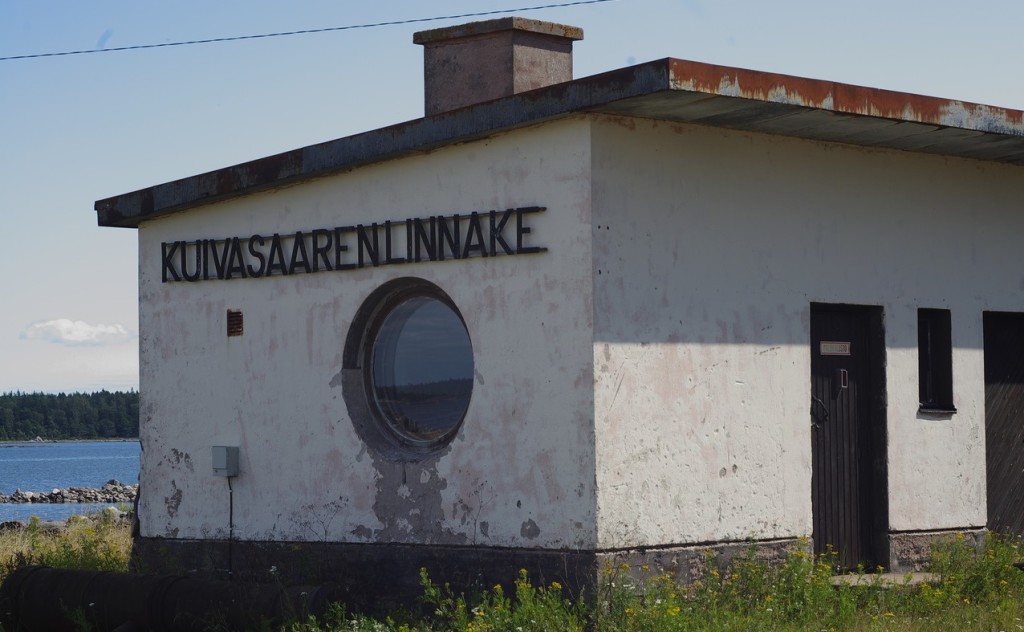
Kuivasaari coastal artillery fortress – another building on Kuivasaari
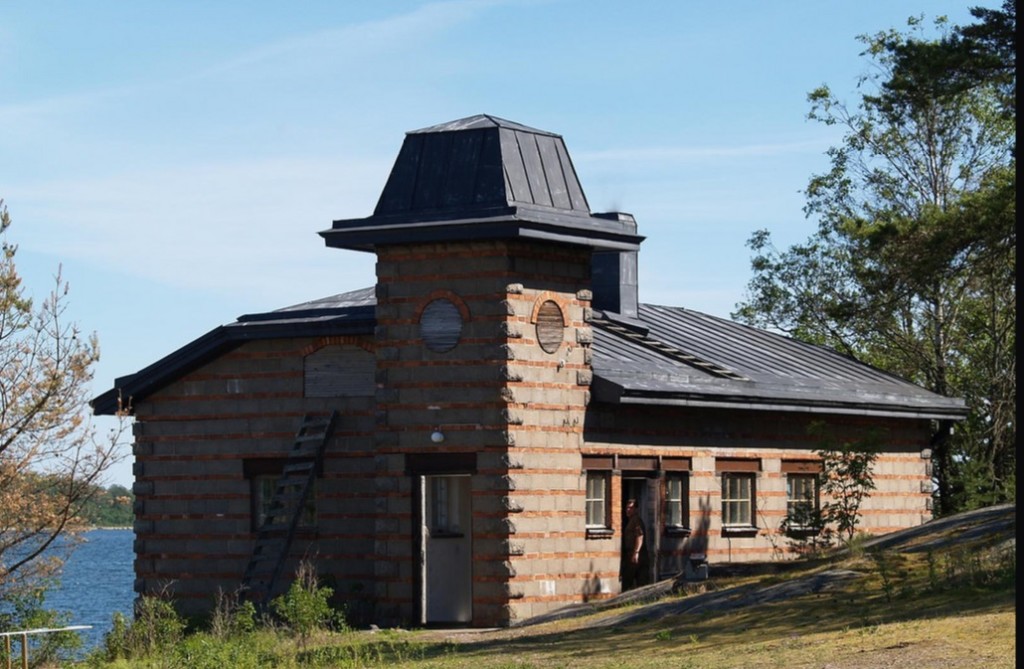
The Sauna on Kuivasaari Island
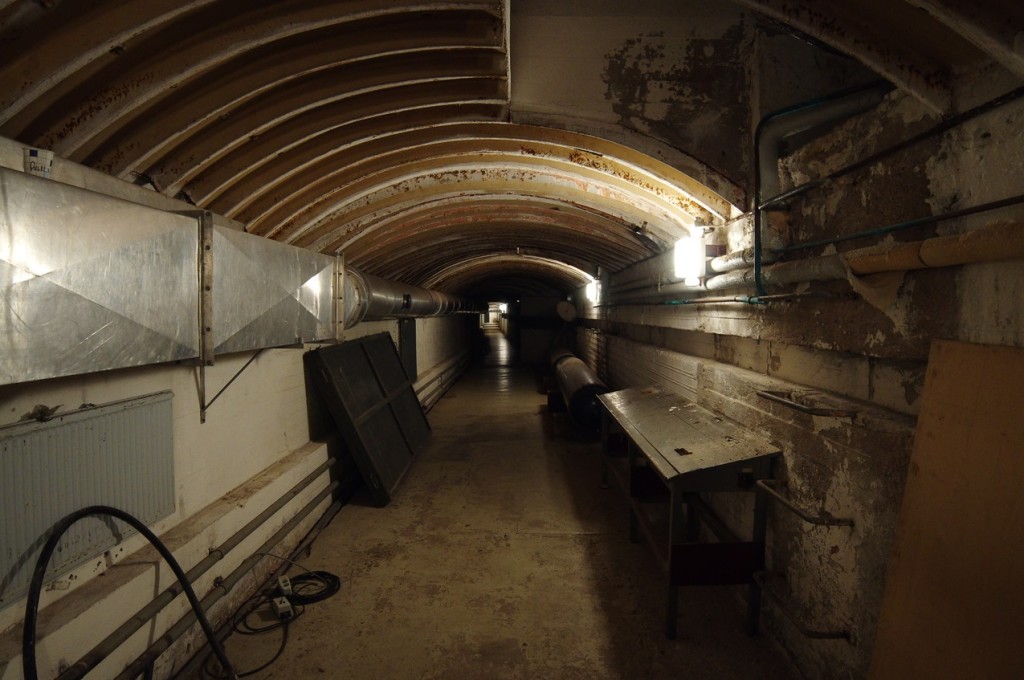
Beneath Kuivasaari, tunnels carved into the rock connect the main battery to some of the buildings. The gallery’s ceilings has armour anti splinter covering.
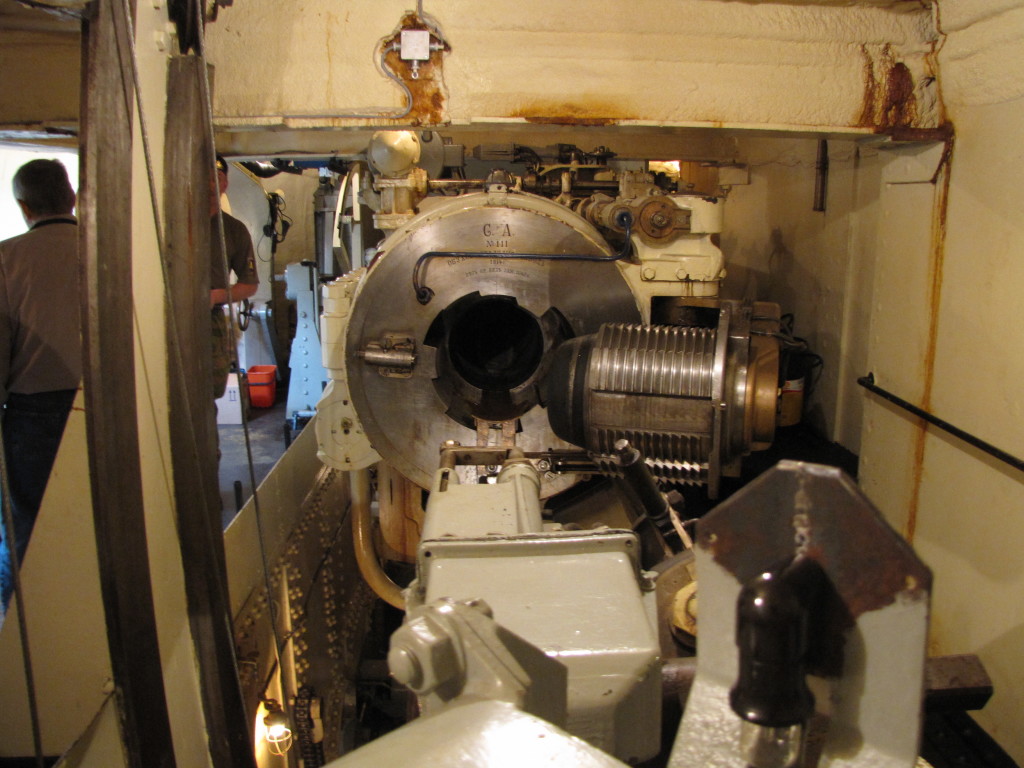
Kuivasaaren patterin toisen tykin lukko. Tykkien kranaatit painoivat noin 500 kg. The 305/52 gun breech. Each shell weighs 500kg.
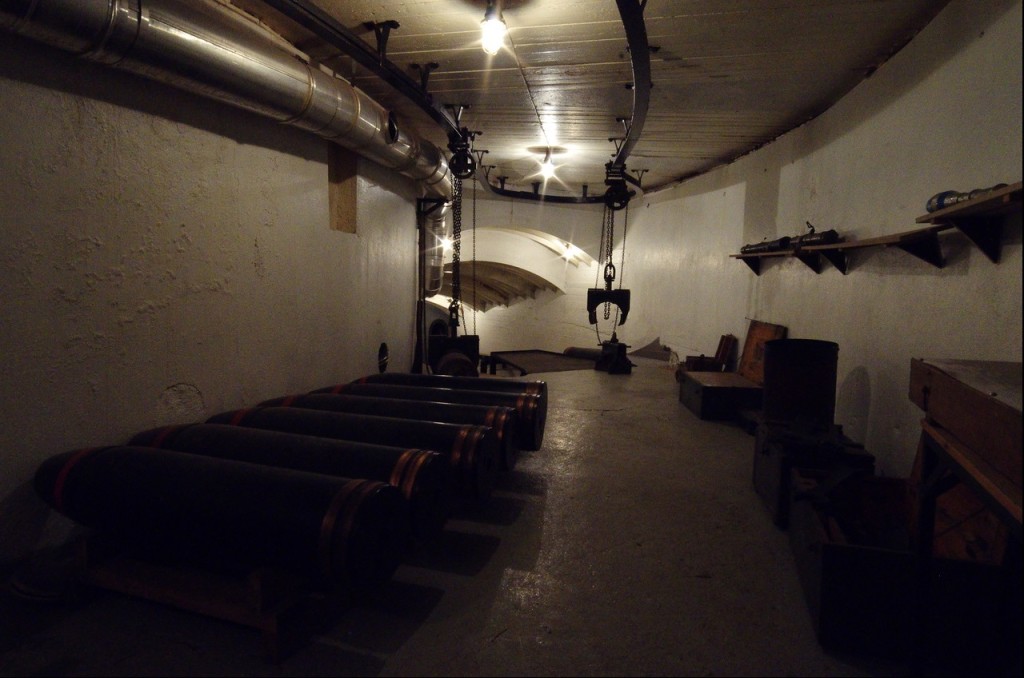
305 mm shells painted black color. These projectiles are designed for target practice. Explosives have been replaced by an equal weight of filler. Shells are delivered with a special winch to the trays, leading up to the reloading level of the turret.
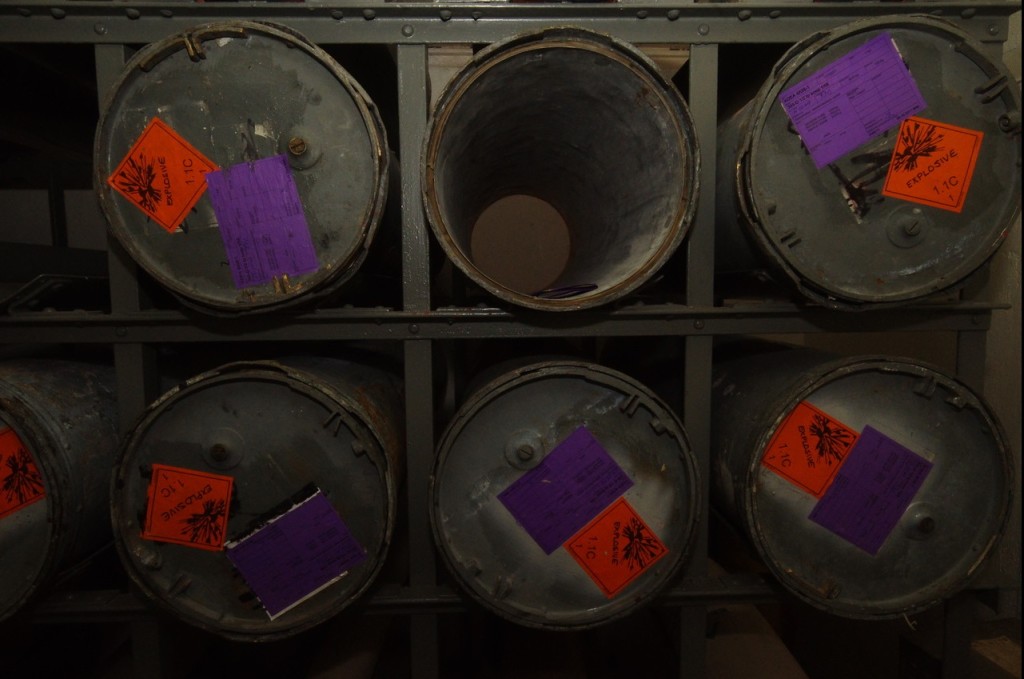
Racks with charges for the gun. Each half charges is stored in a canvas case and metal tube and has a weight of 85.6 kg.
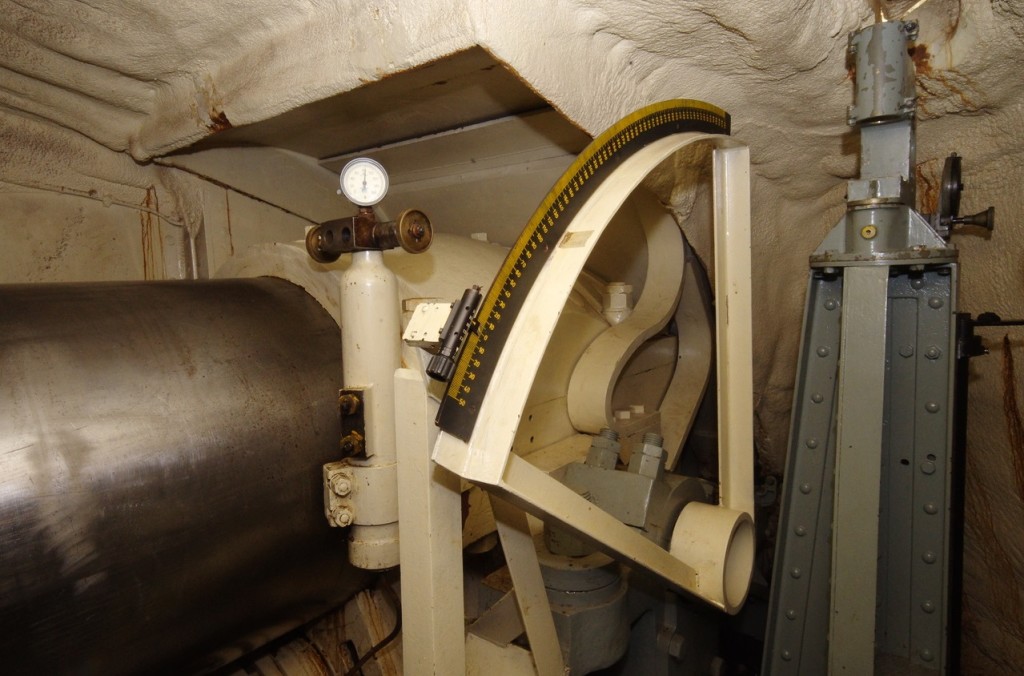
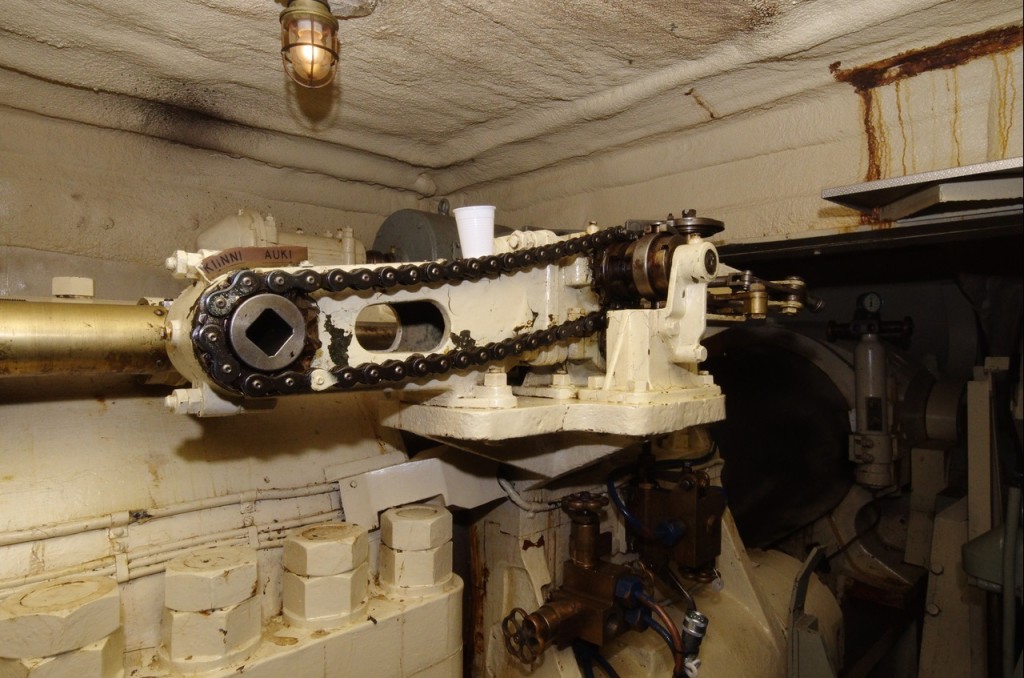
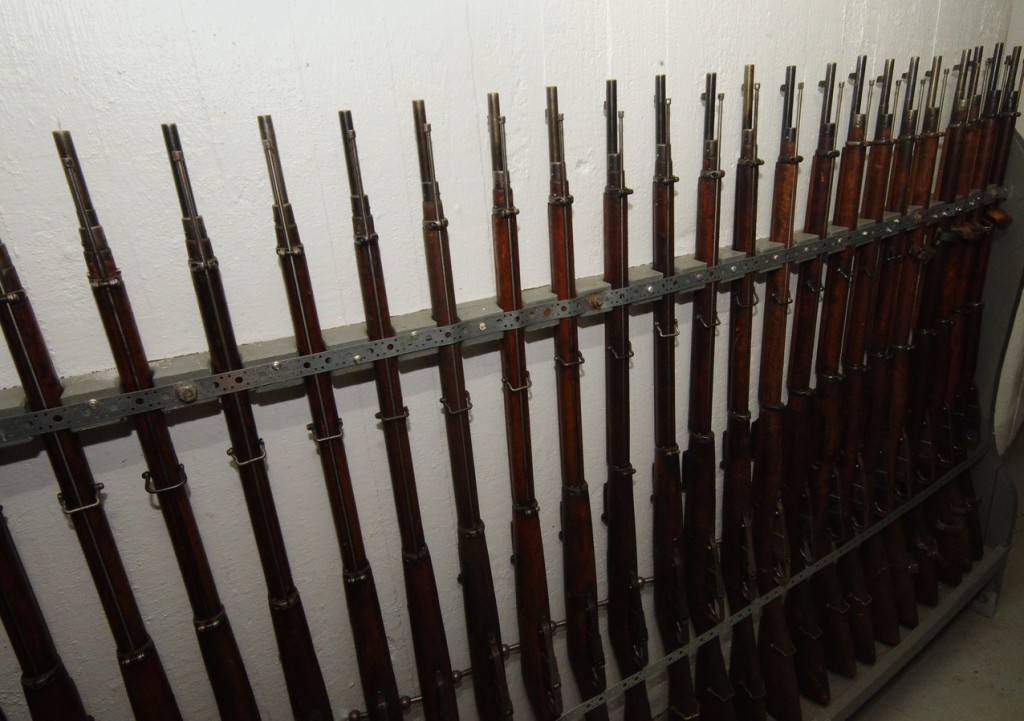
The historic arsenal – rifles of the battery crew. These are 7.62 Mosin-Nagant rifles.
The Kuivasaari Coastal Artillery Fortress 305/52 O Guns (305 mm / 12 inch coastal gun with 52 caliber barrel, model 1907 Obukhov)
The Obukhov 305mm (12 inch) guns with which the main gun turret in the Kuivasaari Coastal Artillery Fortress is now equipped were the most powerful coastal artillery guns in Finnish use. Nine of these powerful guns were captured in 1918 and by the time of the Winter War of late 1939, eight of them had been taken into active service. The Obukhov guns themselves were built to a Russian design and were used on Russian Battleships as well as for Coastal Artillery and as Railway Guns. They were also the most powerful gun ever used on a completed Russian or Soviet warship, so the Finnish military was indeed fortunate to have nine of them fall into their hands in independence.
The design itself dates back to 1906, where the design was completed at the Obukhovski Plant in St Peterburg, a major Russian metallurgy and heavy machine-building factory. It was founded in 1863 to produce naval artillery based on German designs by Krupp and has been a major producer of artillery and other military equipment ever since. In 1992 it was renamed Bolshevik Plant No. 232. The Leningrad factory’s historical name was restored in 1992 by the formation of a unitary enterprise, FSUE Obukhov State Plant. In 2002 it became part of the Almaz-Antey military industrial concern, and in 2003, it became a joint-stock company, OJSC GOZ Obukhov Plant.
Here’s a collection on Youtube of photo’s of the pre-WW1 Obhukhov Factory in Saint Petersburg
Returning to the 305/52 Pattern 1907 Gun, the design was completed in 1906 and a prototype finished in 1907. An initial order for twenty guns was placed by the Imperial Russian Navy at the end of 1907, with 178 more ordered in the years following. Of these, 126 were actually delivered prior to 1917 (some sources say 144). Over 1917-1918 a further 42 guns were delivered but at that point the Russian Civil War saw production brought to a stop until 1921, when another 14 guns were completed and delivered.
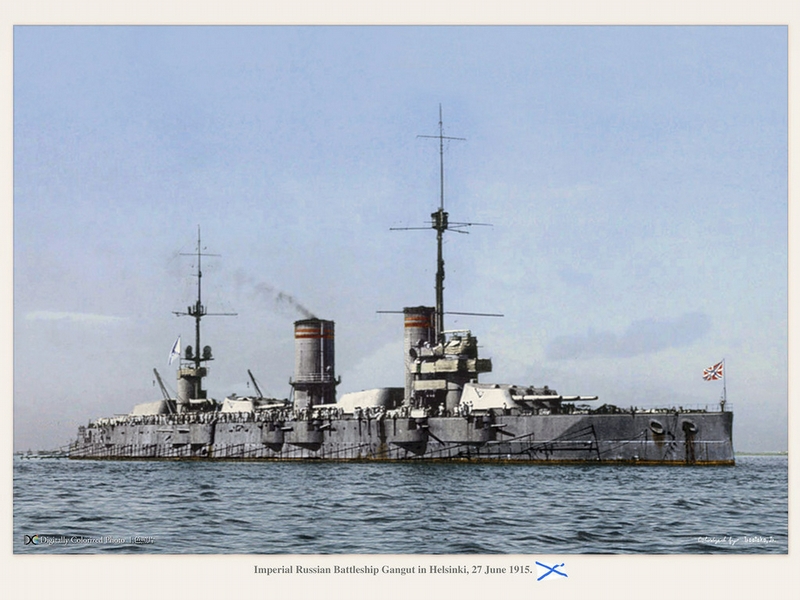
Imperial Russian Navy Battleship “Gangut” in Helsinki, 27 June 1915.
Allowable barrel life for pieces mounted aboard Black Sea Fleet units was 400 rounds per gun (the Finish military expected the same barrel life from their Obukhovskii barrels). The guns were considered excellent pieces, and were deployed aboard the Gangut and Imperatritsa Mariya class dreadnoughts in triple turret mountings designed and constructed by the Metallicheskii Works. These triple-gun turrets were designated “MK-3-12”. The battleships armed with these guns were known for their excellent shooting during World War I.
Gangut Class battleships built for the Baltic Sea Fleet included the Gangut (Oktyabrskaya Revolutsiya), completed 1914, the Petropavlovsk (Marat), completed 1914, the Sevastopol (Parizkaja Kommuna), completed 1914 and the Poltava (Frunze), completed 1914. The Imperatritsa Mariya class battleships, built for the Black Sea Fleet, included the Imperatritsa Mariya, completed 1915, the Imperatritsa Ekaterina Velikaya (Svobodnaja Rossiya), completed 1915 and the Imperator Alexandr III (Voliya / General Alekseyev), completed 1917.
During her engagement with the German/Turkish battlecruiser Goeben/Yavuz on 8 January 1916, Imperatritsa Maria, firing into the sun at a range of about 20,000 meters, landed her first three salvos at 500, 100 and 50 meters short of the Turkish ship. As this distance was outside of her range, Yavuz was forced to run for home, pursued by the Russian dreadnought. Yavuz’s commander, Captain Richard Ackermann, later reported that “Imperatritsa Maria can run and shoot.” On 4 April 1916, Imperatritsa Maria’s sister-ship Ekaterina II straddled and then knocked the stem off the German/Turkish light cruiser Breslau/Midilli at about 21,000 meters.
In addition to being deployed aboard the Gangut class and Imperatritsa Mariya class battleships, these pieces were also emplaced as coastal artillery in the “Peter the Great” Naval Fortresses along the Tallinn-Porkkala (Gulf of Finland) defensive line in 1917, as well as being mounted as railway guns. Between wars the Soviet Union placed four four-gun batteries around the Baltic. The coastal artillery version of the gun had a larger chamber volumes and used different ammunition, although it could fire naval rounds. Likely as a way of saving cost many of the guns issued to coastal artillery were installed in barbette type open positions as the battery arrangement.
The Imperial Russian Battleship “Sevastopol” 1909-1915, a Gangut class battleship whose main armament was the Obukhov 305mm (12 inch) guns, built for the Baltic Sea Fleet
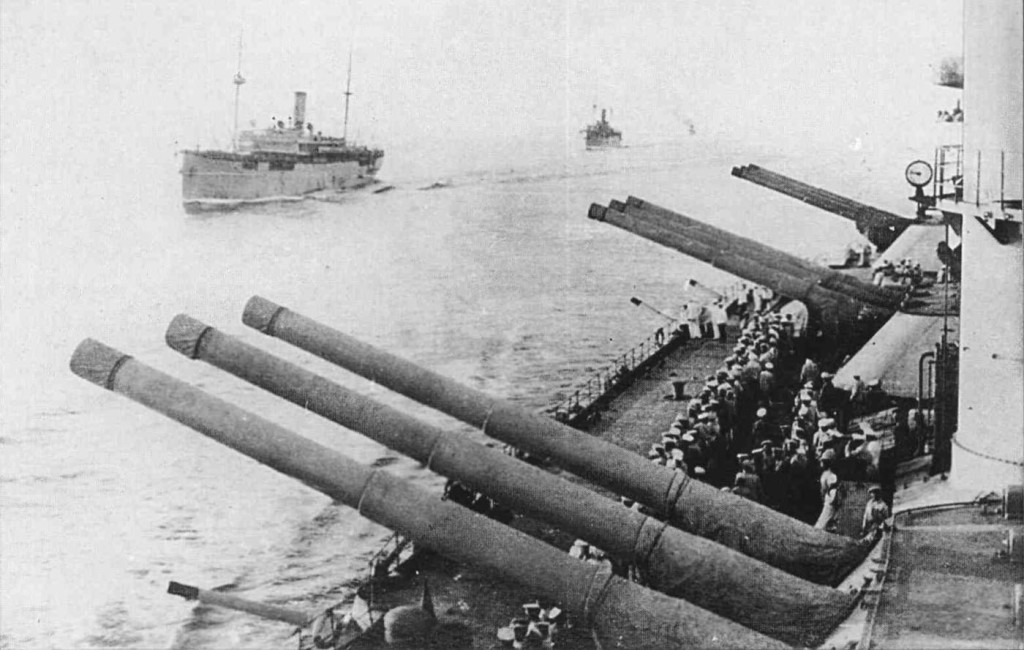
The Obukkhov 305mm guns of the Tsarist Battleship Imperatritsa Ekaterina Velikaja in the First World War. In 1918, the ship was known as Svobodnaja Rossija
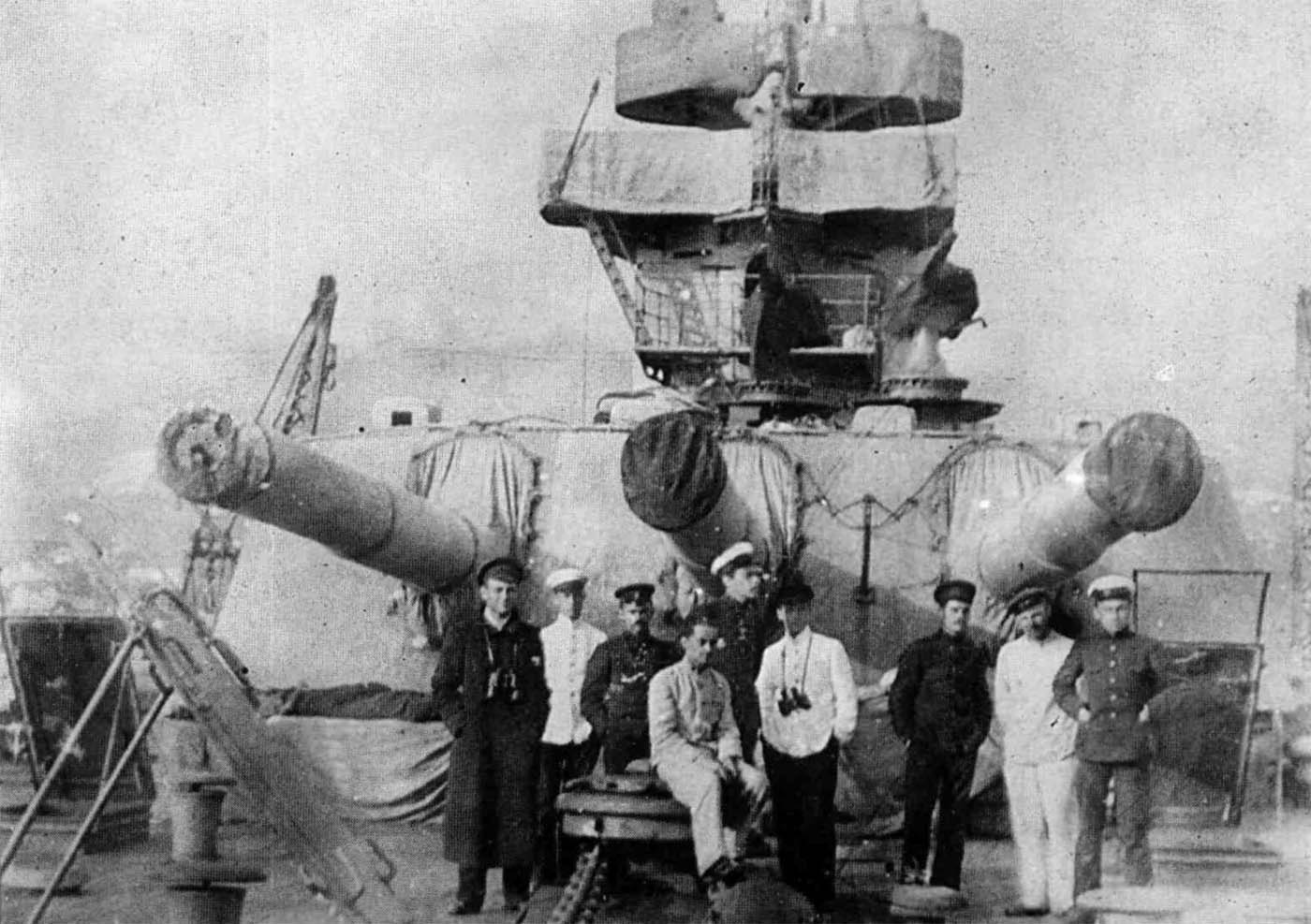
The 305mm guns of the Svobodnaja Rossija, 1918
Early on there were plans for installing these coastal guns in steel turrets, with eight dual steel turrets ordered for that purpose from St. Petersburg Metal Factory by 1910. Two of these dual turrets were intended for the Krasnaja Gorka coastal fort and another two turrets for the Ino coastal fort (in Finland). Both the Russian Main Artillery Administration (GAU) and the Naval Administration organised their own planning competitions for steel turrets intended for use by coastal artillery around 1911 – 1913. It seems likely that due to material and/or manufacturing related problems caused by World War 1 the resulting turrets did not see wide-spread use.
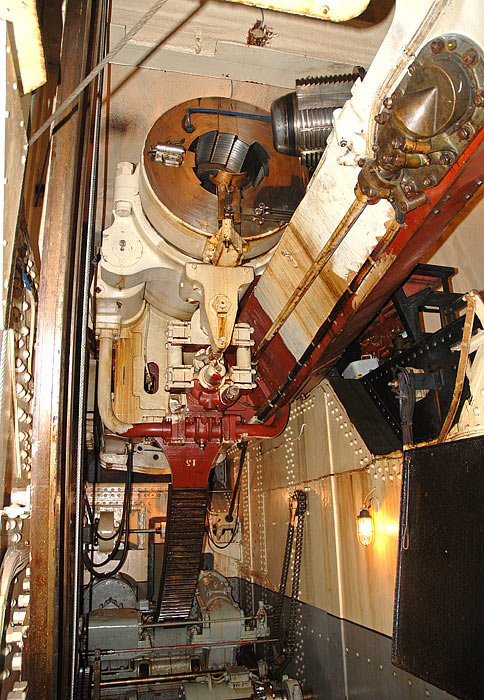
The interior of the turret. The breech end of the gun with open lock is seen. The inscription on the barrel says: “Obukhovskiy Steleliteyniy Zavod (Obukhovskiy Steel Plant in St.Petersburg), 1911, S.A. (land artillery), N 105, 52 K (length of barrel in calibers)”. Photo courtesy of Northern Fortress website – www.nortfort.ru
The Russian revolution brought to a halt plans concerning their use in 1917. In 1915 the Russian Naval Administration reverted to its plan for installing 305-mm guns in steel turrets and started installing them in open positions en barbette with single gun mounts originally introduced by the St. Petersburg Metal Factory in 1910. One can only presume that the reason for this decision was related to steel turrets not being available and the en barbette solution was considered better than nothing. Admittedly, this sort of arrangement was probably also cheaper, faster to manufacture and quite likely also more reliable to operate than an untested new steel turret design.
What is known suggests that at least three super-heavy coastal artillery batteries, each equipped with four guns, were built during World War 1. However the plans concerning gun turrets were not completely abandoned either – apparently an additional 14 dual turrets were placed under construction during World War 1 – although it remains uncertain how many of them actually completed. The massive construction work involving the building of the Peter the Great’s Naval Fortress was far from complete when the Russian revolution stopped all work in 1917. What is known is that not all the 305-mm coastal artillery batteries built en barbette style were completed by that time. From all of those 305-mm coastal artillery batteries that the Russian military had intended to be built in Finland, only the ones built in the Ino coastal fort were fully completed in 1917.
When Finland declared independence in December of 1917 there were only two coastal artillery installations equipped with 305/52 O guns in Finnish territory. These were:
- the Ino coastal fort (Carelian Isthmus):
- 4 x 305/52 O gun in two dual turrets.
- 4 x 305/52 O as single guns in barbette-type open positions.
- the Örö coastal fort:
- 4 x 305/52 O as single guns in barbette-type open positions.
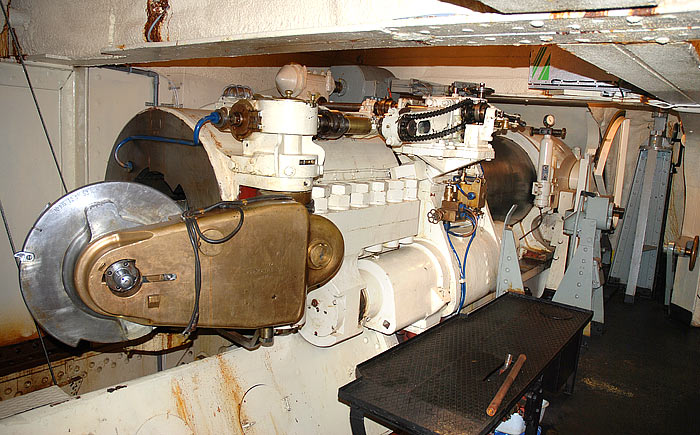
A side view of the breach end of the Kuivasaari gun from the gun deck inside the turret. Photo courtesy of Northern Fortress website – www.nortfort.ru
Apparently both the 305-mm artillery batteries in the Ino coastal fort had become operational before the Russian revolution stopped all fortification building work in 1917. The 305-mm artillery battery on Örö Island was not such a clear-cut case. The Russians had begun building of the Örö super-heavy coastal artillery battery in January of 1915. Originally the battery had been intended to be equipped with four 234/50 BS guns, before the plans changed for four 305/52 O guns. The Örö artillery battery, or Artillery Battery 60 as the Russian military called it, became operational in spring of 1916, but as a whole its construction was still incomplete when the Russian revolution started. By that time the guns had been installed and could be operated manually, but electrical systems were still missing and certain parts of the construction work had not been finished.
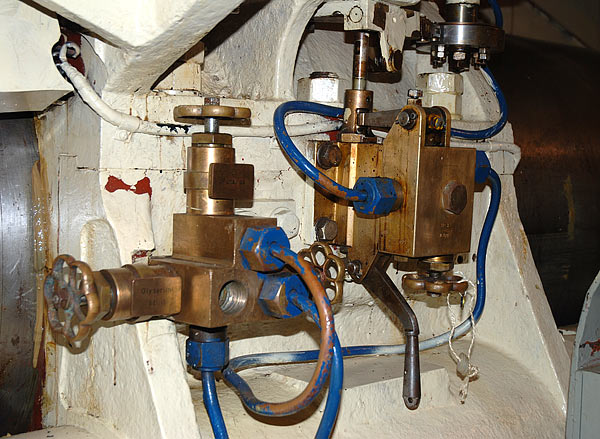
This photo is of the compressed air purge system for the barrel. After each shot, the barrel must be vigorously blown out with compressed air, so that the byproducts of combustion of the gunpowder do not get inside the turret. The air blast also cleans some residue from the inside of the barrel. Photo courtesy of Northern Fortress website (www.nortfort.ru)
When the Finnish military took over these coastal forts in 1918, it took neither of them into immediate use. The 14th of May 1918 was the last day of the Finnish Civil War, but was also the day on which the Russian military abandoned the Ino coastal fort and blew up its guns. Hence all its coastal artillery batteries were either damaged or destroyed. One 305/52 O gun of the single gun mount artillery battery suffered relatively little damage and was repaired into operational condition of a sort by using a breech block brought from Örö. On June of 1919 that gun was used to fire three shells on Kronstadt. While this gun was nominally operational at that time, operating it without a functioning electrical system reduced the rate of fire to next to nothing.
In 1920 the Finnish-Russian Tartu / Dorpat Peace Treaty included terms according to which Finland was to destroy the Ino coastal fort – work which the Finnish military implemented in a very effective manner. While none of the 305-mm guns in Ino had been captured in usable condition, they still contained plenty of useful unbroken gun parts, which in 1920 were in danger of being sold as scrap metal by officials of Sotasaalistoimisto (the Bureau of Captured Materials). Fortunately some far-sighted soldiers salvaged most of the useful gun parts, until General K. Kivekäs succeeded in stopping the overzealous officials.
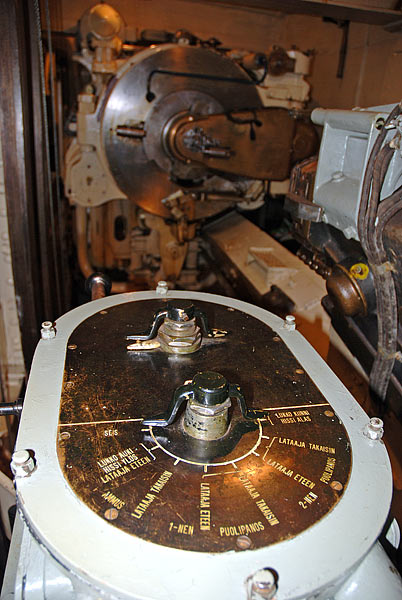
Control of the gun’s loading was executed from this desk. The breech end of the gun is seen in the background.
In 1935 test shooting of the battery was completed and training of gun crews begun. Photo courtesy of www.nortfort.ru
What is more difficult to understand is why the 305-mm artillery battery on Örö Island was not taken into Finnish military use at that time either. The fact remains that while the guns had been captured almost intact, as a whole the coastal artillery battery was still somewhat incomplete and the breech systems of these guns were missing some vitally important parts. The total number of 305/52 O coastal guns taken over by the Finnish military in 1918 was nine guns, of which five originated from Ino and four from Örö Island.
The Finnish military began to make use of the 305-mm coastal guns starting with the renovation of the existing artillery battery on Örö Island. The Russian World War 1 era 305/52 O coastal artillery battery on Örö Island had its four guns installed as two artillery sections of two guns each. In a sense one this artillery battery was at least partially dispersed, since its artillery sections (of two guns each) had some distance between them. Photographs taken in the early 1920’s show sheet metal shelters built around the breech systems of each gun to provide protection against the weather. Their guns had been installed on single gun mounts in barbette-type open artillery positions whose concrete massives had no rear wall. Finnish renovation work modified the gun pits into the circular type with q concrete roof that rotated with the gun. At the same time the renovation also installed electrical systems built for gun laying and loading of the guns.
The Örö 305-mm artillery battery became operational circa 1930. In the long run this renovation proved unsatisfactory and resulted in the building of modernized artillery positioning starting in the late 1930’s, at which time two of Örö’s 305-mm guns were transferred to the new Ristiniemi coastal artillery battery. The new modernized artillery positions for the Örö 305-mm artillery battery were built by using one gun pit from each artillery section (massive). Since there were only two guns, their gun positions were now de facto properly dispersed with modernized gun pits also providing better shelter than the old renovated positions. While they had no real steel turrets, the breech system area of each gun was covered by a steel structure, which provided protection against both the elements and shrapnel. Renovation of these improved artillery positions was not completed until just before the start of the Continuation War, with the two guns in them being test-fired in June of 1941.
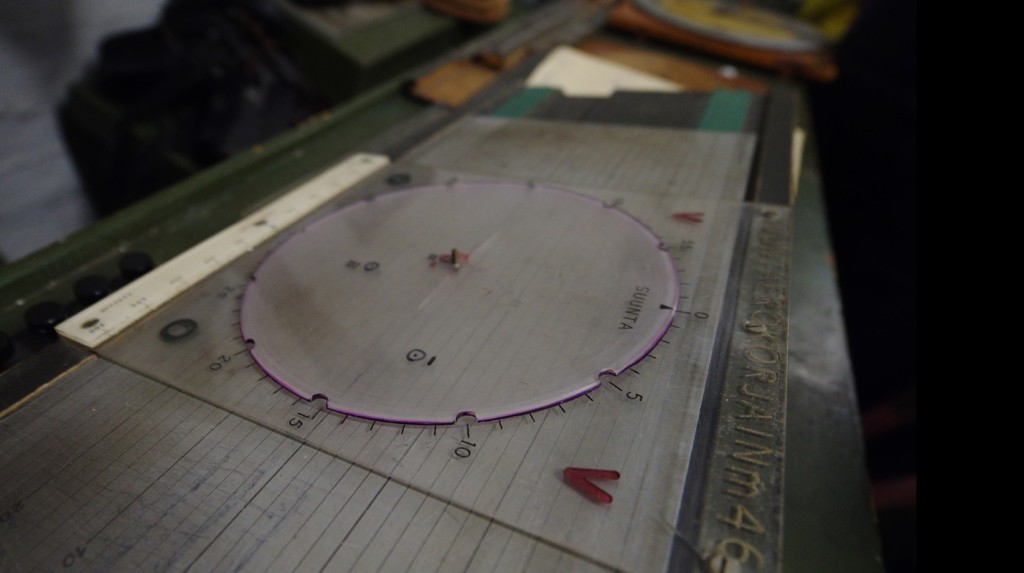
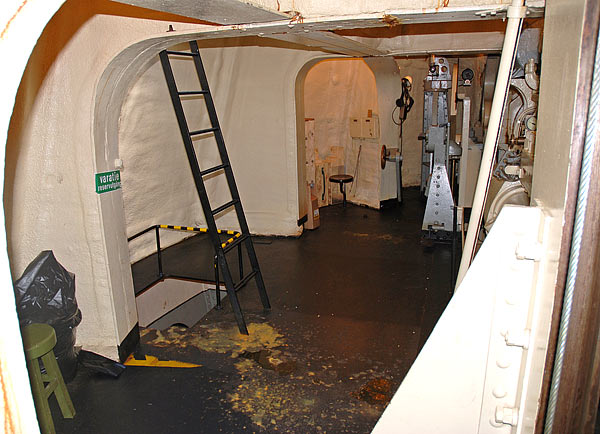
There are numerous compartments, passages, ladders etc. with a variety of equipment, cables, devices, indicators etc. The gun deck is in the picture. It’s walls and ceilings covered by polyurethane for soundproof and lagging.
The successful renovation of the 305/52 O artillery battery on Örö Island opened the door for building additional modern 305-mm coastal artillery batteries. The next ones in line were Mäkiluoto and Kuivasaari, whose 305-mm artillery batteries received funding in year 1931, as has previously been described. Following construction of the Mäkiluoto and Kuivasaari 305/52 O positions, the next in line (and last to be built prior to the Second World War) was Ristinemi. The Ristinemi battery was built in Ristiniemi Cape in Säkkijärvi municipality on the western side of Viipurinlahti Gulf. In 1931 the decision had been made to build a coastal artillery battery of three or four 305-mm guns on Ristiniemi to allow the closing of off Viipurinlahti Gulf and the coastal shipping routes leading to west from the Soviet Navy in a case where the coastal artillery batteries on Koivisto Island had been lost.
Funding for the Ristiniemi coastal artillery battery was made available in 1936 with construction work starting in that same year. Before the building of this artillery battery started the number of its 305/52 O guns was reduced to two, which were installed in new Finnish-built single gun steel turrets. As mentioned the guns used for building this battery were transferred from the Island of Örö, whose 305-mm artillery battery from that time on had only two guns. The guns installed into Ristiniemi were modernized and test-fired in Örö before their transfer in 1937. Most of the construction work on Ristiniemi was carried out over 1938 – 1939 with the artillery battery becoming operational in the autumn of 1939. This coastal artillery battery was officially named Artillery Battery 66 (Patteri 66) and had its gun turrets located in an extremely dispersed manner – there was almost kilometer in between them. Its 1st gun turret was referred to with the nickname “Kallio” (“Rock”) while the 2nd gun turret was known as “Kiviharju” (“Stone Ridge”).
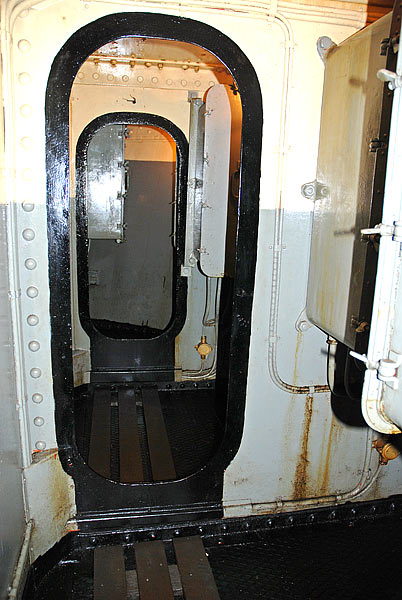
There is a 19 meter deep shaft under the turret with 5 decks. All metal surfaces are painted thoroughly and covered by oil for corrosion prevention. It is recommended that you wear older clothes for a visit to Kuivasaari.
Ristiniemi was the only coastal fort to use its 305-mm coastal guns in battle during the Winter War. When the war started on 30 November of 1939, this coastal fort initially did not see much action since the frontline had stalled on the Mannerheim-line, well outside range of its guns and Soviet warships were busy with the Saarenpää coastal fort until ice inhibited further naval operations. Only in February of 1940 did the frontline start to move closer, with the coastal fort taking part in desperate battles in an attempt to stop Soviet troops pouring across the ice-covered Viipurinlahti Gulf. By the end of the war the coastal fort was basically on the frontline. The Ristiniemi 305-mm artillery battery started shooting fire missions towards the land front on 20th of February 1940. But that same day it also lost half of its firepower, when. presumably due to failure to pre-heat the massive gun barrel in freezing weather with a smaller warming shot, the gun crew instead starting by firing a shell with a full power propellant charge. As a result of this failure the gun barrel of the 2nd gun (“Kiviharju”) cracked with a section about one meter long breaking off from the muzzle of the gun.
The Finnish military did not exactly have much of an inventory of spare gun barrels for 305/52 O guns – once Ristiniemi was built 8 out of 9 captured guns were in active use and replacing a gun barrel weighing about 50,000 kg was not exactly a quick and easy task either. Hence for the rest of the Winter War the Ristiniemi coastal fort had to make do with just one operational 305-mm coastal gun. In that situation the remaining 1st gun (“Kallio”) was put to hard use, which took its toll. When it came to the estimated average service life of 305/52 O gun barrel the Russian/Soviet estimate was 300 shots, while the Finnish estimate was just 150 – 200 shots. By the end of the Winter War on 13th of March 1940 the sole remaining 305-mm gun of Ristiniemi fort had fired a total of 298 shells. In the last days of the war the bore of this gun was so worn out that the shooting accuracy was gone.
During the battle for the nearby Tuppura Island (another coastal fort), this sole 305-mm coastal gun fired 58 high explosive (HE) shells in a single day against Soviet troops attacking over the ice towards the island. As a result the gun was in constant danger of overheating, which caused problems with its primer well and recoil behavior. The 305-mm high explosive shells broke massive holes in the ice, sending a large number of Soviet tanks and soldiers to a cold and watery grave. The Soviets responded by repeatedly bombarding Ristiniemi – on the worst days, Soviet aviation bombed at the rate of 600 – 700 bombs per day. Yet the Ristiniemi coastal fort remained in Finnish hands to the last day of the war and when Finnish troops evacuated the coastal fort, they destroyed its gun turrets before finally abandoning the fort.
Being the most powerful artillery weapons in the Russian inventory at that time, the Soviet Union also continued use and develop these guns and their ammunition. In the 1930’s the Soviets used triple gun turrets originating from the Gangut-class battleship Poltava to built a coastal artillery battery in Vladivostok and in the 1950’s turrets were used to built another coastal artillery battery in Sevastopol. These two particular coastal artillery batteries remained operational until the 1990’s. Three remaining Gangut class battleships saw use in World War 2 along with Soviet coastal artillery batteries, some of which such as Coastal Artillery Battery 30 in Sevastopol (Maxim Gorky I) and Krasnaja Gorka coastal fort gained a considerable reputation.
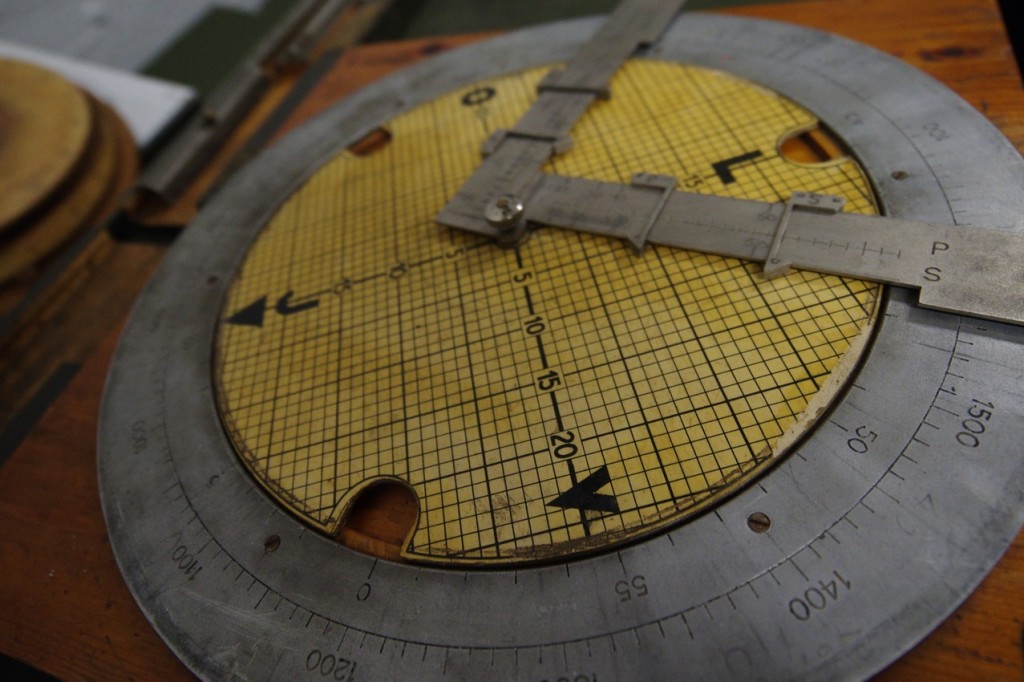
The 12″ Guns of the Imperator Aleksander III and the Kuivasaari Coastal Artillery Fortress
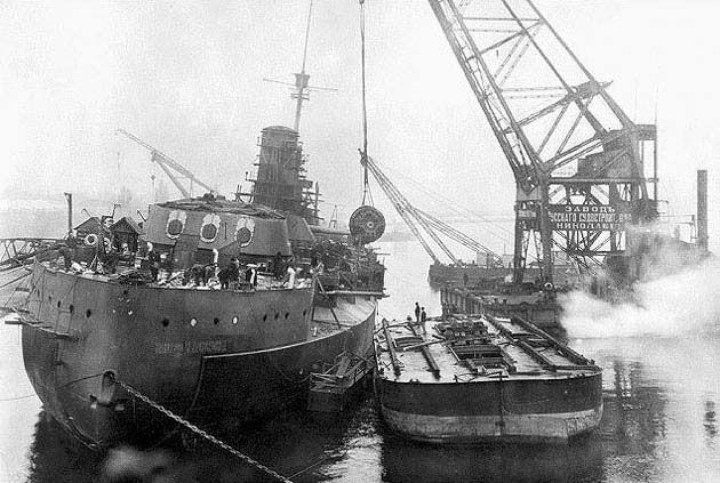
The Imperator Aleksander III was the most modern of ships when she was laid down at the Russud Yard at Nikolayev on the Black Sea in 1911.
In January 1940 France gave twelve Obukhovskii 12-inch (305 mm) Pattern 1907 52-calibre guns from the ex-Imperial Russian Navy Imperatritsa Mariya-class dreadnought Imperator Aleksandr III to Finland, after refusing to sell seven to the Finns in the summer of 1939. The origins and story of these guns is interesting in and of itself and so I shall include this interesting tale within this article on Kuivasaari as some of these gun barrels are still existent on Kuivasaari today.
The Imperator Aleksander III was the most modern of ships when she was laid down at the Russud Yard at Nikolayev on the Black Sea in 1911. (Although the laying down on 30 October 1911 was ceremonial only as the design had not been finalized nor the contract signed). She was a 24,000 ton ship of the Imperatritsa Mariya class of battleships and as such carried a 1,386 man crew (other sources say 1,154 men) and was armed with a dozen impressive 12 inch (305mm) naval guns. She and her sisterships were designed to ensure naval superiority in the Black Sea over the Ottoman Turkish navy who were acquiring a pair of modern battleships from Great Britain at the same time.
Imperator Aleksandr III was 168 meters (551 ft) long at the waterline. She had abeam of 27.43 meters (90.0 ft) and a draft of 8.36 meters (27.4 ft). Her displacement was 23,600 tonnes (23,200 long tons; 26,000 short tons) at load, 1,000 t (980 long tons; 1,100 short tons) more than her designed displacement of 22,600 t (22,200 long tons; 24,900 short tons). Imperatritsa Mariya proved to be very bow heavy in service and tended to ship large amounts of water through her forward casemates. Imperator Aleksandr III ’s forward pair of 130 mm guns were removed before she was completed in an attempt to compensate for her trim.
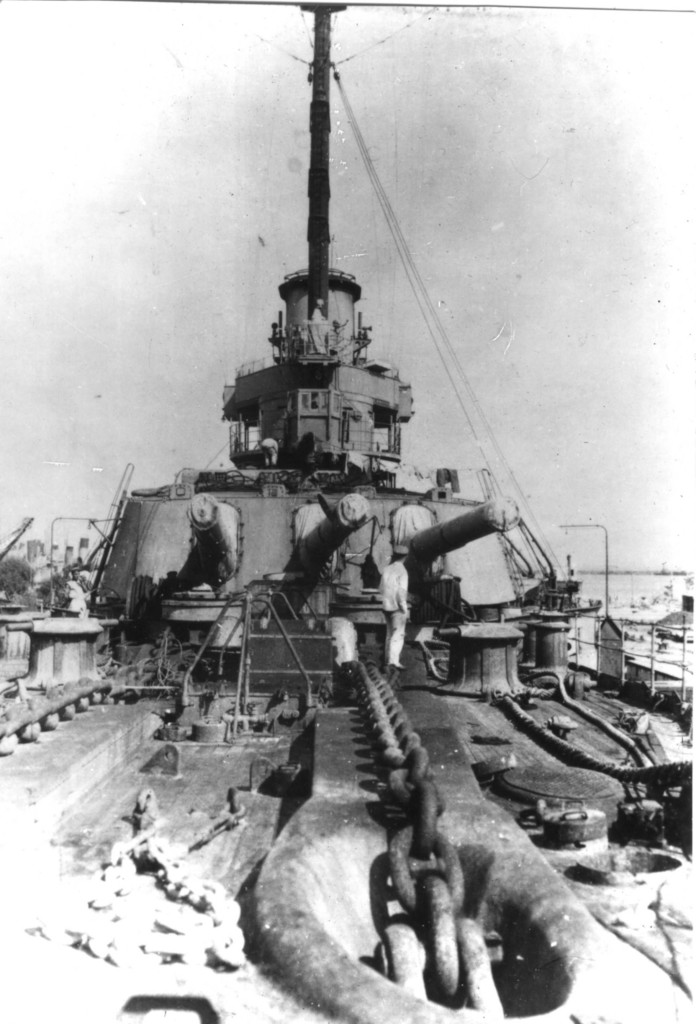
Imperator Aleksander III
Imperator Aleksandr III was fitted with four Parsons-type steam turbines imported from John Brown & Company of the United Kingdom. They were designed for a total of 26,000 shaft horsepower (19,000 kW), but produced 27,270 shp (20,340 kW) on trials. 20 mixed-firing triangular Yarrow water-tube boilers powered the turbines with a working pressure of 17.5 atm (257 psi). Her designed speed was 21 knots (39 km/h; 24 mph). Her maximum fuel capacity was 1,700 long tons (1,727 t) plus 500 t (490 long tons; 550 short tons) of fuel oil which gave her a range of 1,640 nautical miles (3,040 km; 1,890 mi) at 21 knots (39 km/h; 24 mph). All of her electrical power was generated by three Curtis 360-kilowatt main turbo generators and two 200-kilowatt auxiliary units.
The ship’s main armament consisted of a dozen Obukhovskii 12-inch (305 mm) Pattern 1907 52-calibre guns mounted in four triple turrets distributed the length of the ship. Her secondary armament consisted of eighteen 130-millimeter (5.1 in) B7 Pattern 1913 55-caliber guns mounted in casemates. They were arranged in two groups, five guns per side from the forward turret to the rear funnel and the remaining four clustered around the rear turret. She was fitted with four 38-caliber 76.2-millimeter (3.00 in) ‘Lender’ anti-aircraft guns, two each mounted on the roof of the fore and aft turrets. Four 17.7-inch (450 mm) submerged torpedo tubes were mounted, two tubes on each broadside abaft the forward magazine.
She suffered from a number of delays during construction. First the method of fastening the armor to its supports was changed and the armor plates were locked together by a type of mortise and tenon joint to better distribute the shock of an impact based on the full-scale armor trials conducted using the hulk of the old pre-dreadnought battleship Chesma in 1913. This added almost 500 long tons (508 t) of weight to the ship and raised her cost by 220,000 rubles. With the onset of World War One, work on the ship slowed further due to efforts to complete her sister ships rather more quickly. She was not expected to be finished before 1916, but her British-built turbines were also delayed.
Although she was launched on 15 April 1914, she was still in the builders dock when the Tsar Nicholas II abdicated in 1917 and did not arrive at Sevastopol for fitting out until 17 July 1917,. The crew took the ship over and formed a Soviet-style committee, renaming the ship the Volia or Volya (Freedom). She was finally commissioned into the fleet (even though not fully completed) in June 1917 and made a few short sorties into the Black Sea on the hunt for Turkish warships. However, the disruptions imposed by the February 1917 revolution had already rendered the Black Sea Fleet more or less ineffective and during the last of these sorties the crew of the flagship mutinied and demanded a return to Sevastopol, saying that for them, the war was over.
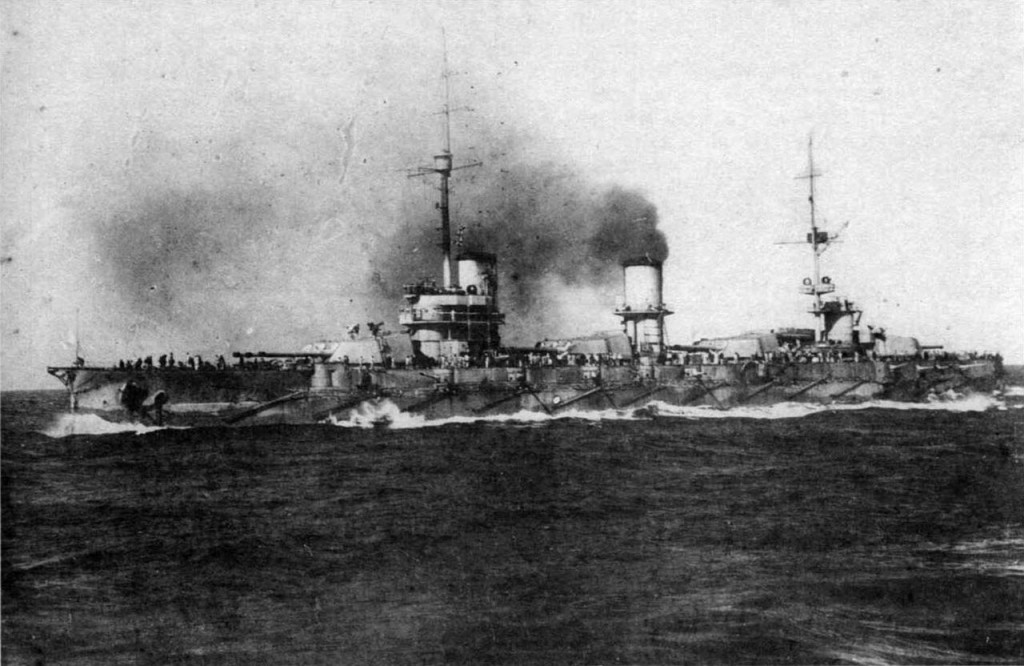
The Russian battleship Volya at sea, 1917
November 1917 brought the Bolshevik Revolution and subsequent peace negotiations with the German and Turkish governments which resulted in the Treaty of Brest-Litovsk. The Treaty called for the Ukraine to come under German occupation and forced Russia from the war. The Treaty of Brest ceded control of Volya and her remaining sister to the Germans. The revolutionary crew of Volya’s sister ship Svobodnaja Rossija (as Imperatritsa Ekaterina had been renamed) arranged the scuttling of their ship. Before German troops could make it to the Black Sea the Volya was seized by Ukrainian revolutionaries (who promptly renamed it the Ukraine) in April 1918. Volia sailed from Sevastopol to Novorossiysk on 1 May 1918 to avoid capture by advancing German troops. While at Novorossiysk she received an order to scuttle on 19 June 1918, but the majority of the crew (933 versus 640) refused to do so and decided to return to Sevastopol. Upon arrival she was disarmed and only guards were left on board when the Germans took control on 1 October 1918.
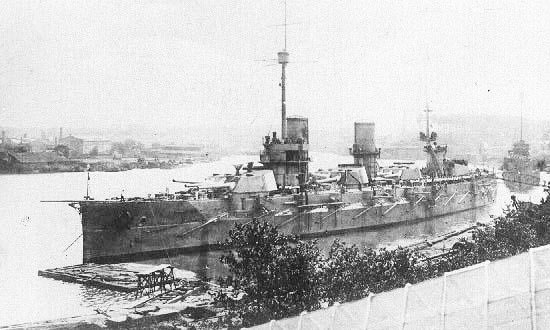
The Imperator Aleksandr III
When the Germans arrived in the region they took the gently used battleship for themselves and she joined the navy of the Kaiser, being commissioned into the German Navy on 15 October 1918. She was renamed the Volga and a German crew under Konteradmiral Walter Isendahl (1872-1945) took over the ship in September 1918 without any official commissioning into service. The ship made a brief cruise with a German crew on 15 October, but her guns were still inoperable as the guns were an ship’s operations.unknown type for the Germans and they lacked the necessary skilled personnel to understand the operations of the ship.
The end of World War One brought an Allied occupation force into the Black sea through the Dardanelles. Under the terms of the Armistice, the Germans were to turn the ship over to the British and the ship along with its German crew surrendered to the British navy three months later (on 24 November 1918). By 11 November 1918, 500 of the German crew had already left for Germany and the rest followed on 14 November. A party from the light cruiser HMS Canterbury under Captain Percy Royds took charge of her. A month later she was sailed for the port of İzmit, on the Sea of Marmara, by a crew from the pre-dreadnought HMS Agamemnon, which also escorted her. The ship briefly flew a Royal Navy ensign but it was decided to turn the vessel over to the White Russian government, whom the Allies were backing in the Russian Civil War. On 29 October 1919 she was sailed back to Sevastopol by a crew from HMS Iron Duke.
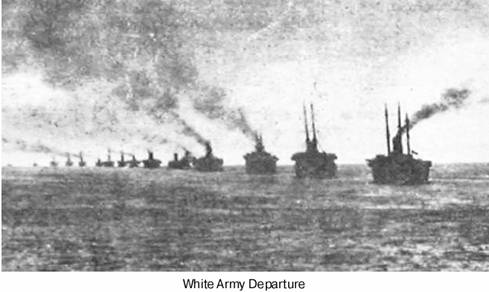
Wrangel’s Fleet, the last remnant of the Black Sea Fleet of the Imperial Russian Navy, departs the Crimea
The British turned her over to the White Russians, whom they were backing in the Russian Civil War, in 1919. The White Russians raised their flags over the ship by years end and named her after General MK Alekseev, one of their early leaders who had died during the conflict. The General Alekseev was handicapped by a shortage of trained crew, spare parts, and a lack of mission during her use by the Whites. She did however conduct a number of naval gunfire support missions for the White Army in its fight whenever the Bolshevik Red Armies came close enough to the coast for its huge 12 inch guns to be effective. At this point apparently only one front turret was capable of firing so even with this, fire support was limited.
In November 1920 the General Alekseev led the largest naval evacuation until Dunkirk from the Crimea to Turkey when Gen. Baron Piotr Wrangel, the last White army commander in Europe, evacuated his forces to Constantinople. This huge fleet was made up of 126 ships and carried 145,693 Russians into exile. Thousands of Whites who could not be carried on the Russian or accompanying British ships were massacred by the Red Army. The General Alekseev remained in Constantinople harbor armed and with its flags flying until being escorted to Bizerta in French Tunisia where she was interned under the command of Rear Admiral Mikhail Berens. With the exception of Admiral Stark’s Siberian forces this was the last White Russian Fleet.
She was interned in Bizerte (Tunisia) with the rest of Wrangel’s fleet with a White Russian skeleton crew who remained in residence for years until the French authorities demanded that they hand the vessel over in partial payment for assistance rendered to the exiles (other sources say for docking fees). The tattered Tsarist Russian Naval ensign was lowered for the last time on October, 29, 1924 and the exiles left the ship in French hands. By this time the battleship was in largely unusable condition and after inspection it was recommended to turn the vessel over to the Soviet government as a good will gesture. A Soviet Naval party directed by Alexi Krylov inspected the ship in December 1926 but found it in such poor condition that they declined to take it back.
In somewhat of a little aside here, the exodus of the Russian Black Sea Fleet to Bizerte was somewhat of a tragedy for the many thousands of Russians who ended up there, albeit less so than for those that remained behind to be slaughtered by the Bolsheviks. Bizerte is a quiet picturesque town on the Mediterranean coast of Tunisia. It was the final destination of the Russian fleet, departed from Sevastopol, Feodosia and Kerch in autumn of 1920. For the sailors and their families Bizerte became the second home. This Russian colony in Tunisia housed thousands of people who had lost contact with their relatives and couldn’t even hope to see their homeland again. Each of them faced a difficult adaptation to another world, climate, and social status, but even in such conditions, people were able to preserve their cultural values and traditions. They lived, worked, brought up children, wrote poetry, died and left…
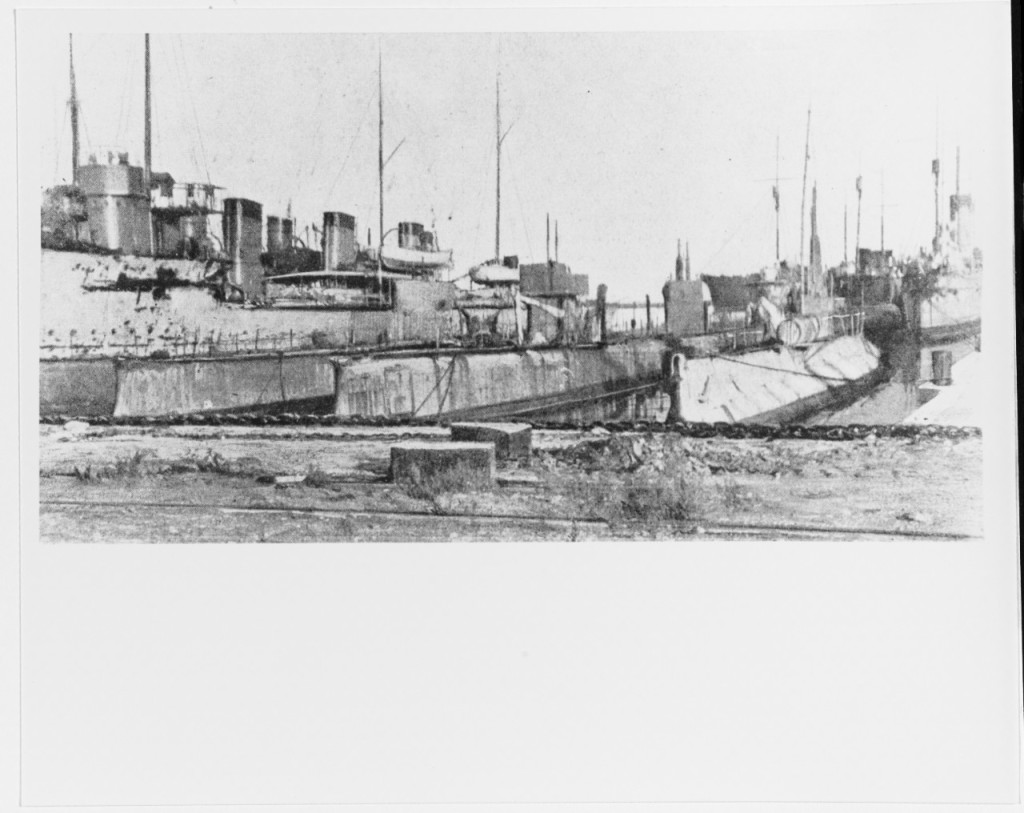
Russian Warships at Bizerte, North Africa, circa 1921. Several Russian ships laid up at Bizerte, French North Africa, circa 1921. L-R: destroyer BEZPOKOINI 1913-33, submarine UTKA 1916-circa 1930, submarine BUREVIESTNIK 1916-circa 1930, and submarine AG-22 1917-circa 1930.
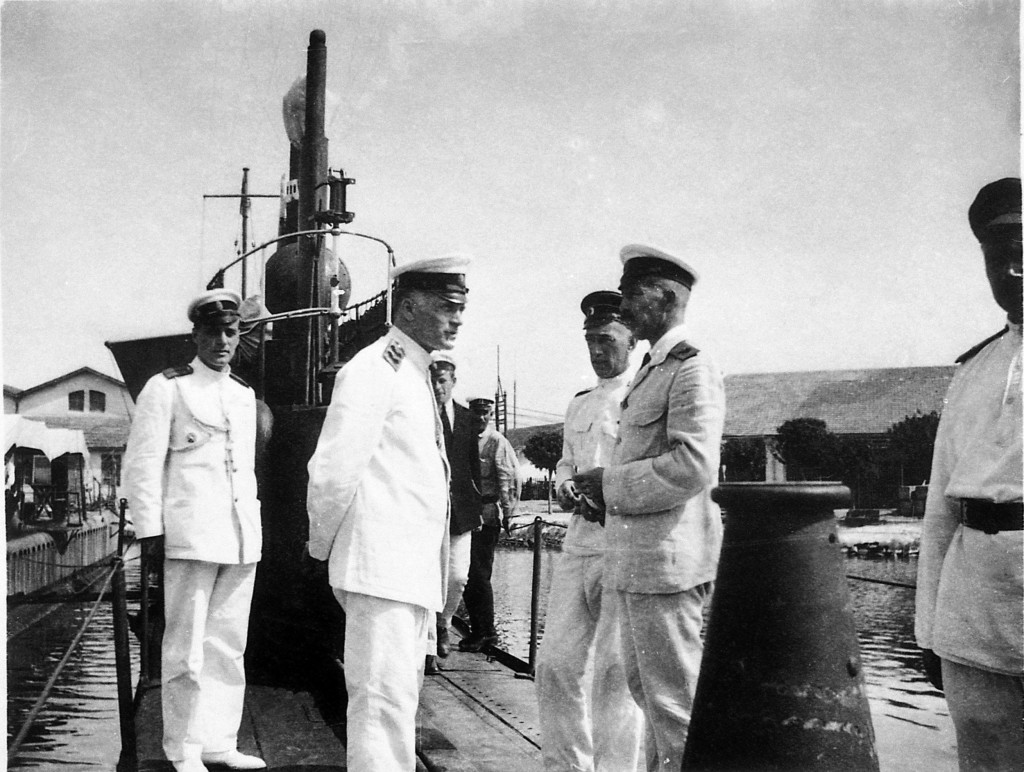
Admiral Berens (third from left) at Bizerte, 1921. He commanded the Russian fleet in exile from January 1921 until its disarmament after the recognition by France of the Soviet Union on October 29, 1924
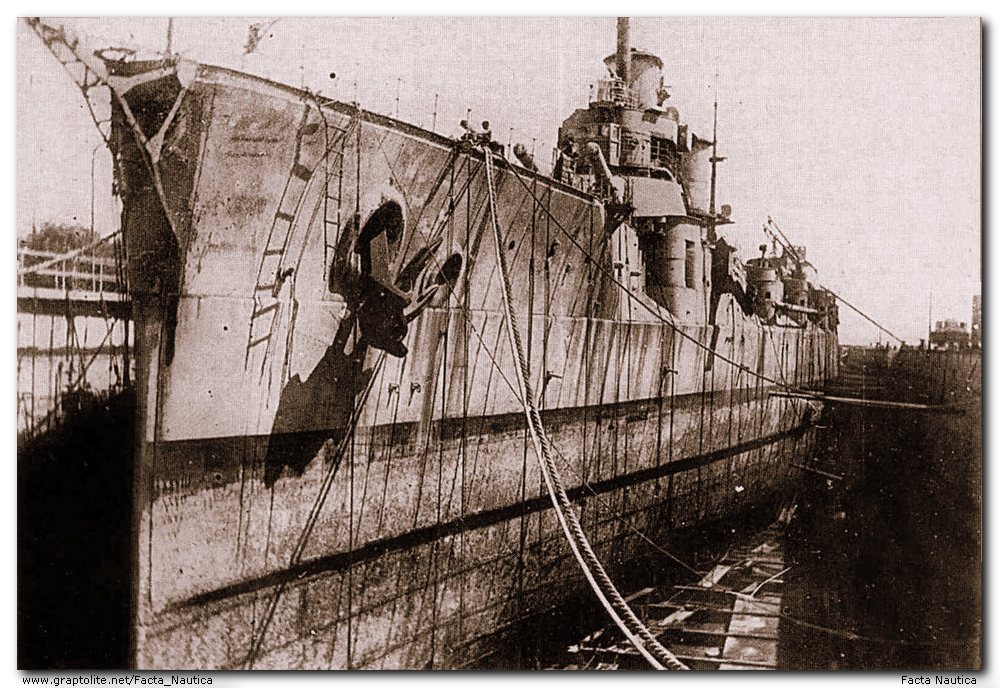
The Russian battleship GENERAL Alexeyeva, standing in dry dock Bizerta (Tunisia). Photo from 1922.
The General Alekseev was sold for scrap to the Kliaguine Company in 1928 (Alexander Pavlovich Kliaguine was a wealthy Russian businessman whose family still owns the 5 star Hotel Napoleon in Paris – the Russian emigre Prince Yussupov gave the hotel to the wife of his best friend Alexander Pavlovich Kliaguine as a wedding gift). The ship was then slowly dismantled over the course of the next decade. Its usable naval equipment was sold abroad or taken by the French navy, its main guns were removed for further use and the ship itself was broken up and sold for its scrap value in 1936. By 1937 nothing remained of the old battlewagon but her 30 assorted 12inch and 130mm guns which were to have a fascinating life of their own. Her 12″ guns were put into storage at the arsenal at Sidi Abdallah near Bizerte while her smaller guns were used by the French in coastal batteries to defend the port of Bizerte. In January 1940, after lengthy negotiations, France gave them to Finland, after refusing to sell seven to the Finns in the summer of 1939.
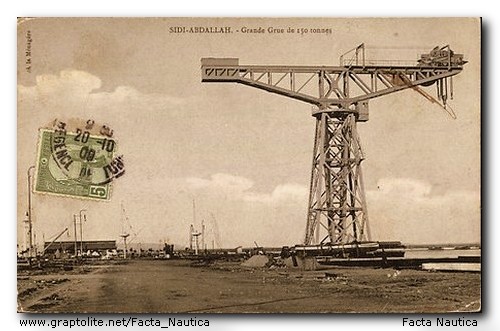
Port crane in Sidi Abdallah with a capacity of 150 t.
The mass of a single working cal. 305 mm Russian battleship
GENERAL Alexeyev was “only” 84.2 t.
Once the interest of the Finnish military concerning 305-mm coastal guns was sparked in the early 1930’s, the limited number of modern super-heavy coastal guns in use became apparent. Hence in the 1930’s Finland intended to acquire more super-heavy coastal guns, but the delivery times from Krupp and Bofors proved to be much too long. France had a dozen 305/52 O guns that had been stripped from the battleship Imperator Aleksander III, which would have suited well to Finnish needs, but a pre-World War 2 attempt to buy them failed to reach a deal.
The French businessman A. Kliaguine (actually a Russian emigre himself who had married a beautiful young French student in 1928) had offered the 305-mm and 130-mm guns from Imperator Aleksander III to Finland just before the Winter War, but the French government had interfered and stopped the deal. Somewhat incidentally, it also appears that in 1938, the Polish government had raised with France the question of buying four of these guns (http://www.graptolite.net/suomi/Nina.html). The Finnish – Soviet Winter War that brought public opinion world-wide for supporting Finland changed things and ultimately on 12th of January 1940 France decided to donate to Finland all the 305-mm and 130-mm guns originating from the Imperator Aleksander III.
In February of 1940 these guns, often referred to in Finland as the “Bizerte guns”, were loaded at Tunis into three Finnish ships for transport to Finland: the Juliette carried 4 305/52 O guns. The Karl Erik carried a further 4 and the Nina the remaining 4. The Juliette and Karl Erik reached Finland safely but the Norwegian steamship Nina owned by Lovis Angfartygs with her cargo of four guns was captured by the Germans in Bergen harbor in 1940 during the fighting in Norway. The Germans emplaced all four seized guns, after rebuilding them to accept German ammunition, in armored turrets in ‘Batterie Mirus’ on Guernsey. The eight 12″ guns that the Finns eventually got from Bizerte were barrel numbers 86, 127, 113, 121, 119, 91, 96 and 129.
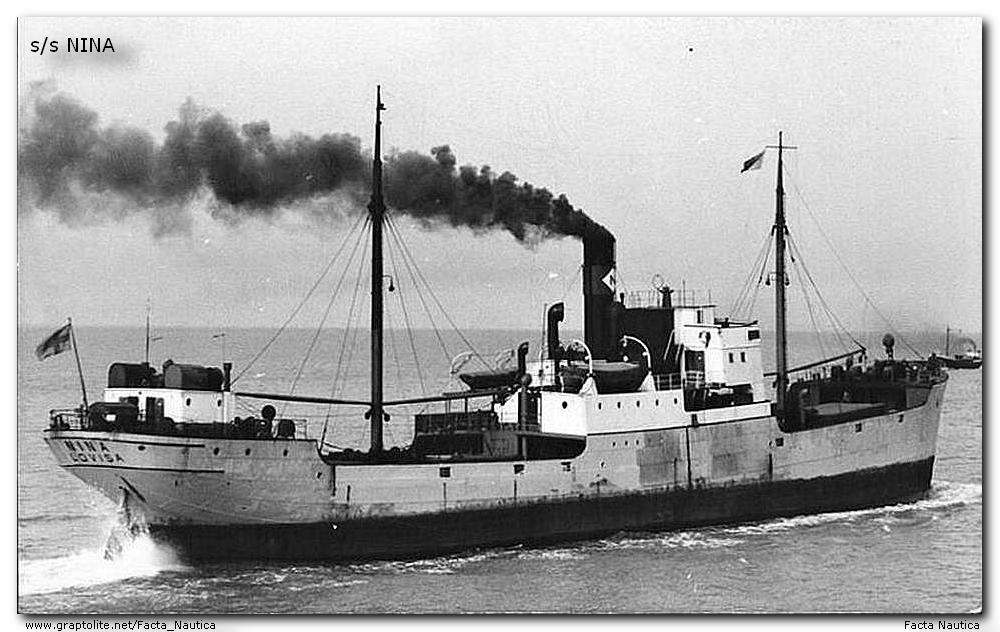
Finnish freighter Nina (Lovisa), built in 1899. Nina carried 4 of the 12 inch guns together with all the 130mm guns sailing from Tunis to Bergen, where she arrived in April.
The eight 305/52 O guns that successfully reached Finland were soon put to use, with plans to strengthen the coastal artillery in important areas put underway. Two of the barrels (113 and 121) were used to build two single gun turrets on Isosaari Island, part of the plans to improve the defences of Helsinki. The artillery battery built on Isosaari had two single steel turrets designed by Engineer-Captain Salonius with the other structures being designed by Engineer-Lieutenant Gummerus. Finnish company Oy Karhula built the actual steel turrets, which were simply referred as länsitorni(west-turret) and itätorni (east-turret). The artillery battery was a well-dispersed one, with turrets being located almost on opposite ends of the island.
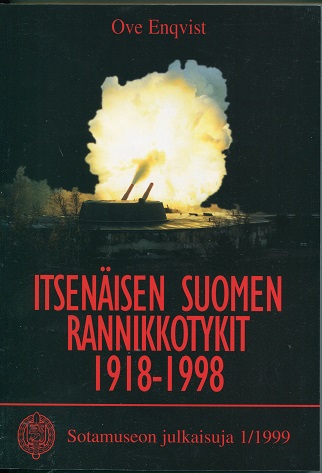
For Finnish readers, Ove Enqvist’s book is a good source of information
The Isosaari gun turrets were the last evolutionary step in Finnish development gun turrets for 305/52 O coastal guns. They were much more lightly armoured than earlier Mäkiluoto & Kuivasaari Coastal Artillery Fortress turrets, but at the same time made possible higher maximum elevation of about 52 degrees, allowing guns to achieve maximum range of over 50 kilometers. The whole construction plan for these turrets relied more on solid granite (rock) as protection of the underground parts instead of ferroconcrete and due to improved design each turret needed two less underground floors than previous gun turrets. Construction work for the artillery battery started with rock mining in autumn of 1941. Work progressed slowly especially early on due to shortage of skilled manpower and installation of the actual gun turret for the east-turret did not start until January of 1944. The work with the west-turret was running even slower.
When construction work had to stop in January of 1945 due to orders from the Allied Control Commission, the east-turret was apparently almost complete, while the west-turret was far from complete with only the parts on top of actual turret rotator having been installed by that time. The barrels were transferred to depot in 1945 and returned to Isosaari in the 1960’s. The Eastern turret is still preserved as a museum piece with barrel # 113 in place. The Western turret with barrel # 121 suffered a barrel explosion in the 1970’s during tests with “super charges”and the barrel was replaced with another, the number of which is unknown to me. Some time in the 1960’s there were two 12″ spare barrels in Isosaari.
Two further Bizerte barrels were used for a new coastal artillery position on Mäkiluoto, where a dual gun turret was planned using barrels 119 and 91. The construction work for the second dual gun turret on Mäkiluoto Island (one already existed) was even slower than on Isosaari and by the end of Continuation War had barely started before being cancelled in September of 1944. The barrels were evacuated in 1944 before Porkkala was rented to the Soviets with the existing 12” twin turret included. Barrel # 91 is now the spare barrel on Örö.
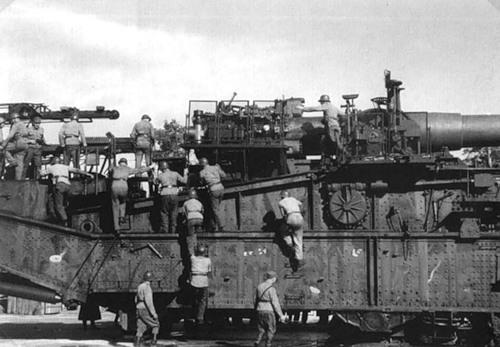
Finnish 305mm Railway Gun
Three other guns (barrels 86, 127 and probably 129) were used to repair Soviet TM-3-12 railway guns abandoned at Hanko when the Soviets evacuated in 1941. The Russians had built three railway guns , using guns from the sunken battleship Imperatritsa Mariya, which had been lost to a magazine explosion in Sevastopol harbor in October 1916. They were used in the Soviet-Finnish war in 1939-1940. In June–December 1941 they took part in the defense of the Soviet naval base on Finland’s Hanko peninsula (Rus. Gangut/ Гангут). They were disabled by Soviet seamen when the base was evacuated.
These were found underwater in the Hanko harbour and salvaged – they needed major repairs, the barrels needed replacement and they entered service one by one between 1942 and 1944. Not just guns were repaired by the Finnish specialists but also the whole gun trains that went with each gun, including signals and fire control systems. After the war these were handed over to the Soviet Union in 1945, where they were kept operational until 1991, being finally withdrawn from service in 1999. When withdrawn from service, they were the last battleship-caliber Obukhov pieces still operational in the world. One is on display at the Krasnaya Gorkan fortress near Saint-Petersburg and the other two guns are in museums in Moscow and St. Petersburg
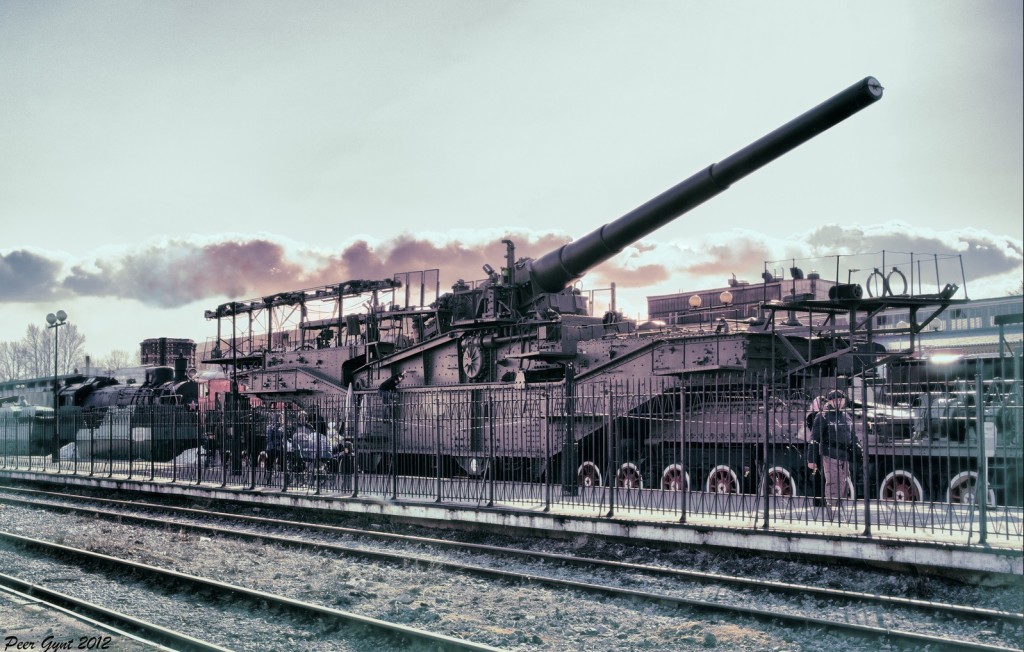
Railway Artillery Gun TM-3-12. 1938. Three of these guns were built and were captured by Finnish forces when the Soviets evacuated Hanko. They were restored by the Finns, then repatriated to the Soviet Union post-WW2 where they were maintained in operational condition until 1991, and finally withdrawn from service in 1999.
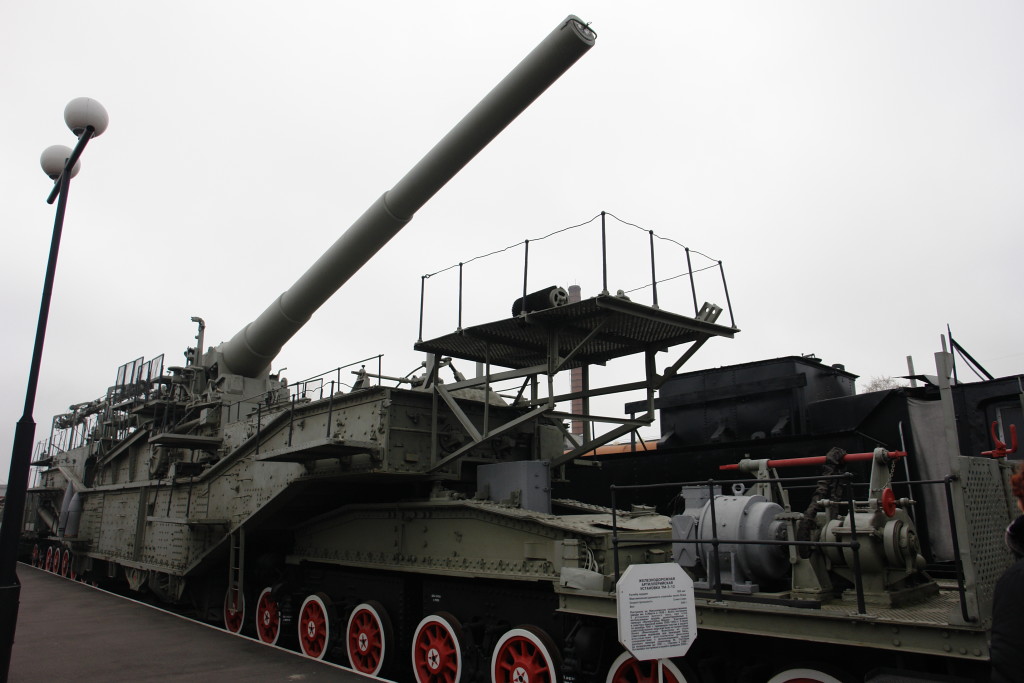
A TM-3-12 at the Central Museum of Railway Transport, Russian Federation, at Varshavsky Rail Terminal, St.Petersburg
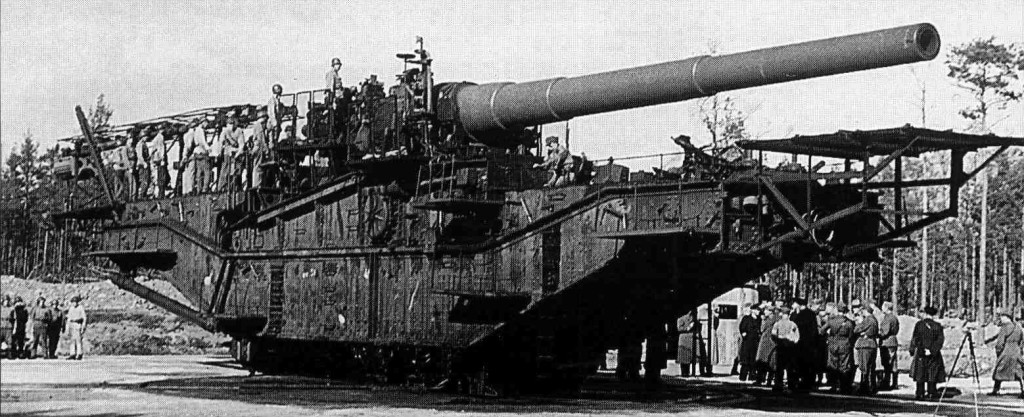
Finnish Army 305mm Railway Gun, one of three captured from the Soviets at Hanko and repaired
Barrel #96 was kept as a spare and is now one of the two spare barrels preserved at the Finnish Coast Artillery Museum at Kuivasaari. The two barrels fitted in the gun turret at the Kuivasaari Coastal Artillery Fortress are, incidentally, barrels #15 (right) and #111 (left). The barrels were evacuated in 1945 and the same barrels returned in the 1960’s. These barrels originate probably from the fortress of Ino. One of the two spare barrels in Kuivasaari is # 18, which is not from Bizerte (it’s probably from Ino).
The four 305mm guns seized by the Germans were sent to Guernsey, one of the British Channel Islands, where they formed a four gun battery. After the war, these guns were scrapped. The eighteen 130mm guns seized by the Germans were used for coastal artillery batteries guarding the entrance to the Altafjord, which was where the Tirpitz was based. Informally, these guns were called the Nina Geschutz. They engaged the British light cruiser HMS Kenya, reportedly scoring one hit on the cruiser, during Operation Archery in 1941, but saw no other combat during the war.
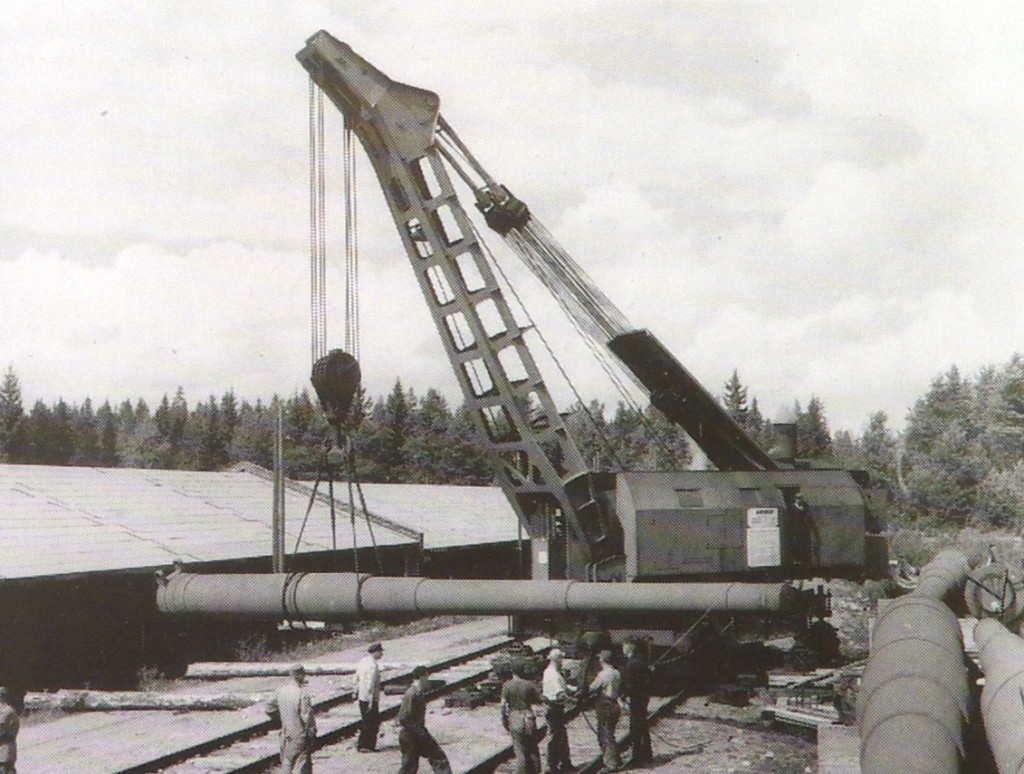
Storing the 12″ gun barrels at Parola Armour Depot
The reader may be wondering why the Finnish coastal artillery retained super-heavy coastal guns in service for so long, where most other countries had long ago either disbanded their coastal artillery or replaced its guns with missiles. One of the reasons for this was the Paris Peace Treaty of year 1947, which among other things limited the peace-time manpower of the Finnish military, the tonnage of the Finnish Navy, the number of combat aircraft allowed the Finnish Air Force – and which also banned the Finnish military from having missiles, torpedo boats or submarines. The first anti-ship missile systems acquired by Finnish Navy were the Tuima-class (OSA-II class) missile boats equipped with MtO 66 (P-15 Termit / SS-2-N Styx) anti-ship missiles acquired from the Soviet Union in mid 1970’s. The first anti-ship missile system acquired for the Finnish coastal artillery was the MtO 85 (RBS-15SF) acquired from Sweden in the mid 1980’s. In 1990 Finland officially declared the particular limitations of the Paris Peace Treaty to be obsolete and void, thus finally bringing about the retirement of many of these old large bore coastal artillery guns.
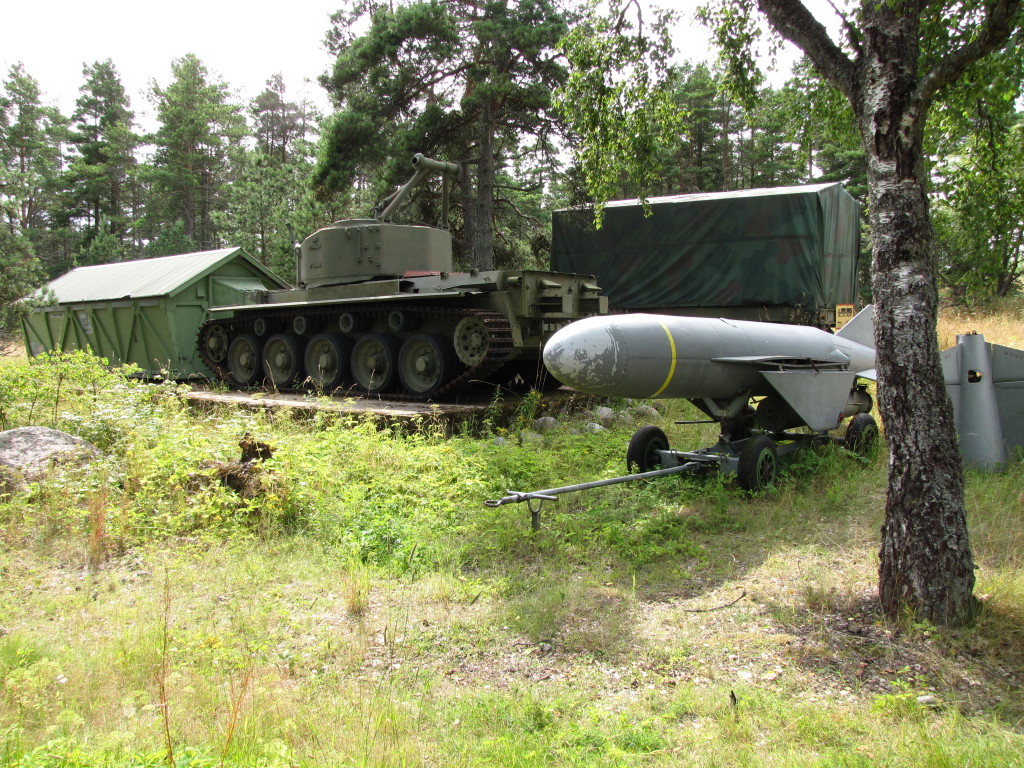
P-15U anti-ship missile at Kuivasaari. An old Comet tank converted into a missile launch vehicle is in the background. The wooden “shed” in front of the tank is a transport case for the missile. Ohjus, laukaisupanssarivaunu ja ohjuksen puinen kuljetuslaatikko. Huomaa ulkonema kuljetuslaatikon päädyssä – ohjus ei muuten mahdu sille suunniteltuun kuljetuslaatikkoon.
The Kuivasaari Coastal Artillery Fortress 305/52 O Guns – Refurbishment for Museum Purposes
By the time they were withdrawn from active service, the 305/52 O 12″ guns were a military anachronism. At the time, the military intended to dispose of the the guns and the turret for scrap, but this caused an outcry from the public, and the turret was preserved until the early 1990’s. In 1992 refurbishment began and on the 75th anniversary of Finland’s independence the turret fired the first “water salute” – instead of a projectile in the barrel, an equal amount by weight of water was used. Since then, firing a salute on Finland’s Independence Day has become a tradition. Over the years since 1992, the museum has expanded and now visitors can see a unique collection of coastal artillery guns and equipment.
The idea of refurbishing the 305/52 O Obhukhov guns started after the guns were no longer needed as backup for missiles. The end of 1989 saw the Suomenlinna Coastal Artillery Regiment’s (since 1990 Finland Savonlinna Coastal Regiment) then commander Colonel Asko Kilpinen proposing an initiative to restore the heavy-duty Kuivasaari gun turret. In the spring of 1990 a meeting was held to discuss renovation and plans were put together. Over Summer 1990 – Spring 1991 the project was publicised and funds collected. Fuji Finland contributed, the Ministry of Defence issued a FIM 10,000 grant and the City of Helsinki FIM 25,000 for the project. Actual repair work was not started but funds were accumulating relatively well.
Funds of about FIM 100 000 were collected, with a rough estimate of the budget being around 250 000 – 300 000 FIM. The most expensive work was assessed as the turret inner surface sand blasting as well as electrical work. Work on Kuivasaari began in the spring of 1991. During the summer, the upper part of the turret was sandblasted and painted. The top of the ceiling and wall surfaces were cleaned from the inside, the upper part was painted and sprayed with urethane foam. Air-conditioning was installed, casemates on the roof isolated and interior cleaning operations were launched in the Autumn of 1991. Work was hampered to some extent by a lack of workers but the restoration of the guns was completed by the end of 1991.
Arriving on the island, tourists often ask: how many times is the gun fired? It should be kept in mind that the ammunition for such weapons is limited, and at this time in the gun barrels lives they have already fired 100 shots and 67 (right and left barrels respectively, not counting the “water salute”). With a life of only 400 shots, they must be carefully conserved – as getting a replacement 12″ gun barrel in our time is now even more difficult than it was for a newly independent Finland, so every shot fired is priceless. In addition to the Obhukhov 305/52 O guns, Kuivasaari has examples of almost all the guns used over the years by the Finnish Coastal Artillery as well as some of the first anti-ship missiles from the 1960’s.
When you visit the island, the guides can explain the war years as well as the Cold War period. Kuivasaari itself is still a military area, you will not be allowed to enter without proper authorization (non-Finns will require a Passport) and with access restricted the vegetation is in a natural state. The Finnish Defence Forces use the area from time to time exercises but the island’s coastal artillery equipment has been removed from operational use (some of it is still usable however). Guided tours of the island and the maintenance of the island’s museum weapons is currently the responsibility of the Finnish Association of the Castle Coastal Artillery Guild (Suomenlinnan Rannikkotykistökilta), which collects funds for maintenance from guided tours and admission fees. These funds are used for maintenance of historic sites on the island. Even the guides are volunteers and are not paid. With the help of voluntary work this former Coastal Artillery Fortress has changed into a coastal defense historical museum and a nature preservation area.
In 2015 Kuivasaari was open for public tours for three weekends over the simmer. Foreign citizens have the opportunity to visit Kuivasaari on these weekends. Access to the island is also available to groups. All of the Helsinki archipelago cruise companies know how to organize the cruise, which allows you to explore Kuivasaari. Guided tour length will vary according to customer needs, but it is advisable to book at least one and a half hours. Kuivasaari itself is now very much more like a museum or a nature site.
While it is still a strategically important national defense area for the protection of the capital of Finland, it also represents a huge voluntary effort by members of the Coastal Artillery Guild, whose members did not want to give up when State War Museum funds were not sufficient for the preservation of Kuivasaari as a national treasure. After visiting the island, you will see that it is customary in Finland to spend voluntary time on such extraordinary things.
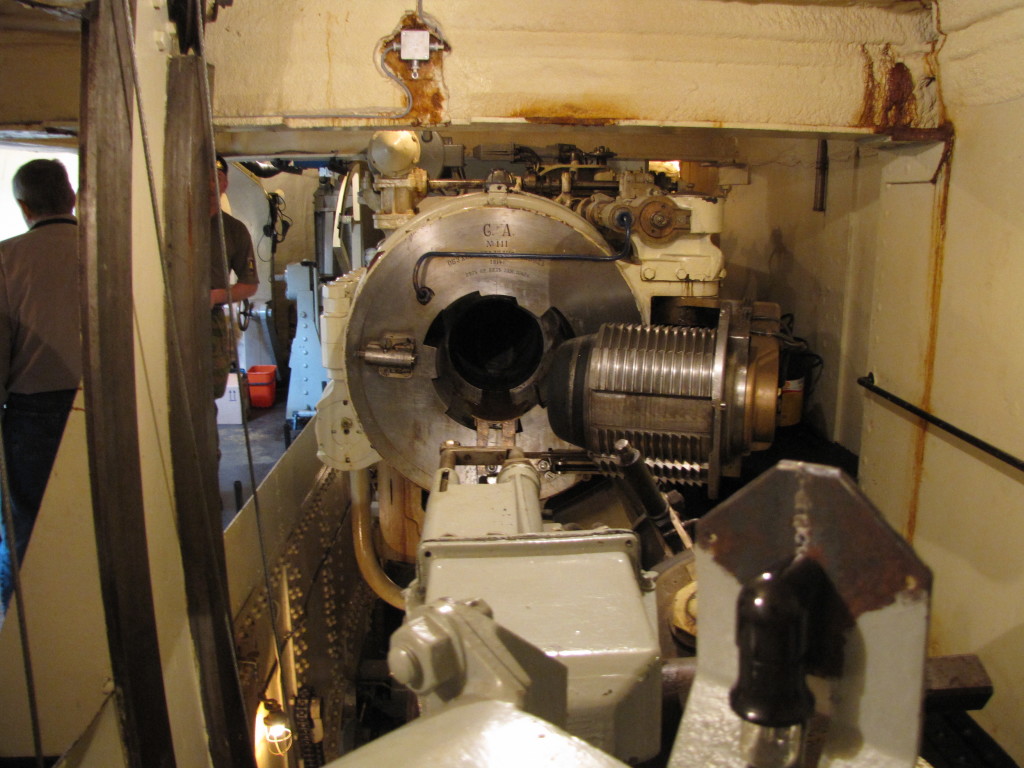
Breech of Kuivasaari 305 mm gun. This is the left gun in the twin turret. Oikean tykin lukko.
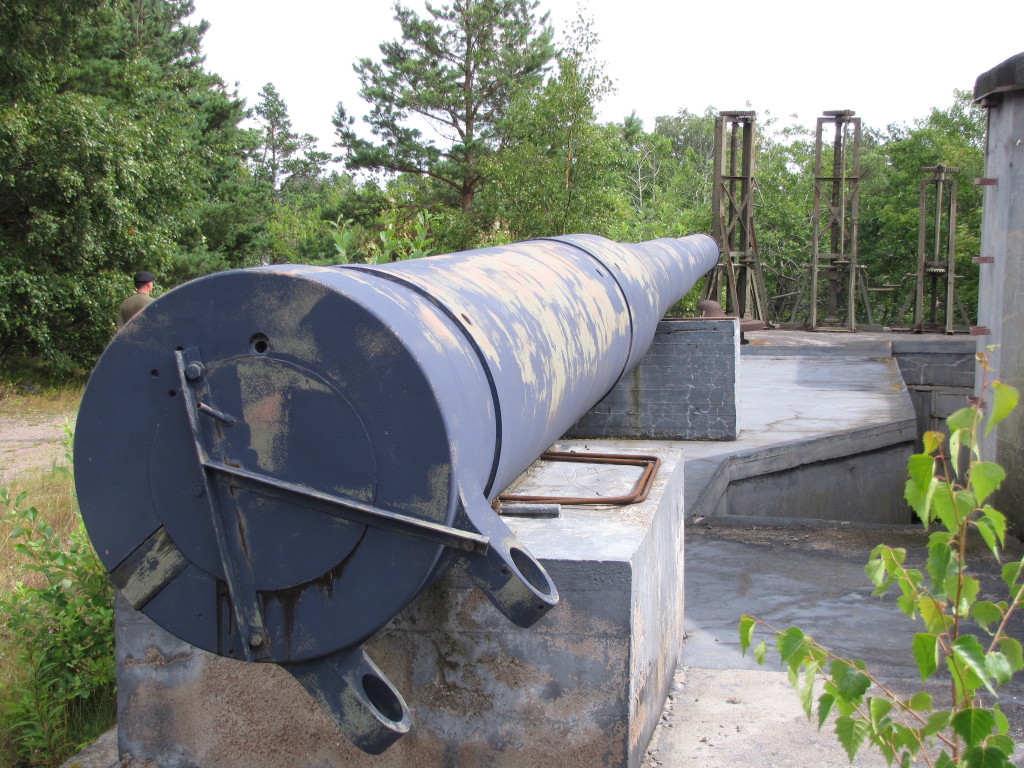
One of two spare 305mm barrels on Kuivasaari
And here’s a video of the Kuivasaari Coastal Artillery Fortress 12-inch turret gun reloading….On command the cradle charger is loaded with two charges and the shell, and then it all goes upstairs, where with the help of special device named the “priboynik” the gun is loaded sequentially, starting with the projectile, driven into the barrel. Then the lock is closed, the gun is angled to the desired elevation and … fire!
And just to give you an idea, here’s a Finnish Coastal Artillery 100 56 TK gun crew having a bit of target practice.
And for those interested in their Finnish Artillery, a number of other examples of guns can be found in the Kuivasaari Coastal Artillery Fortress …
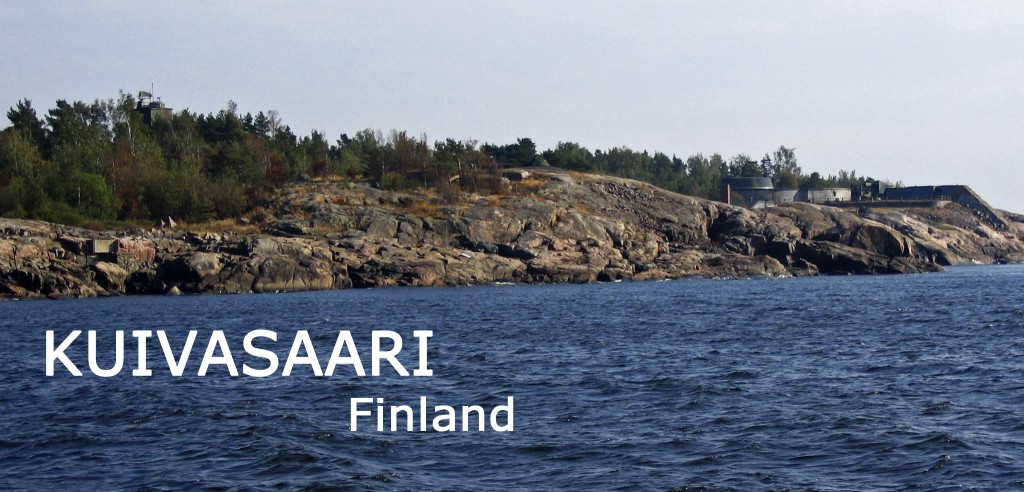
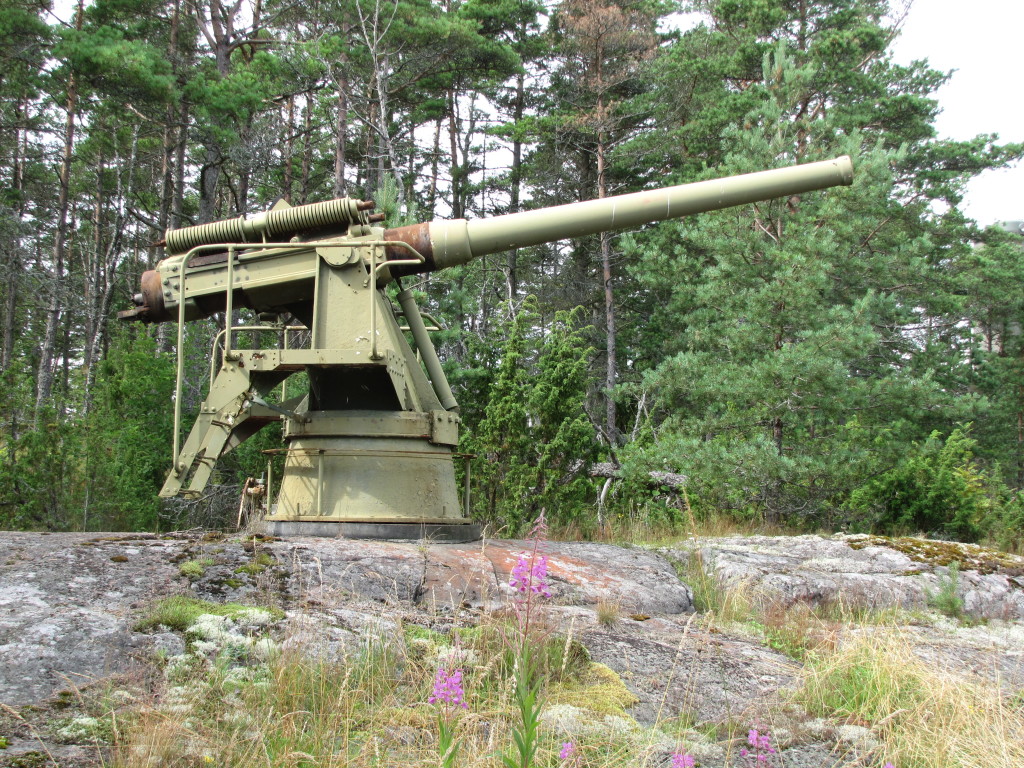
120mm Canet-tykki. 120 mm 45 calibre Canet coastal gun in Kuivasaari. This gun has been modified from the original 1892 model, including rotating the gun 180 degrees so that the recoil system is on top of the barrel to increase elevation. This gun was used by the Finnish coastal artillery school until 1993.
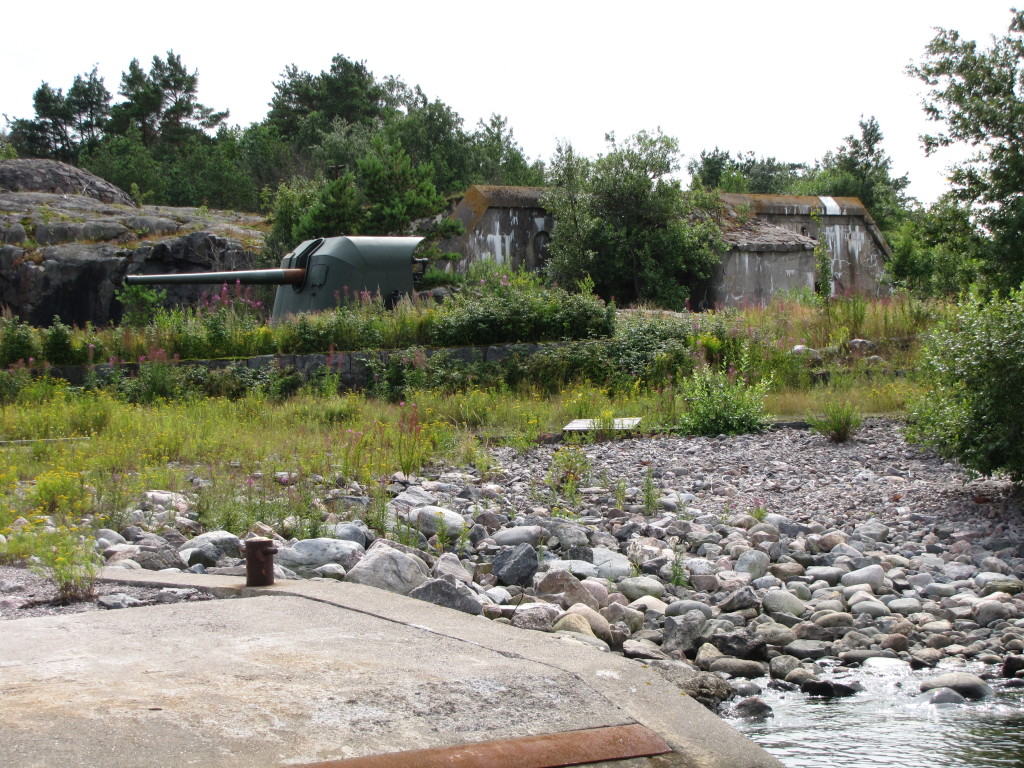
130 mm 50 calibre coastal gun on display in front of the Kuivasaari mine control bunker from World War I. This gun is a Soviet Union 130 mm gun B-13 that was captured by the Finns in World War II. 130 mm B-13. Vanha ensimmäisen maailmasodan aikainen ammusvarasto taustalla.
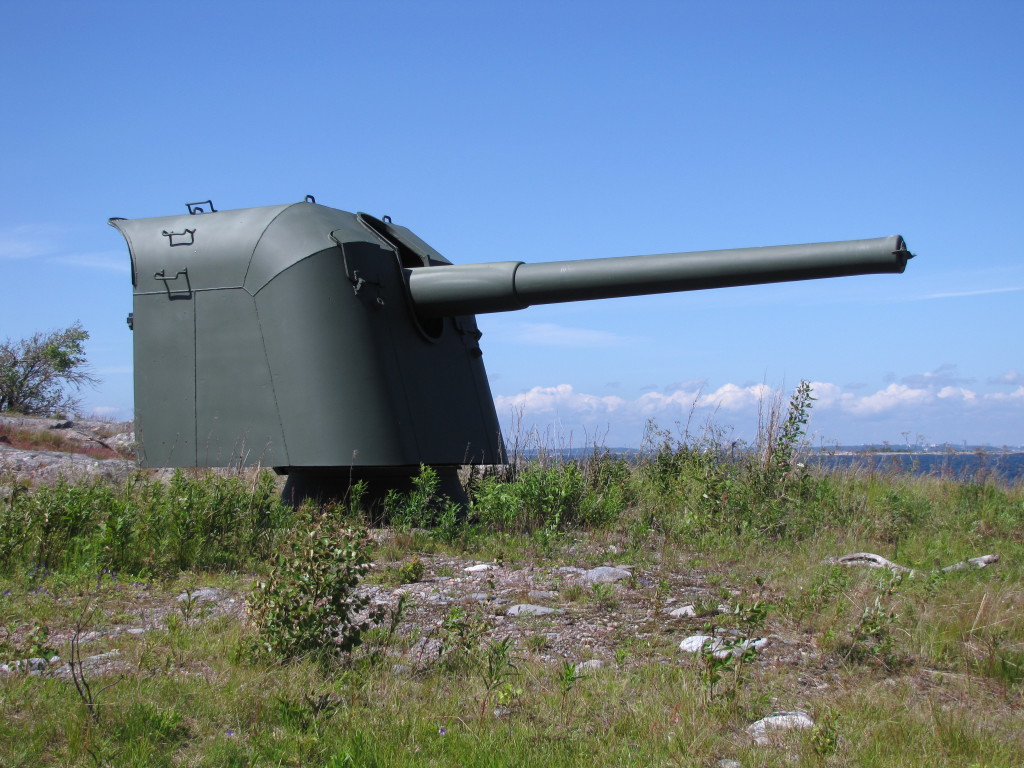
152/46 VLo, or 152 mm 46 caliber Vickers coastal gun on Lokomo carriage on display in Kuivasaari. A Finnish conversion of BL 6 inch Mk VII field gun, one of seven purchased in 1940, into static coastal gun. The gun shield is from a captured Soviet 130 mm/50 B13 Pattern 1936 gun. Photo courtesy of Northern Fortress website (www.nortfort.ru)
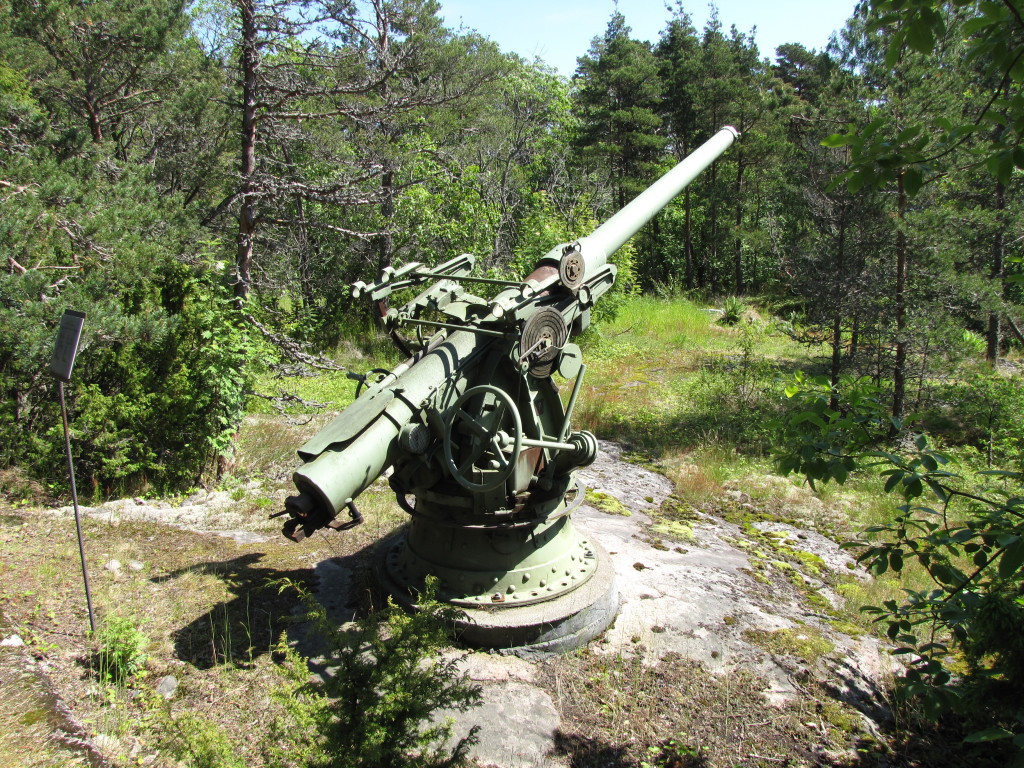
75/50 O – Imperial Russian Canet 75 mm/50 1892 naval gun on Obukhov carriage on Kuivasaari.
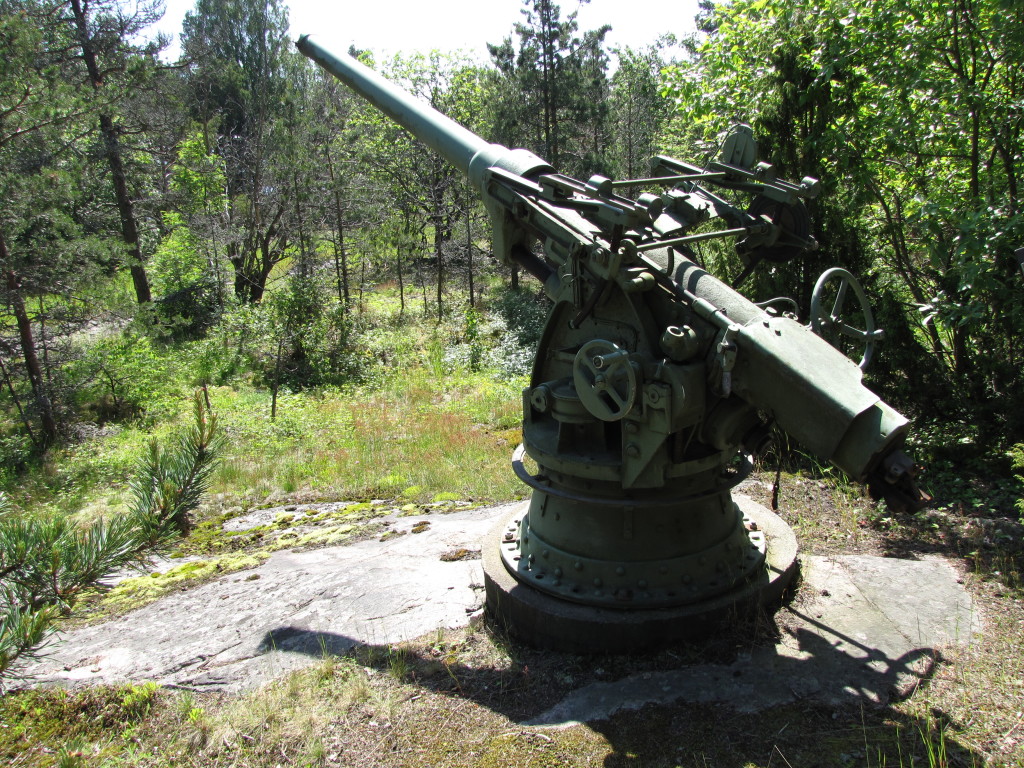
Another view of the Imperial Russian Canet 75 mm/50 1892 naval gun on Obukhov carriage on Kuivasaari.
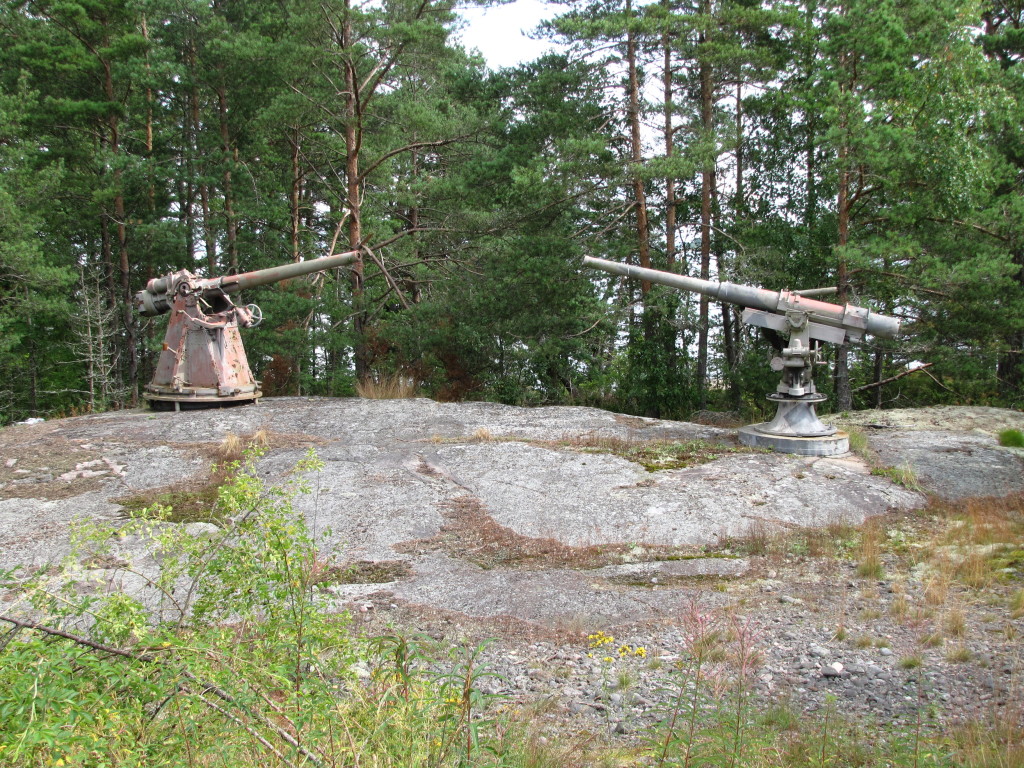
British QF 3 inch 20 cwt anti-aircraft gun and Imperial Russian 75 mm model 1892 Canet gun on 152 mm naval howitzer carriage in Kuivasaari. Britain donated 24 QF 3 inch 20 cwt guns to Finland during Winter War, and they were used as coastal guns after World War 2. 75 mm Canet on howitzer carriage could be used as anti-aircraft gun, and eight guns were modified in Finland to fire 76 mm Bofors shells.
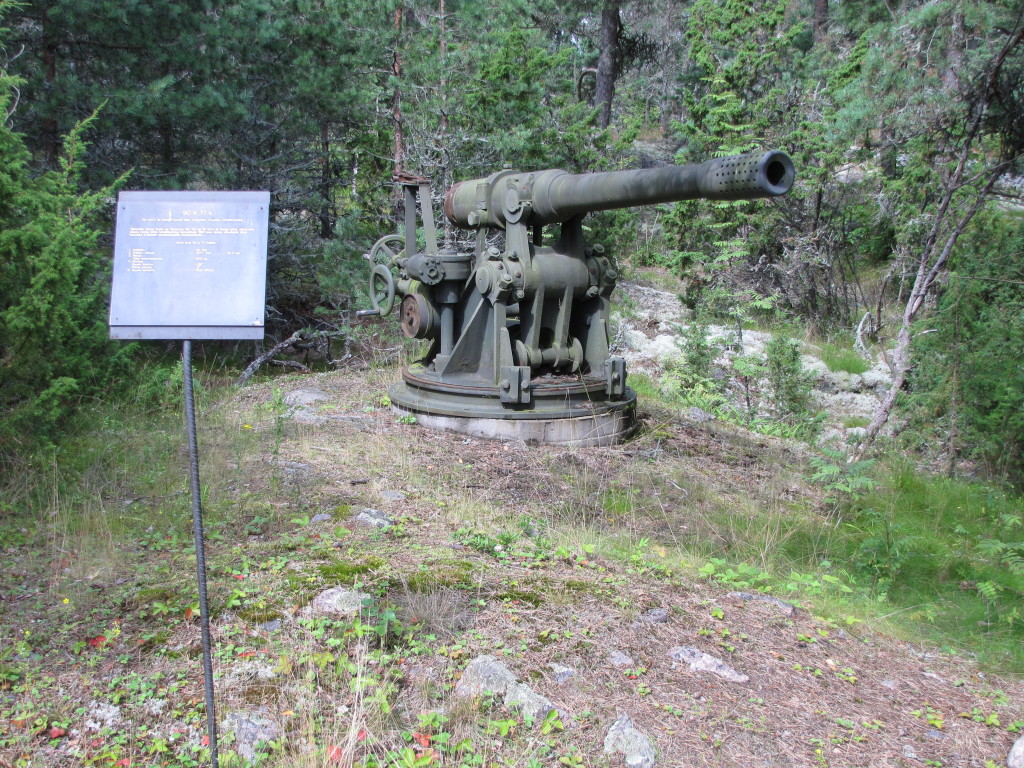
De Bange 90 mm cannon converted to bunker gun in Kuivasaari. Donated by France to Finland during Winter War, converted to bunker guns late in World War 2 or after. Finally used as coastal artillery training guns until the 1960s.
If you have the opportunity, the Kuivasaari Coastal Artillery Fortress is well worth visiting. Not least for the opportunity to see one of the last working 305mm/12 inch battleship guns in the world.
 Copyright secured by Digiprove © 2016 Alternative Finland
Copyright secured by Digiprove © 2016 Alternative Finland


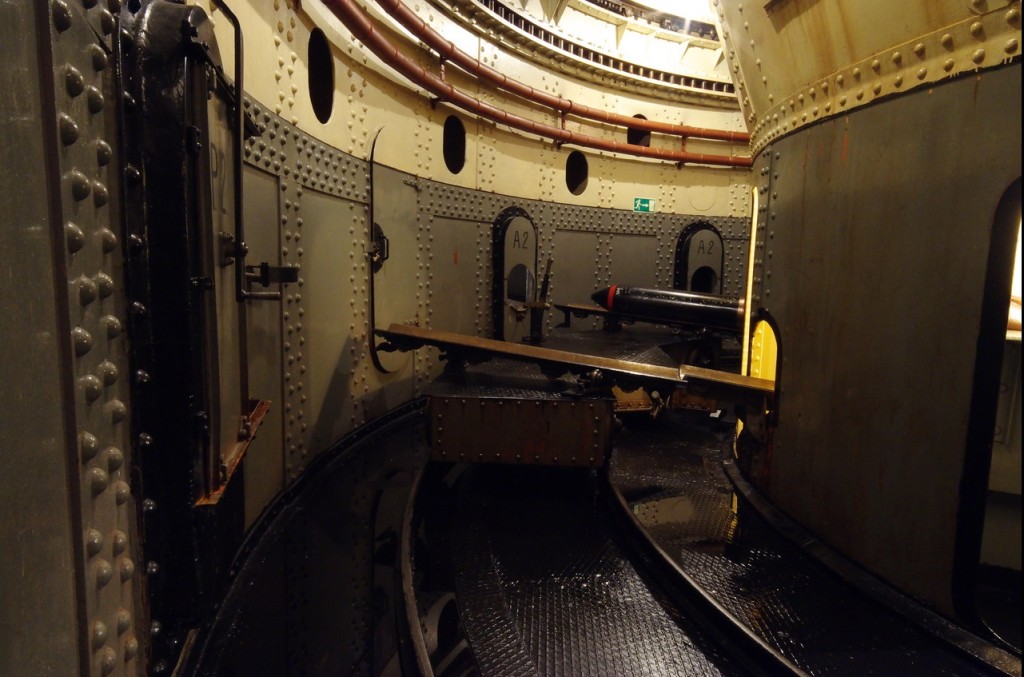

2 Responses to Kuivasaari Coastal Artillery Fortress – standing guard over Helsinki